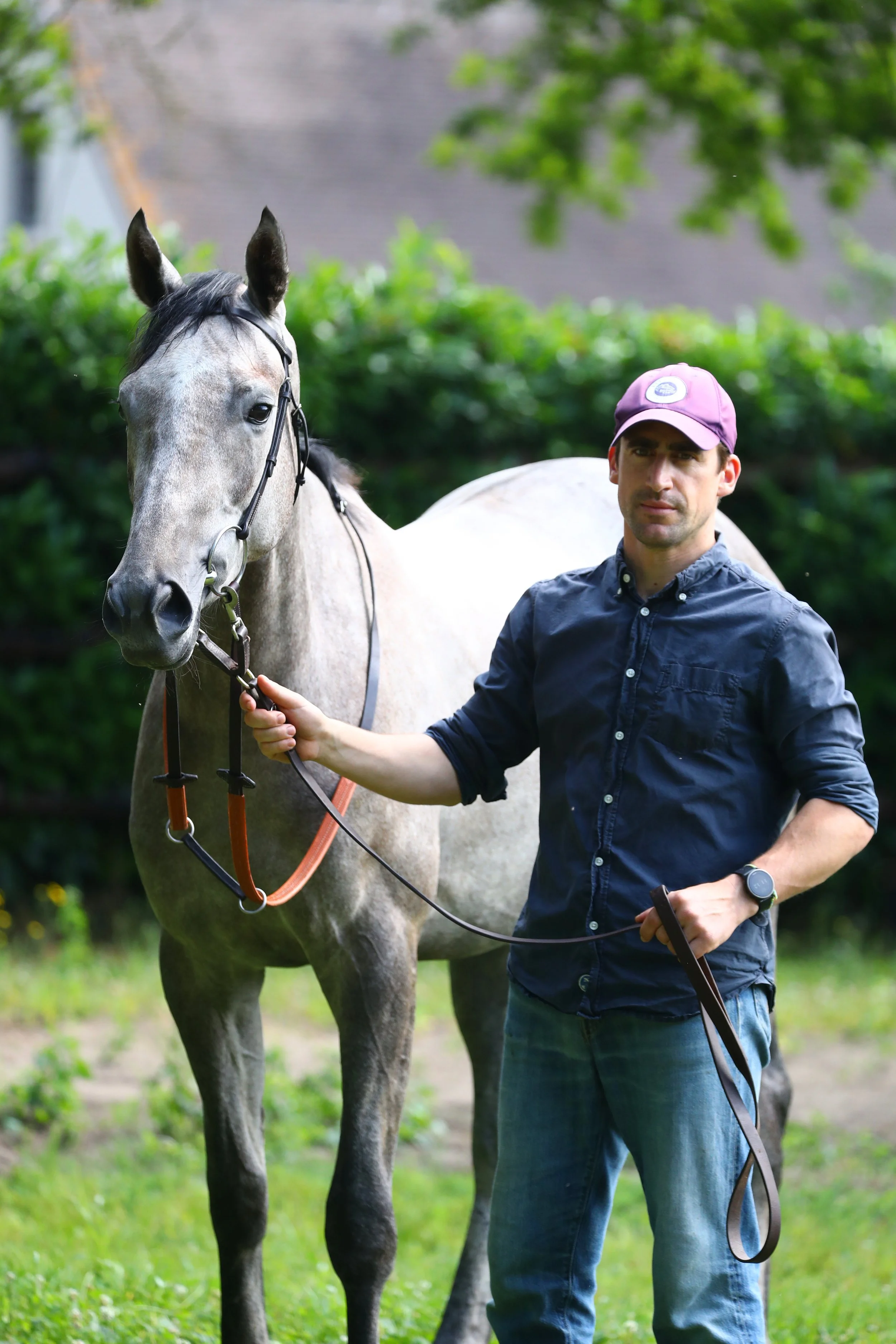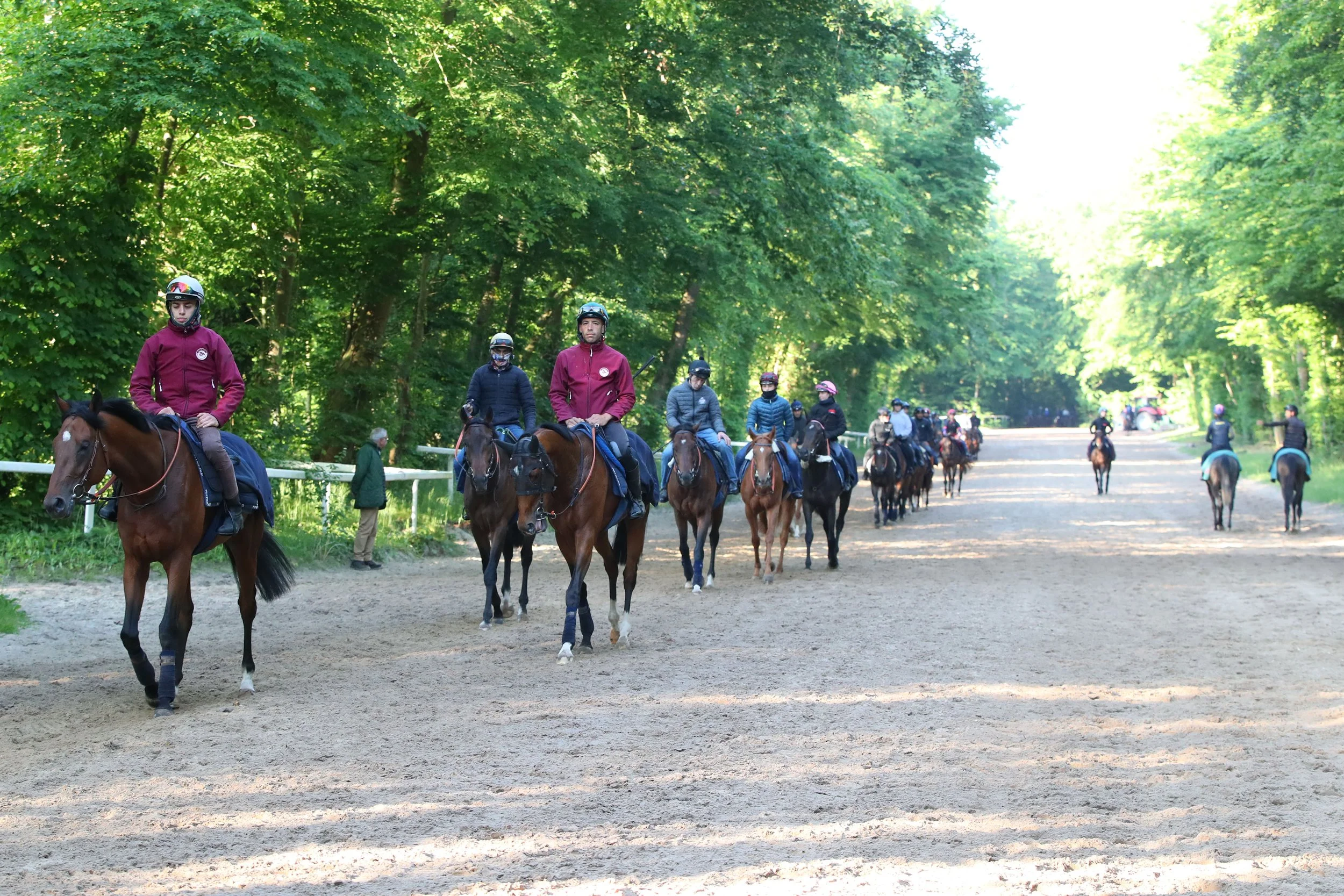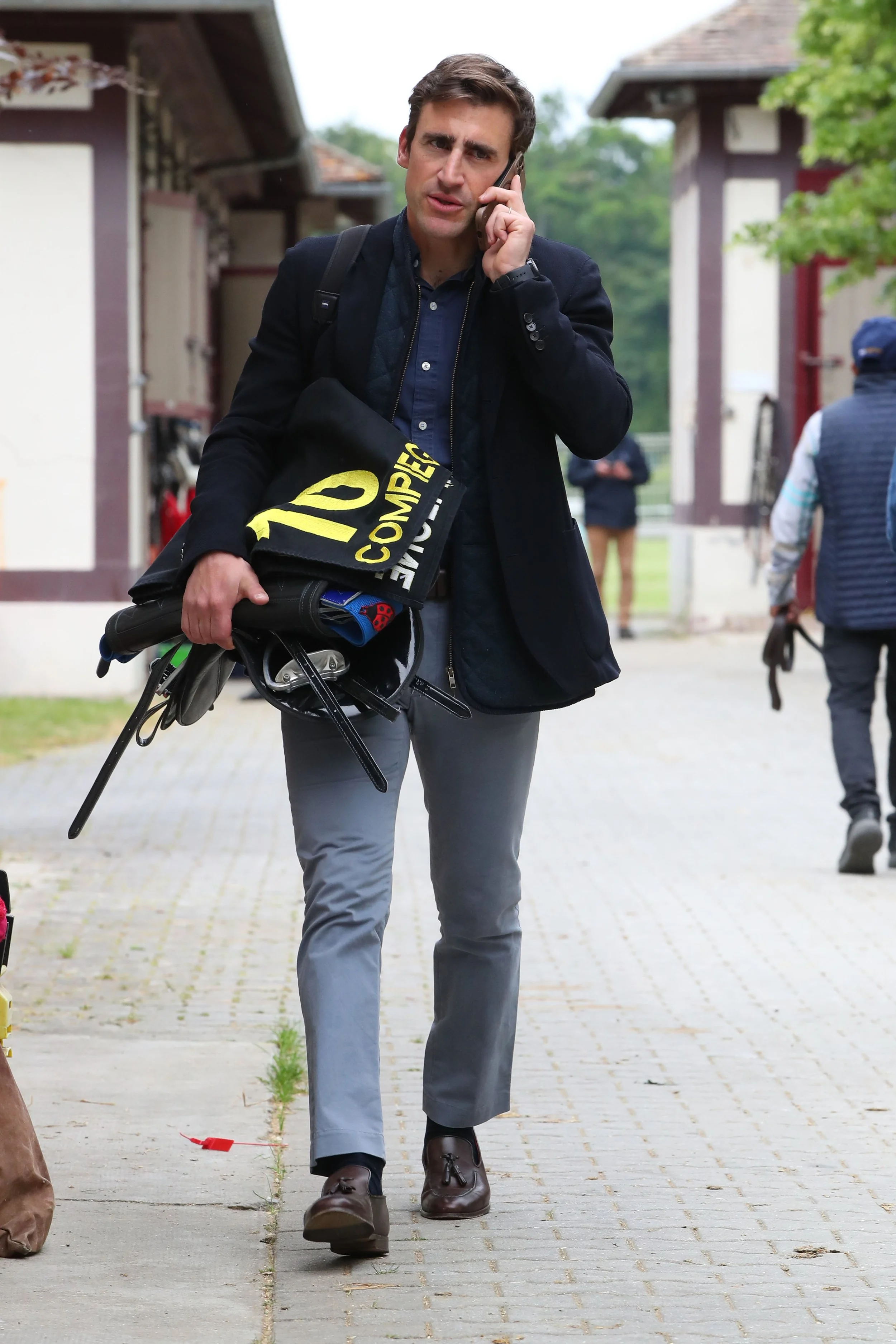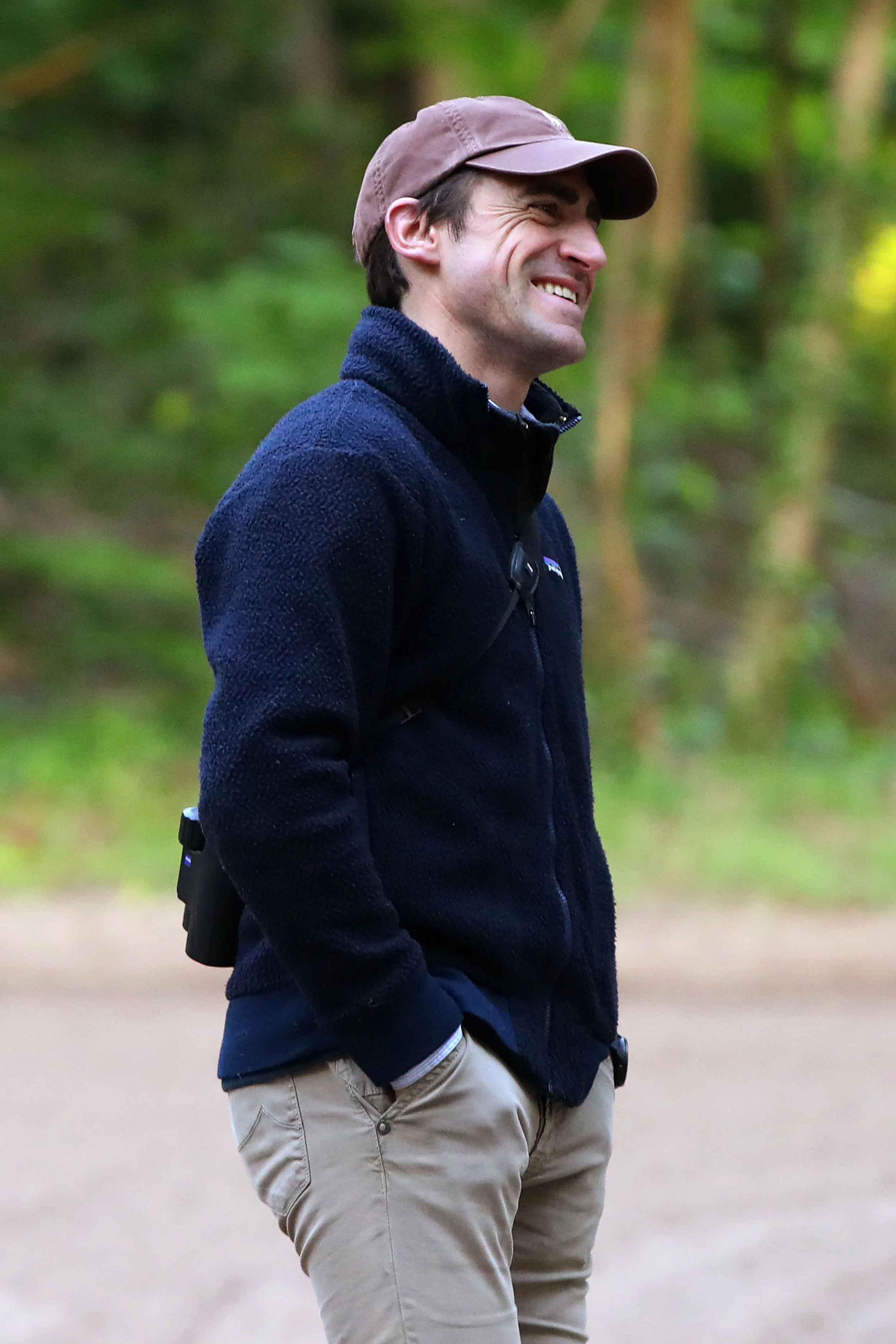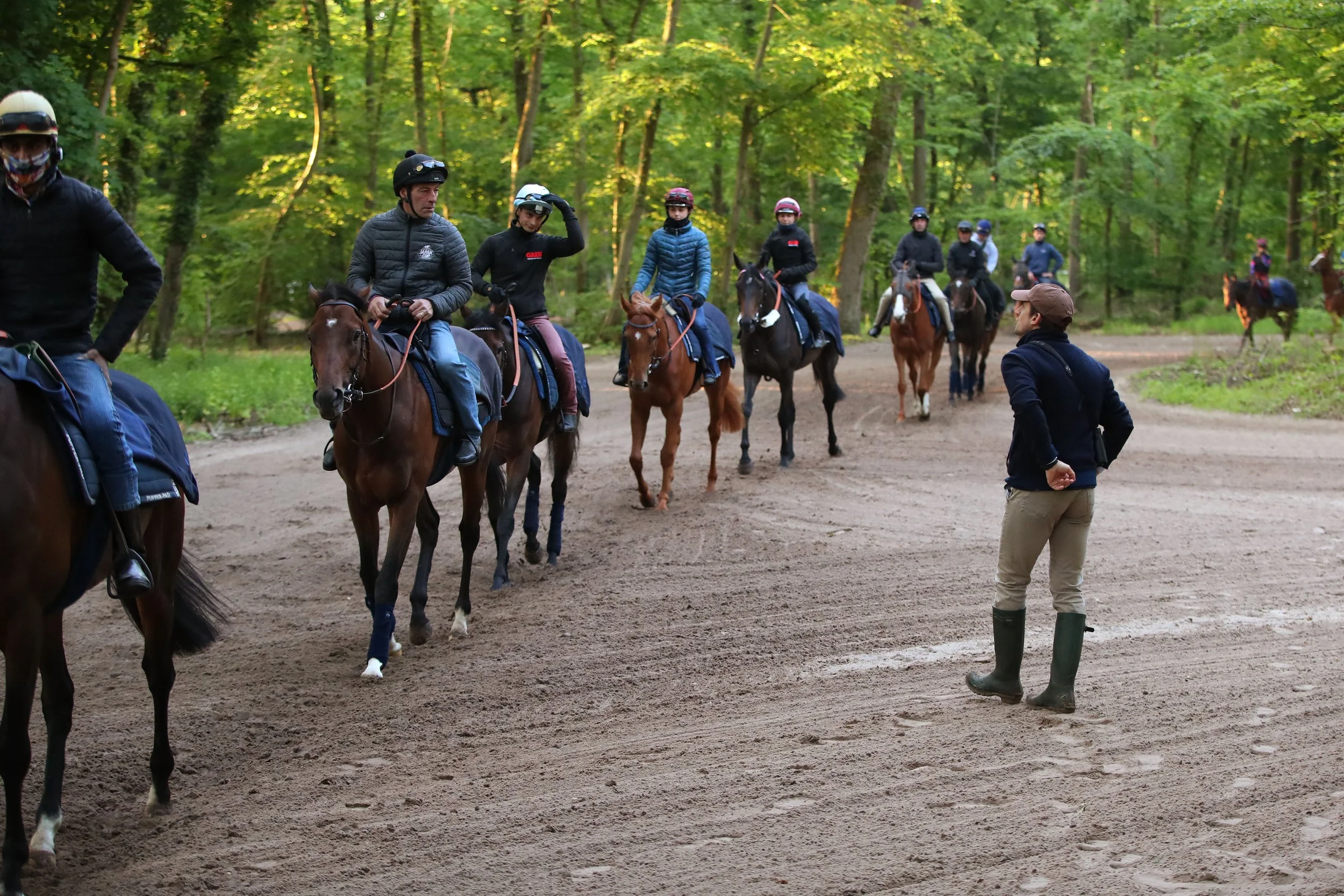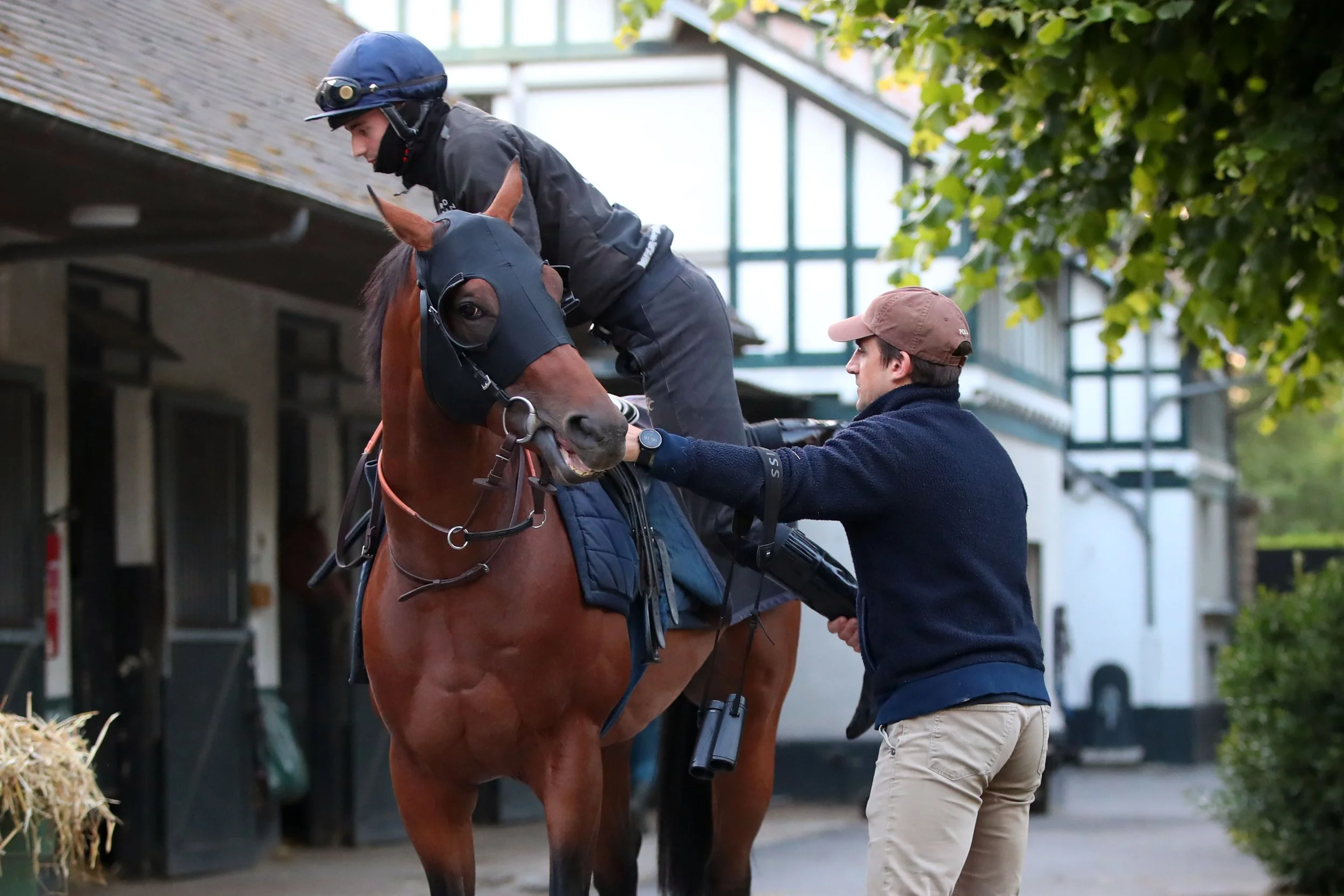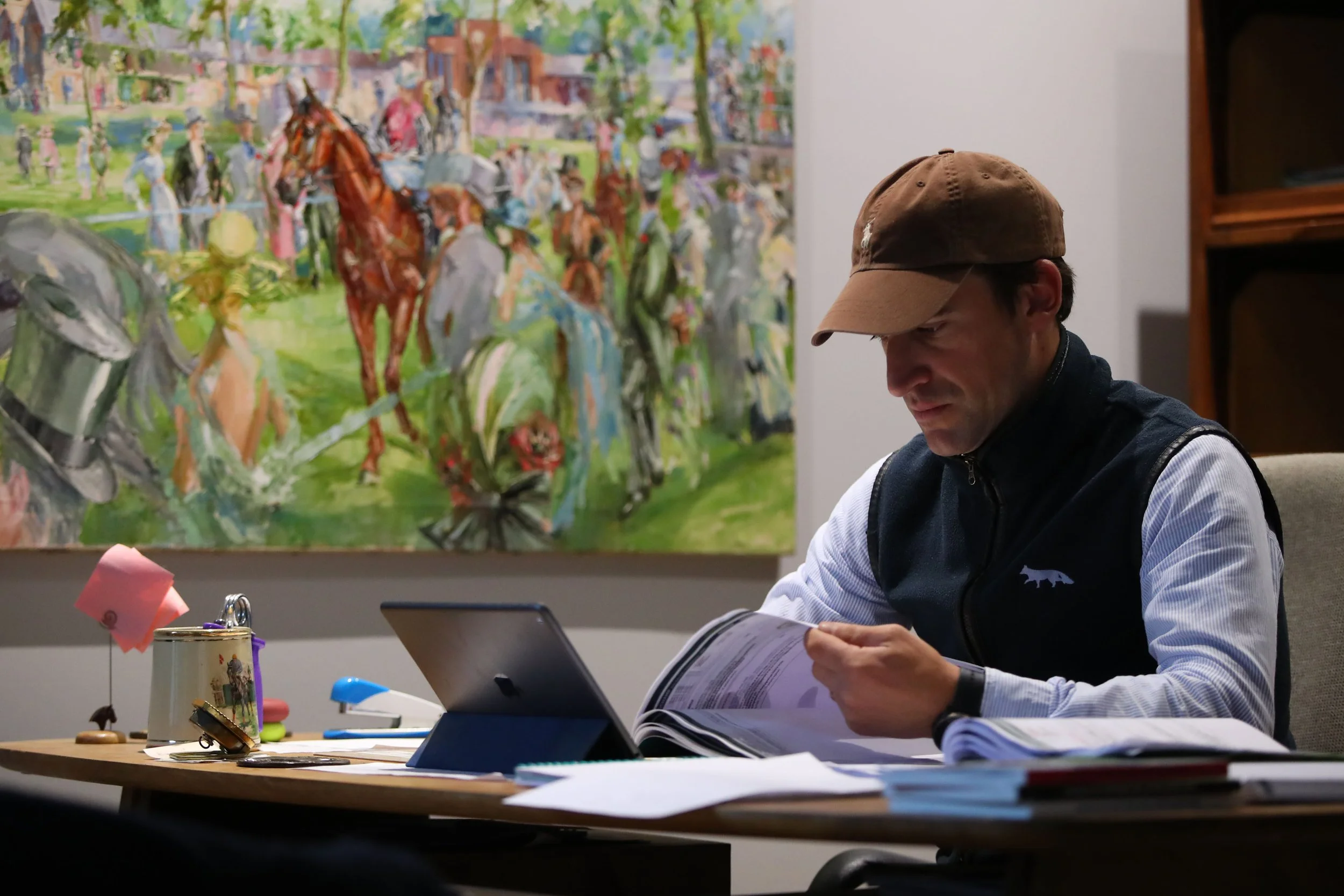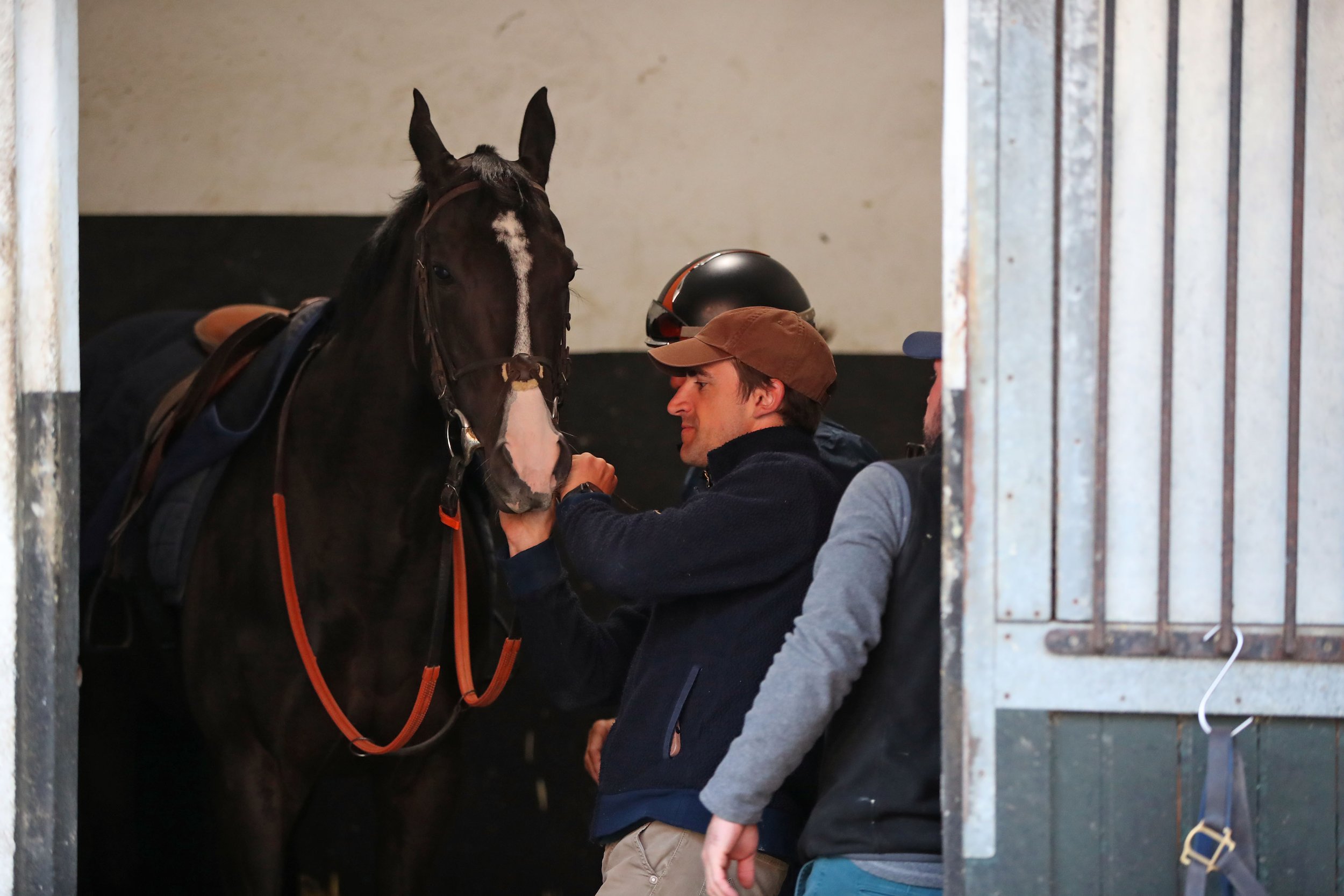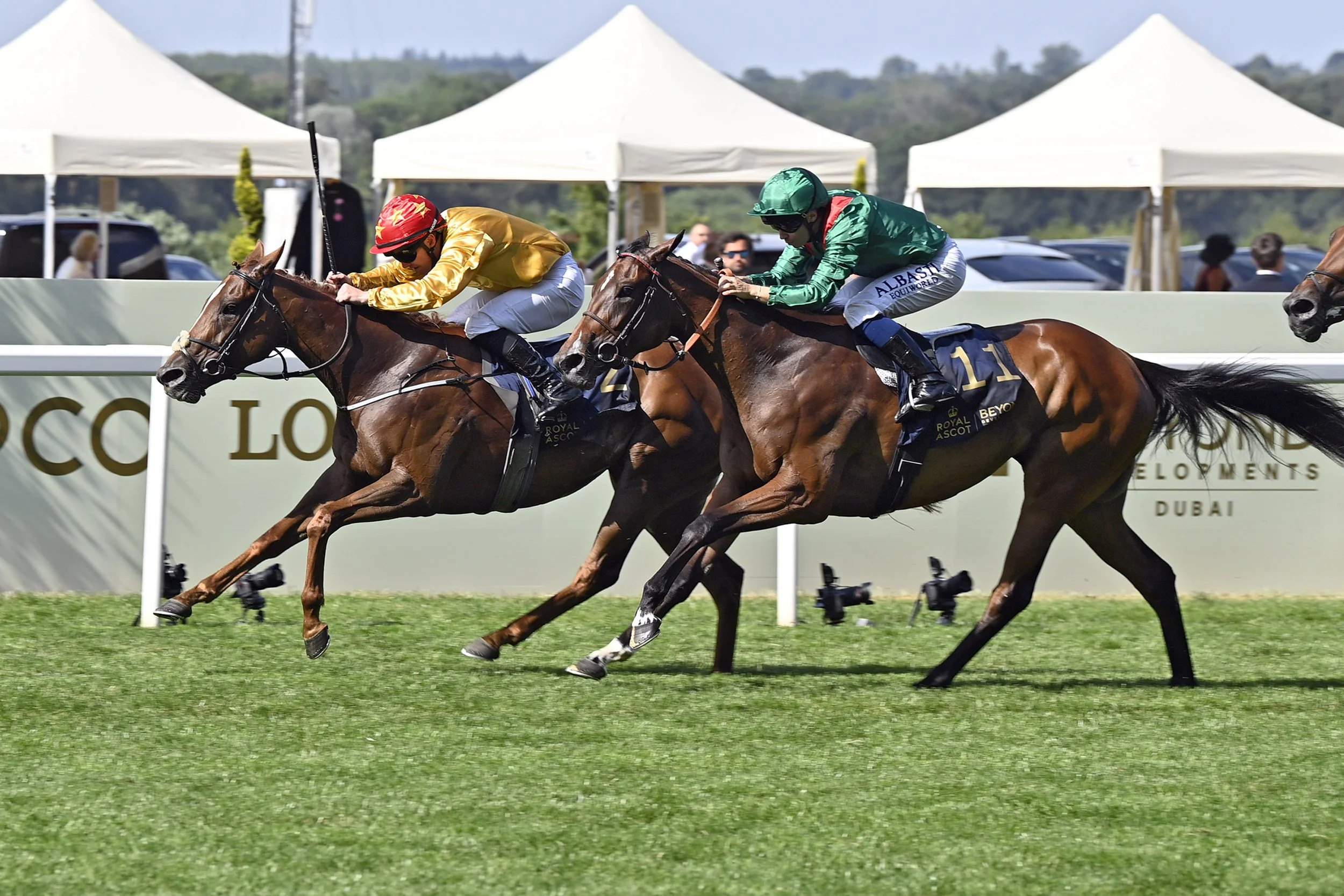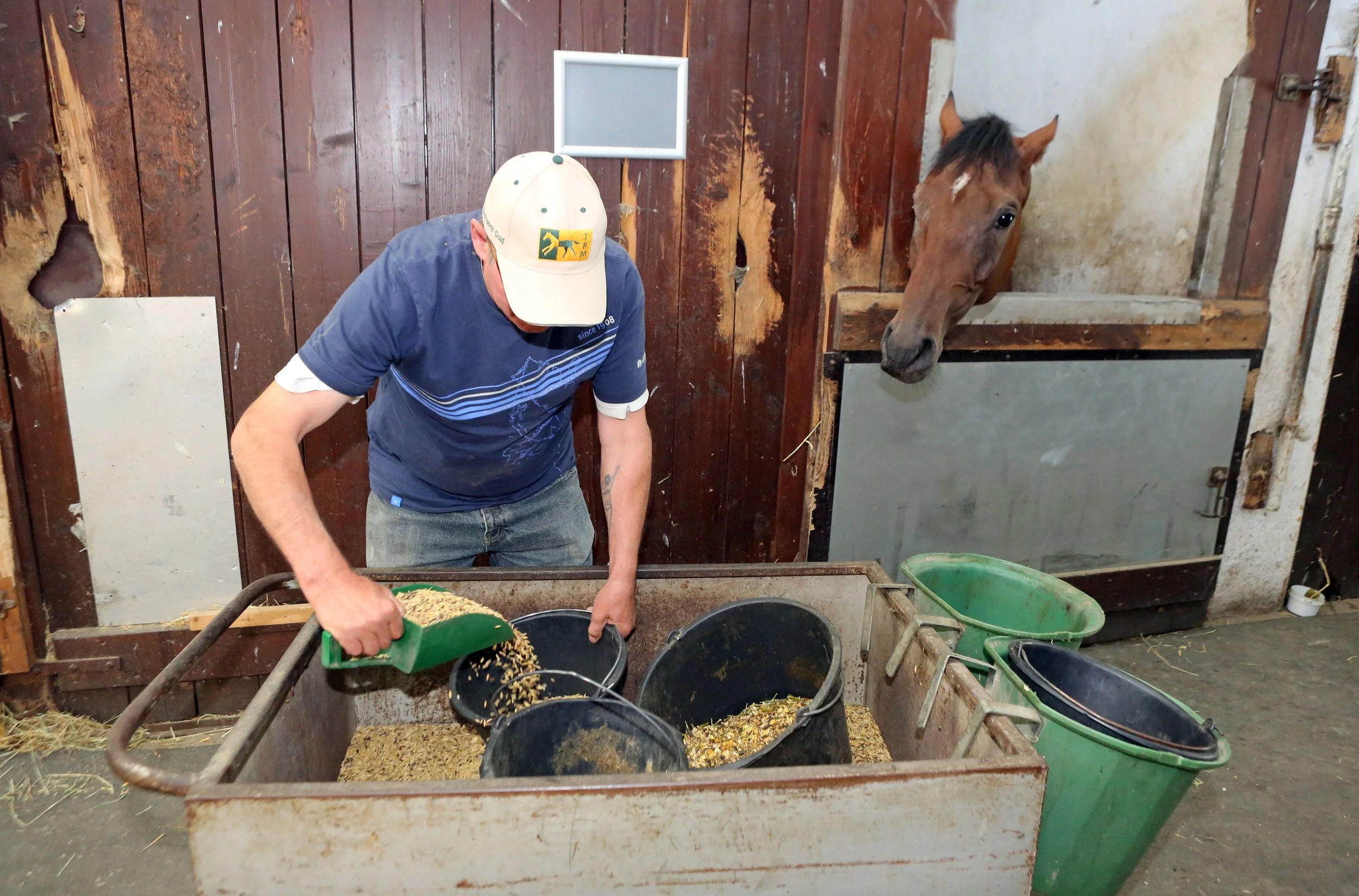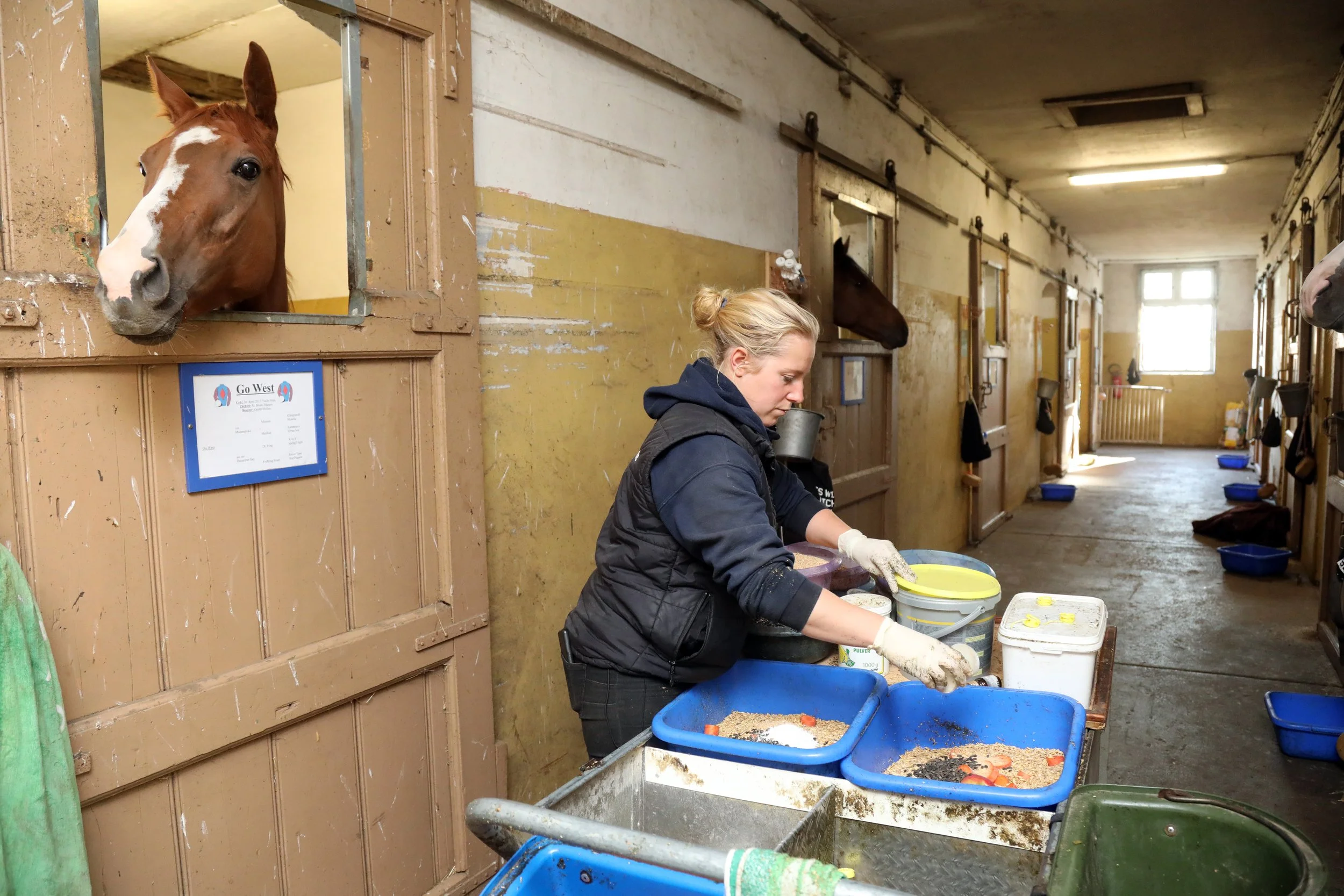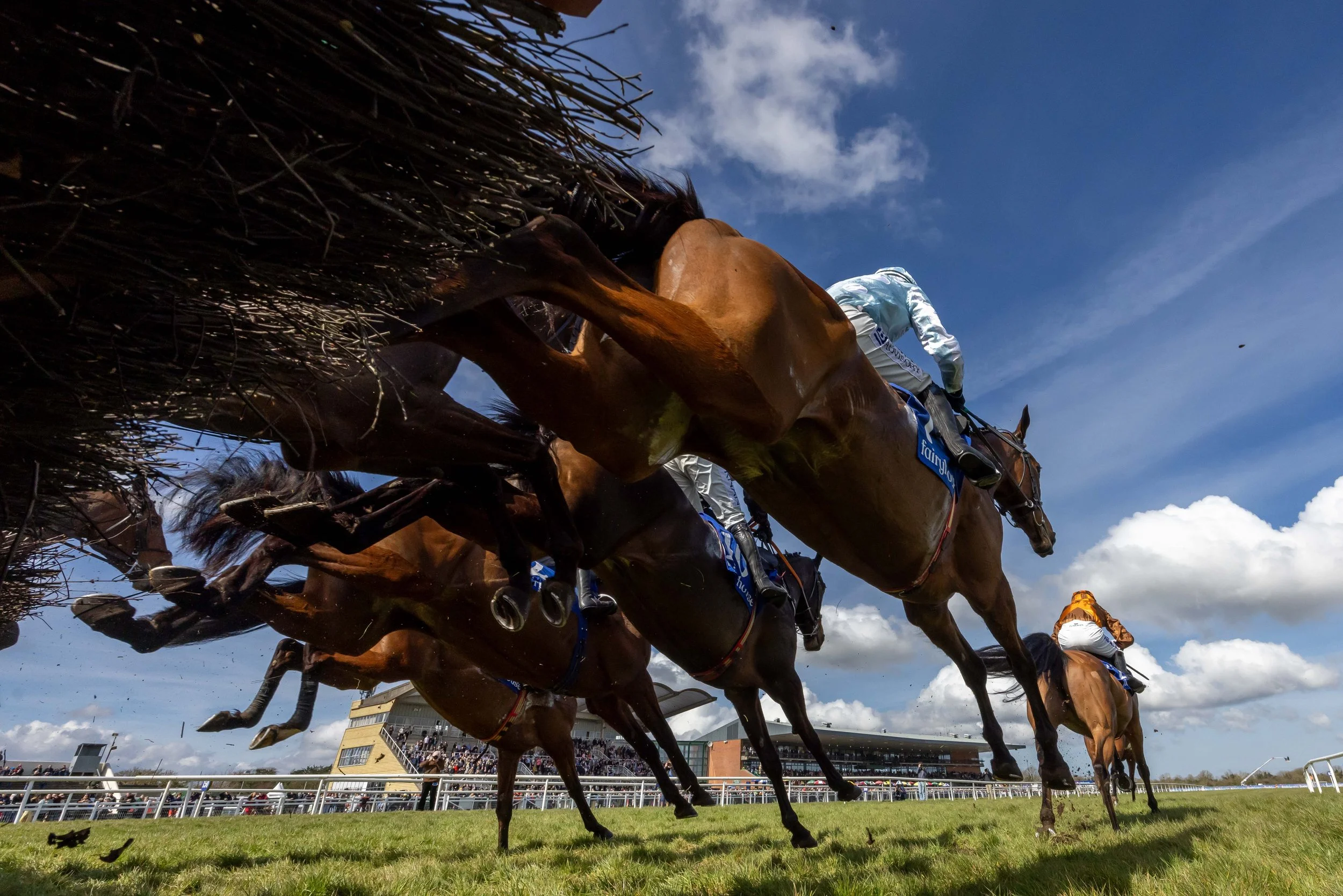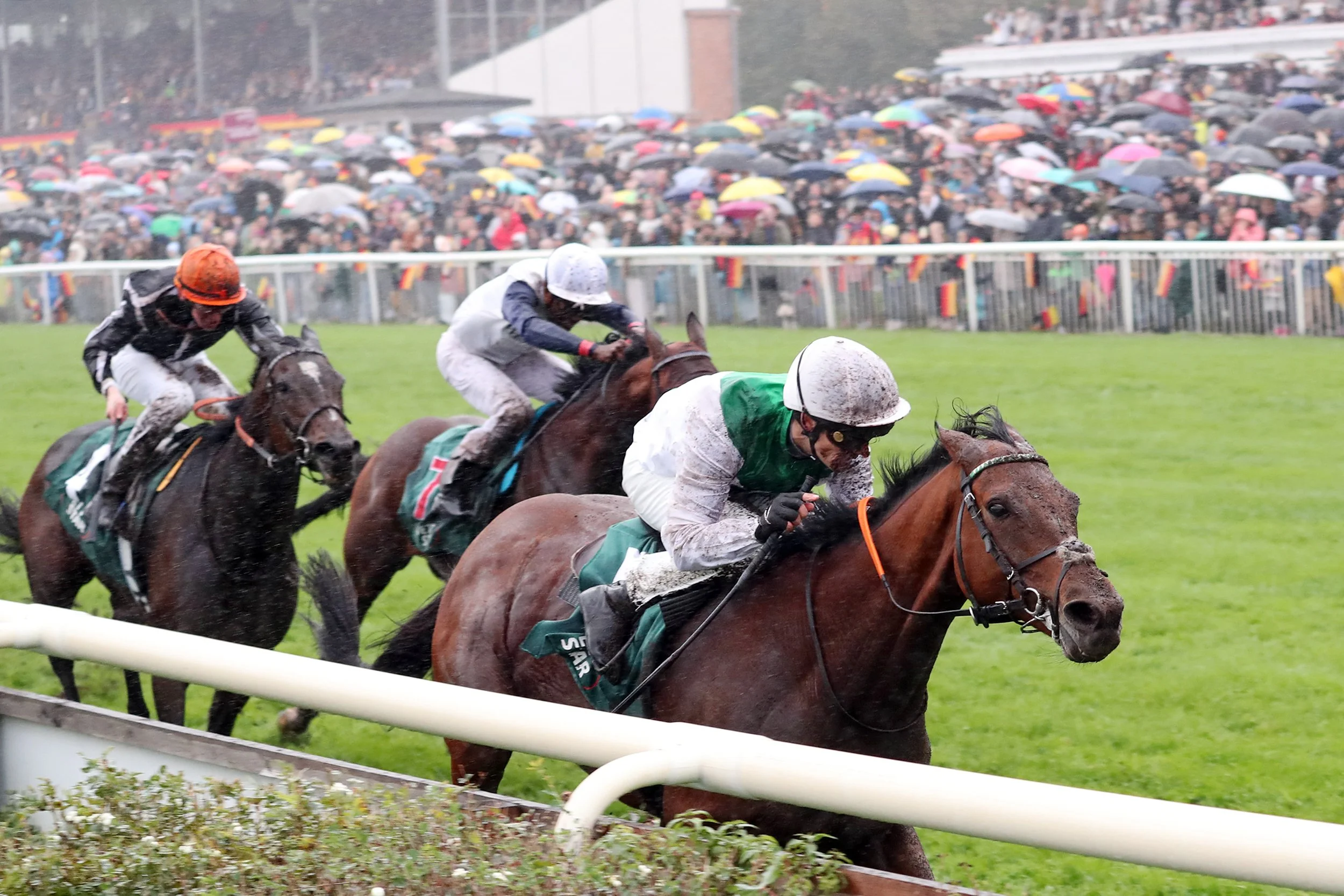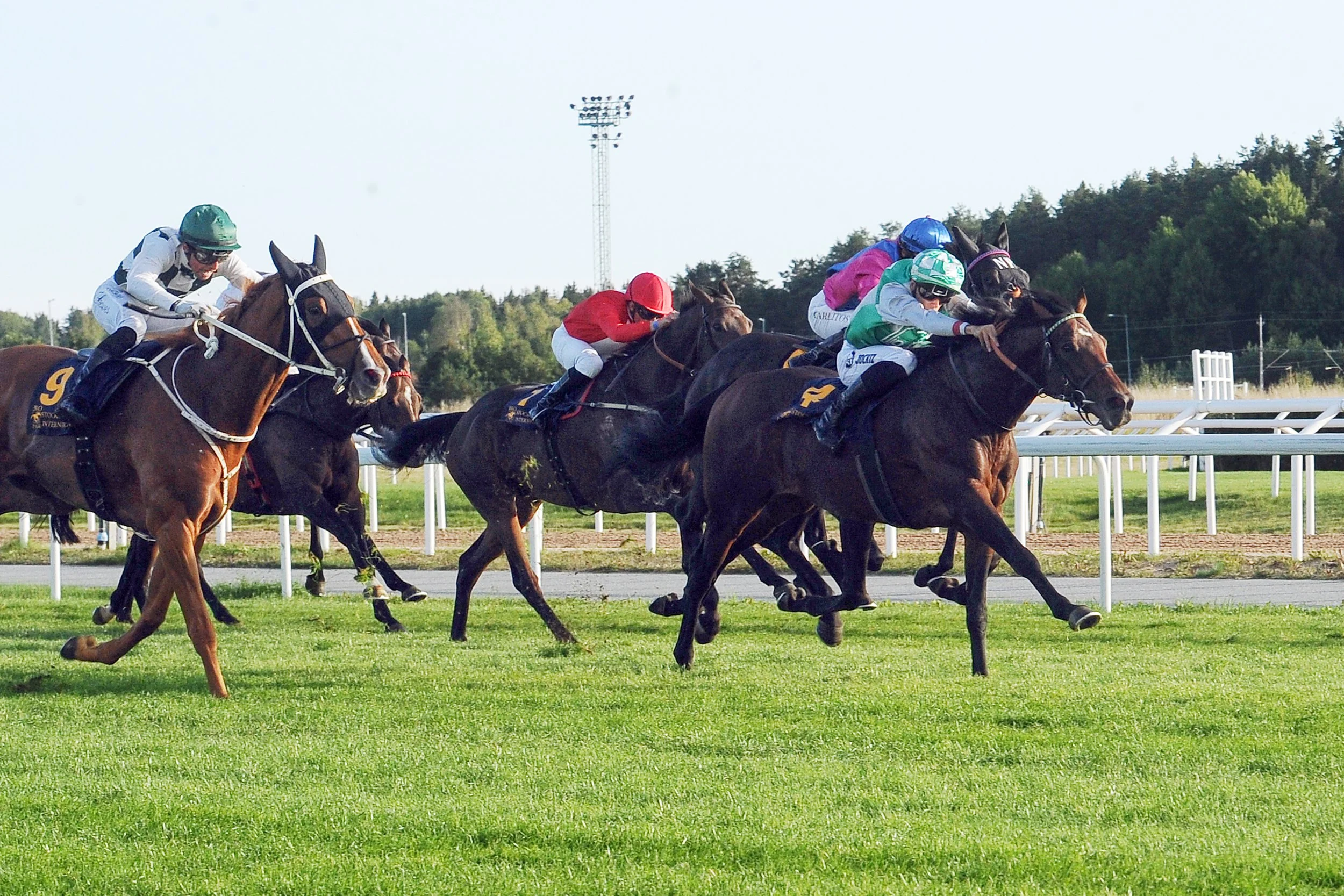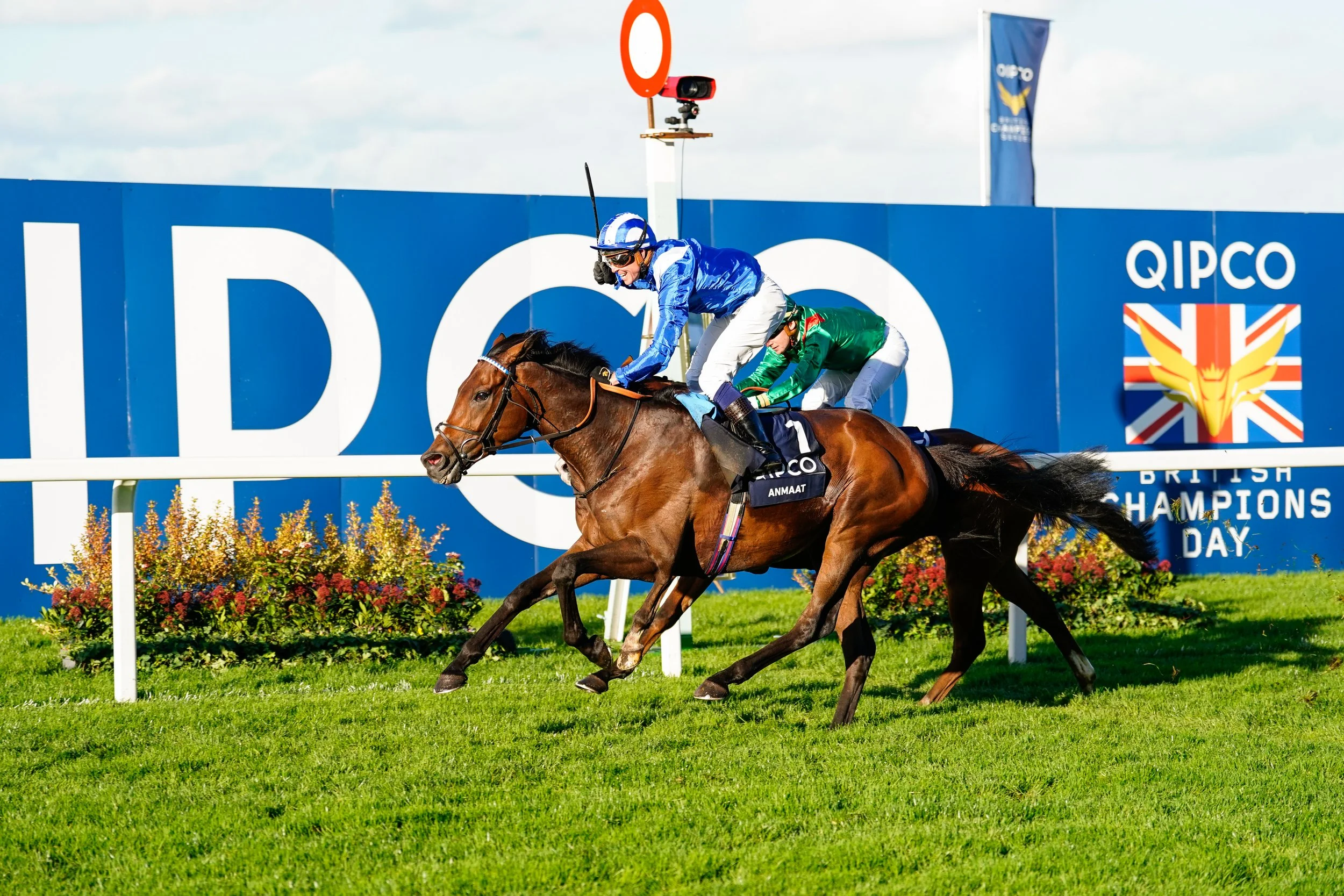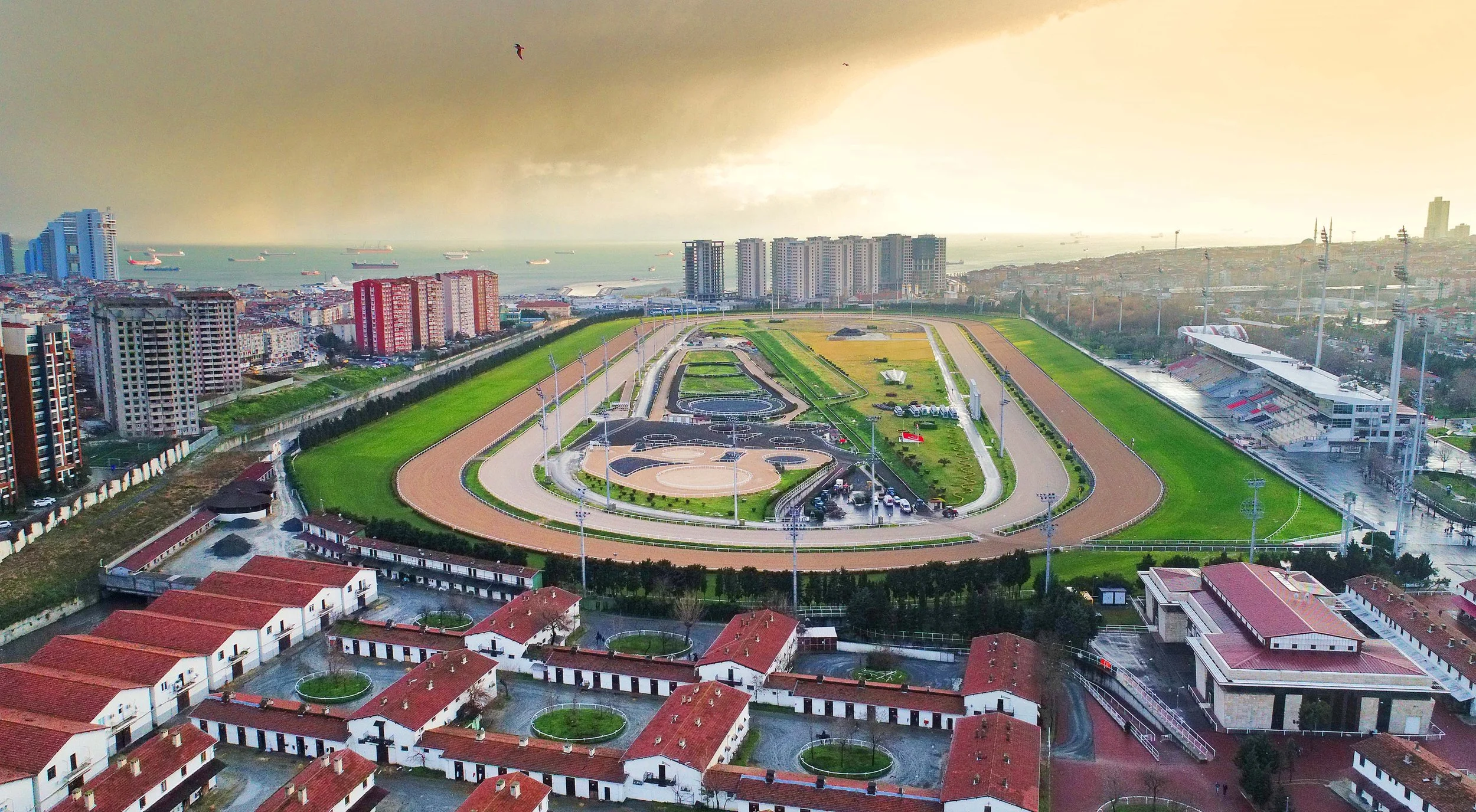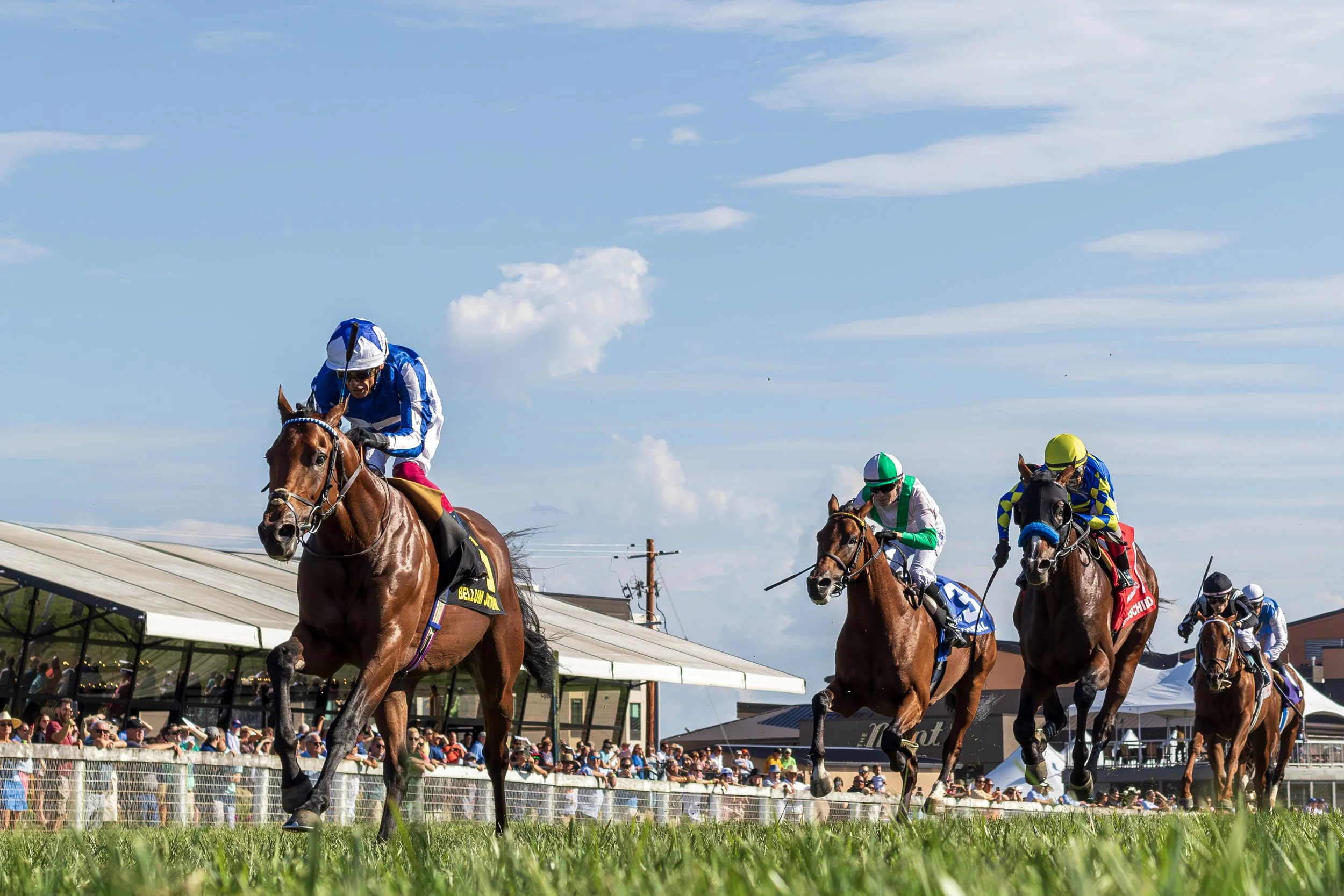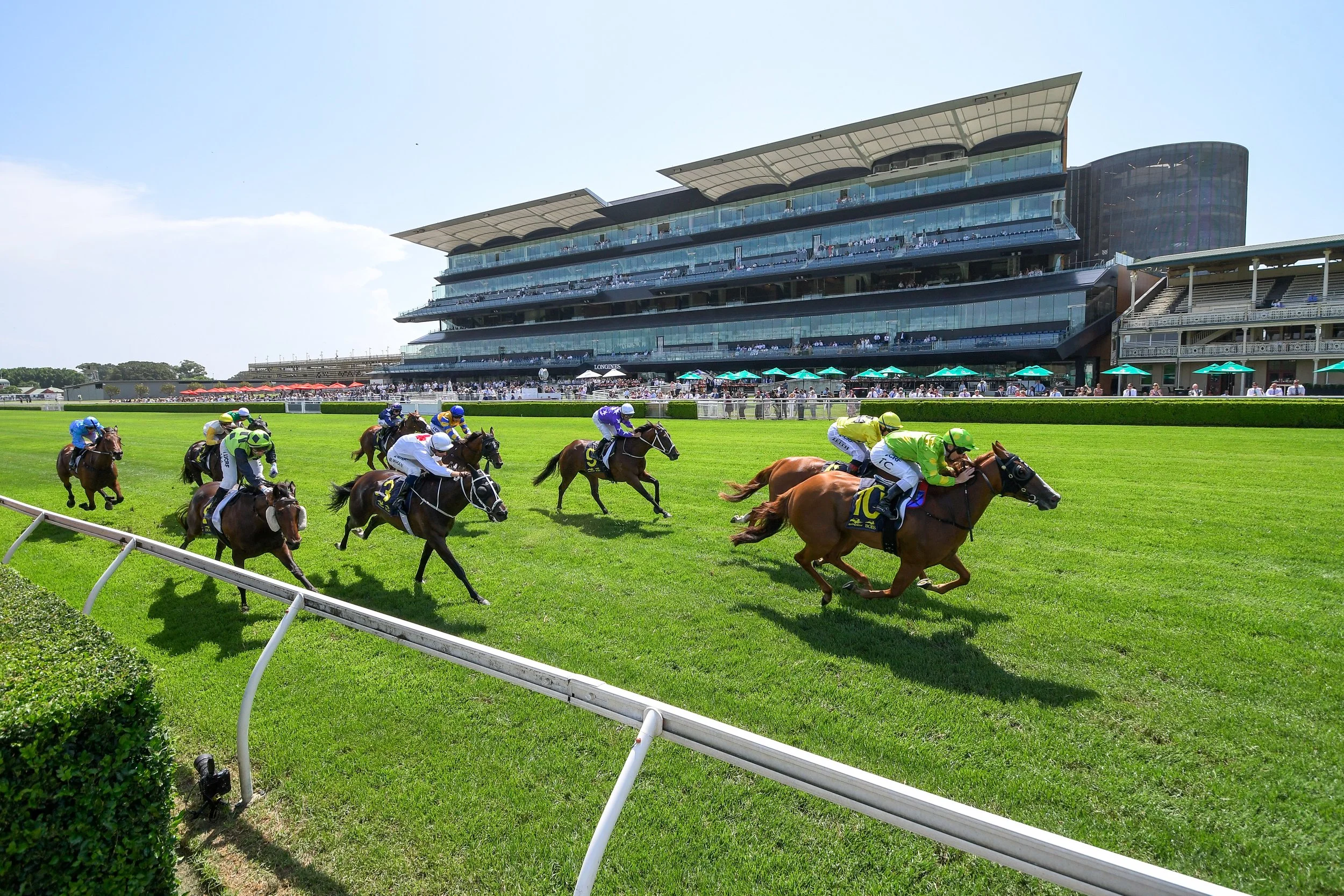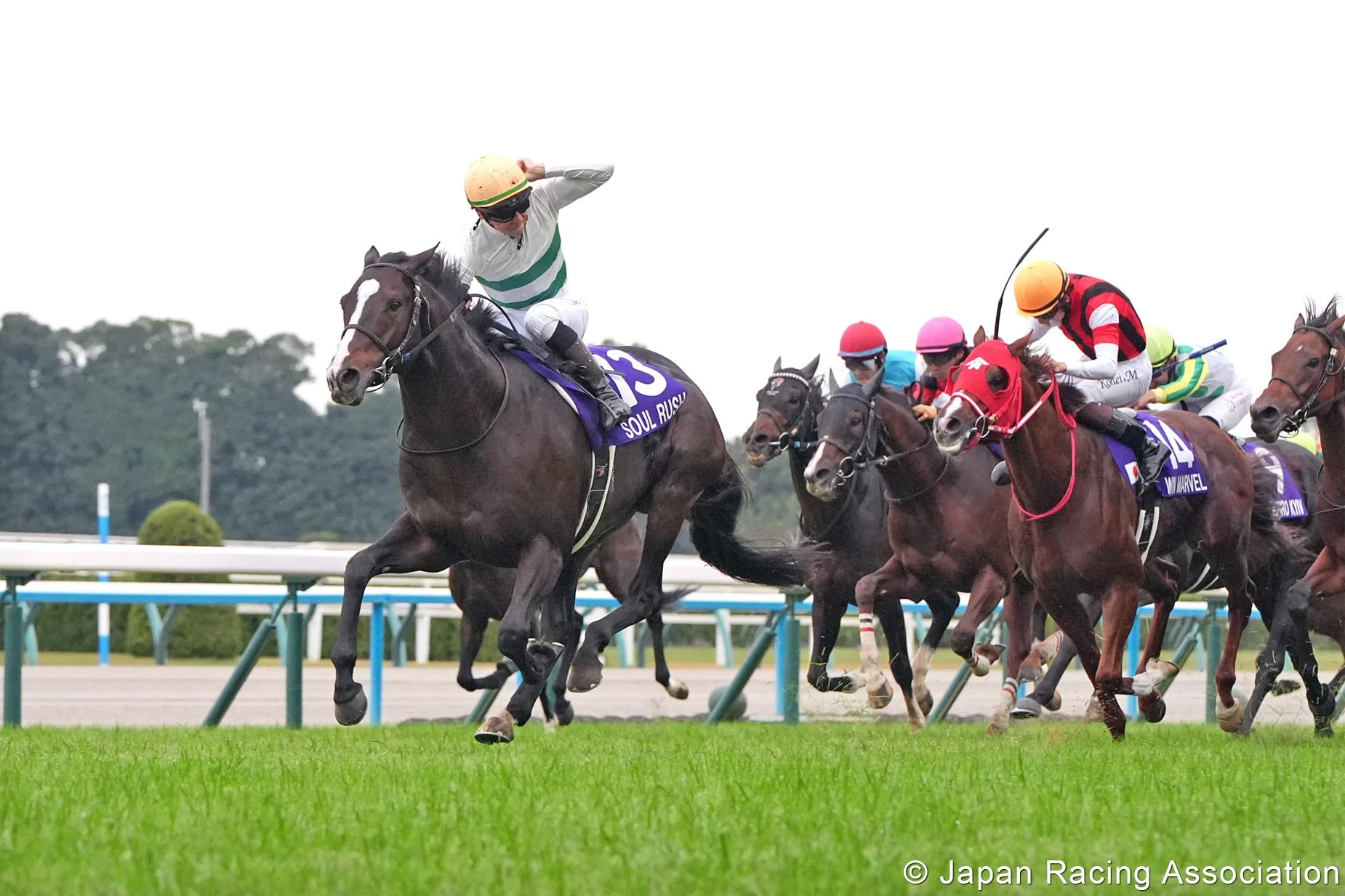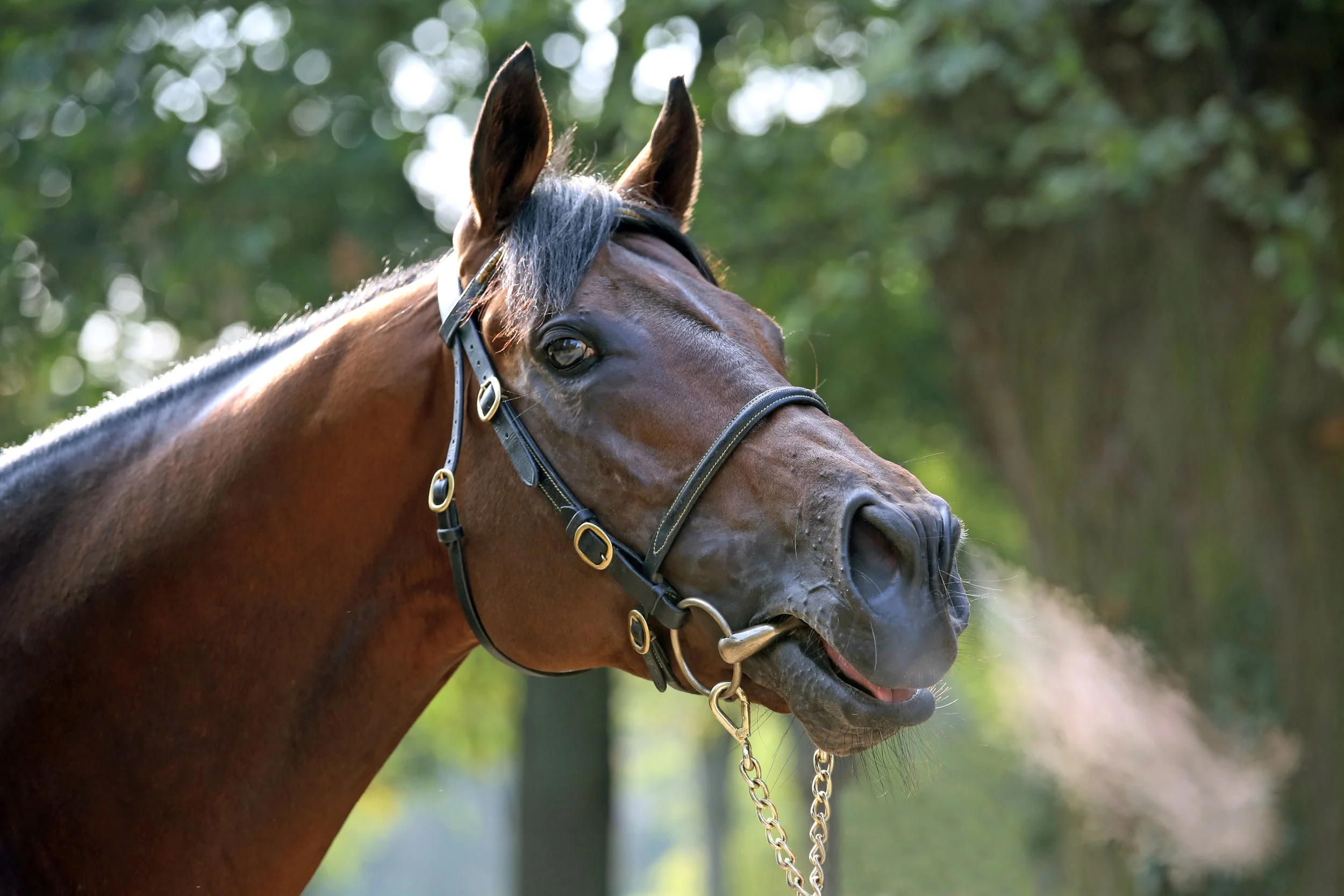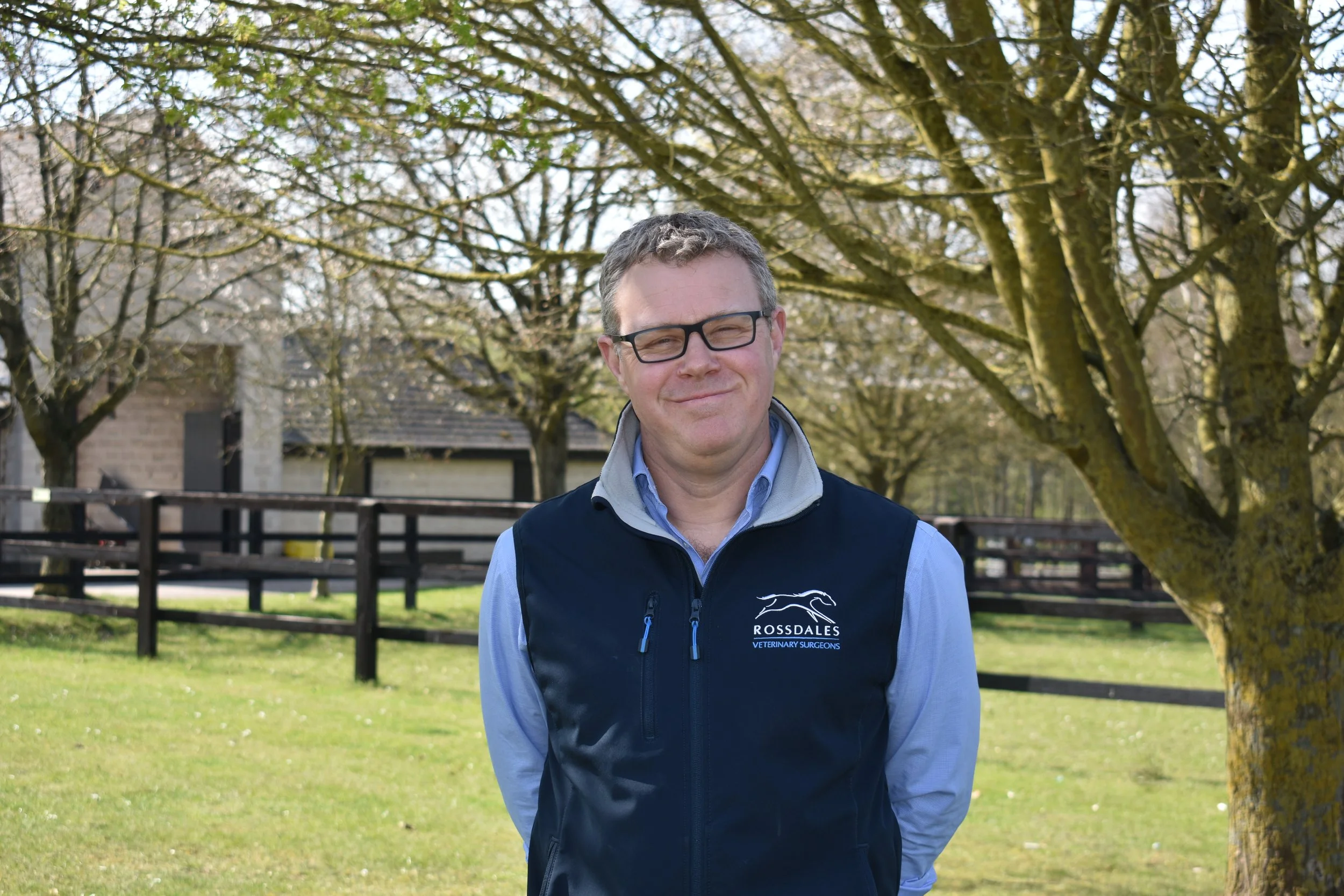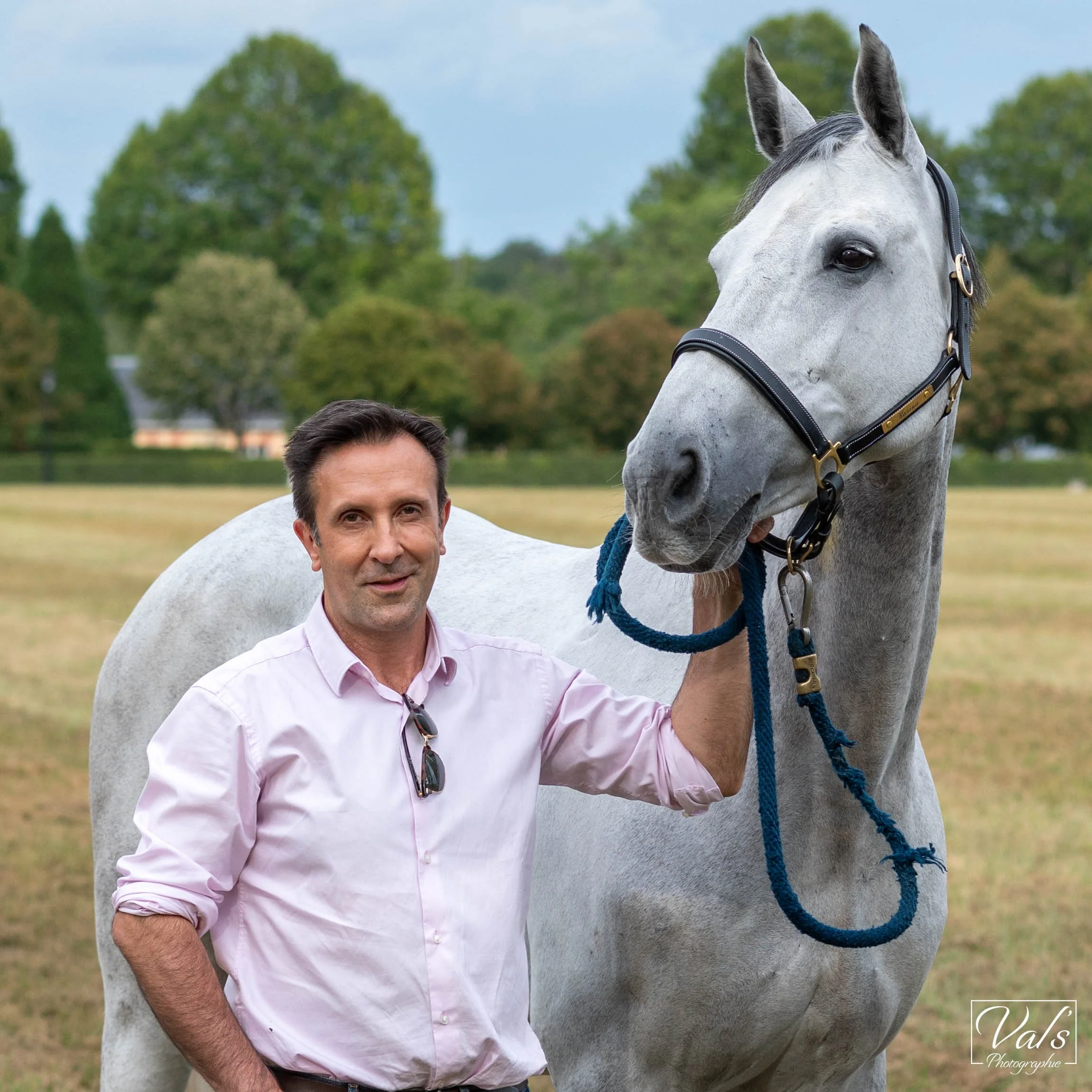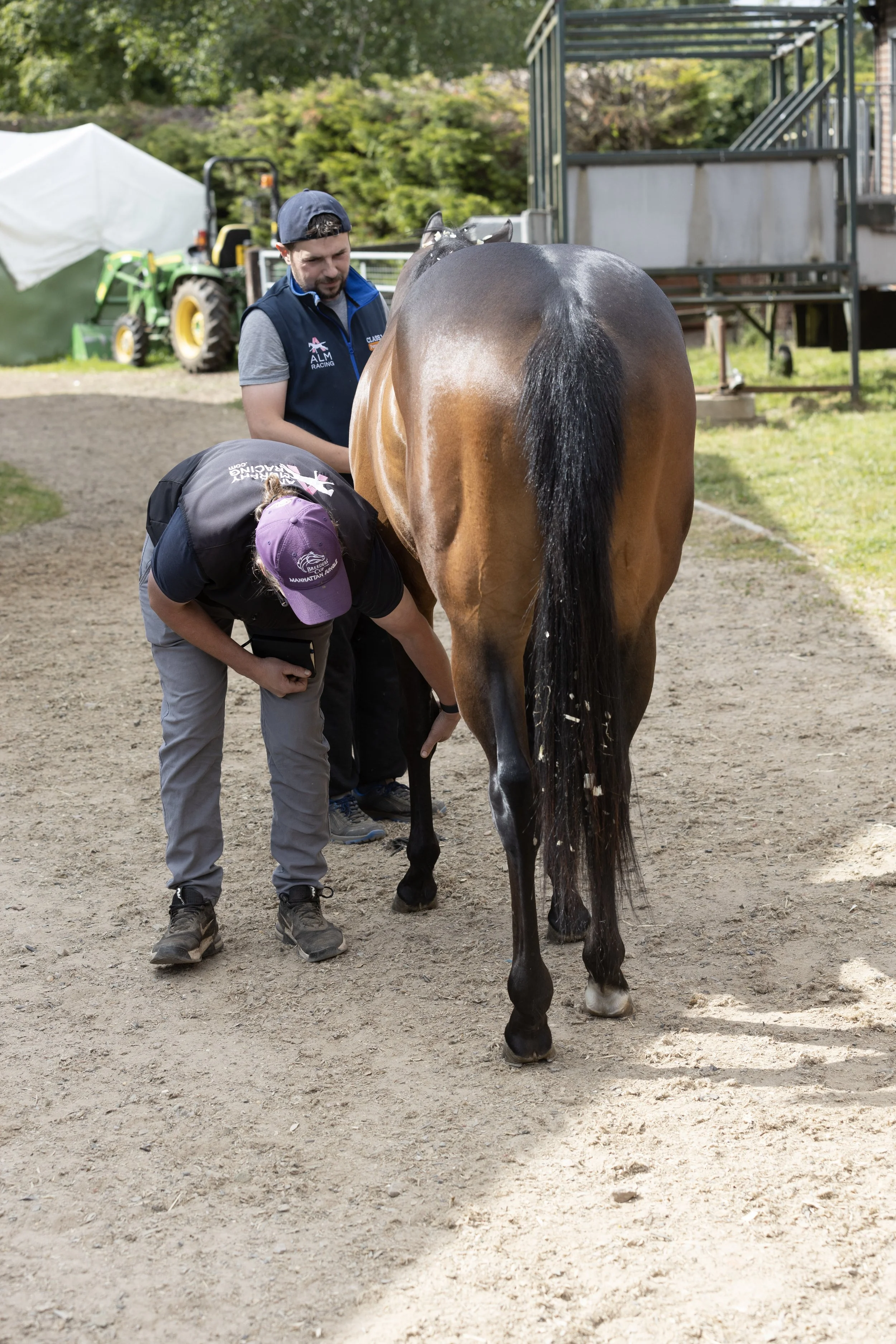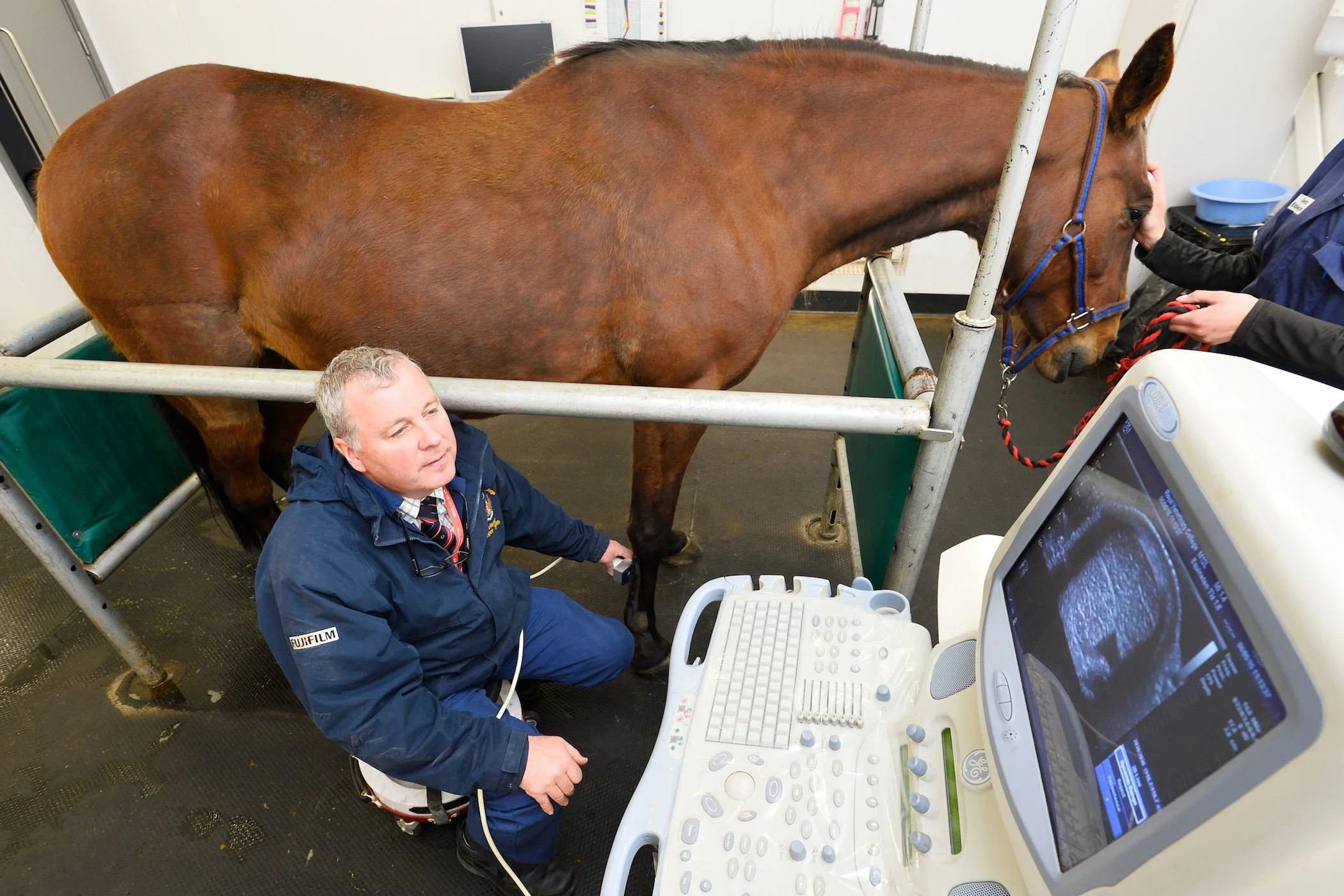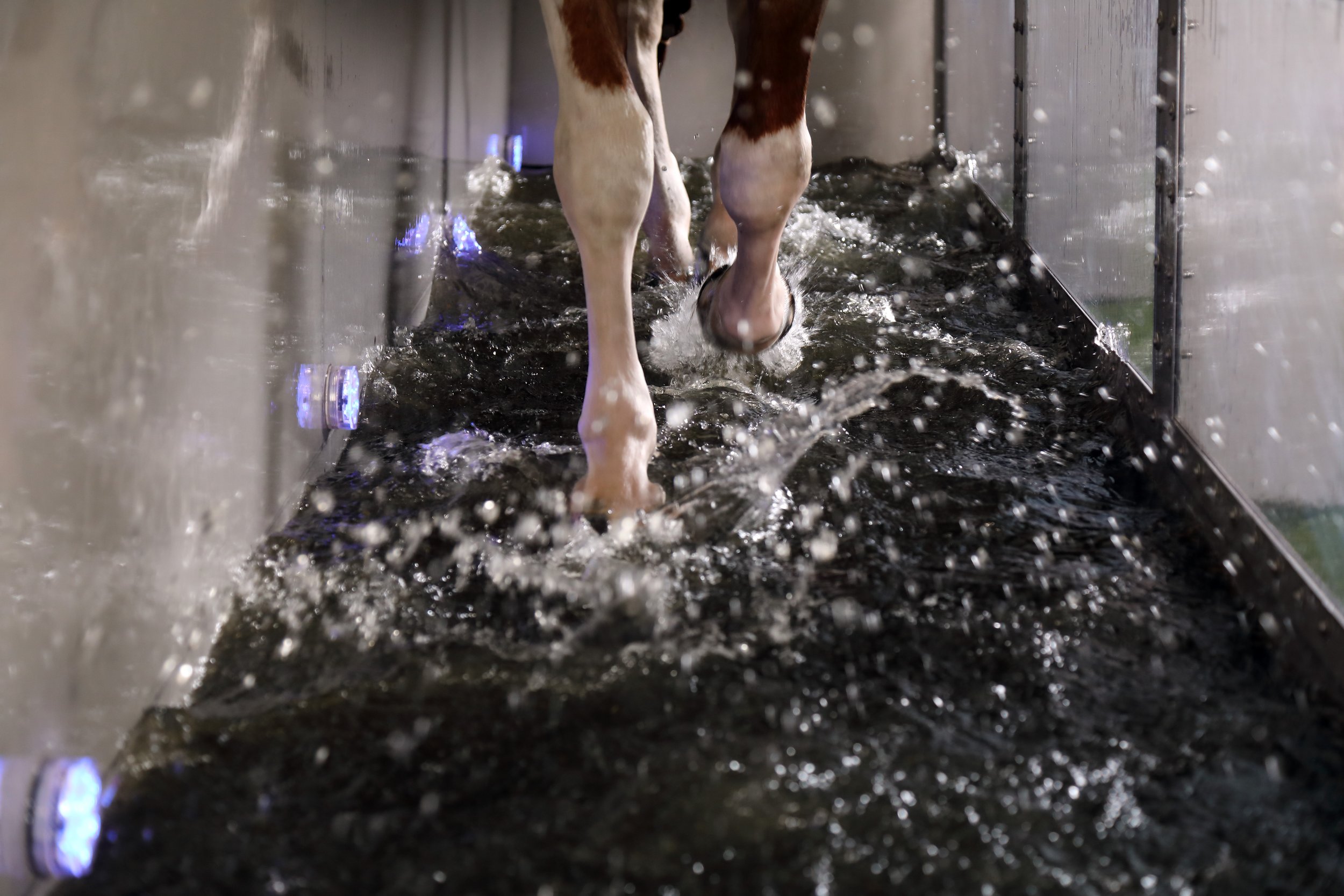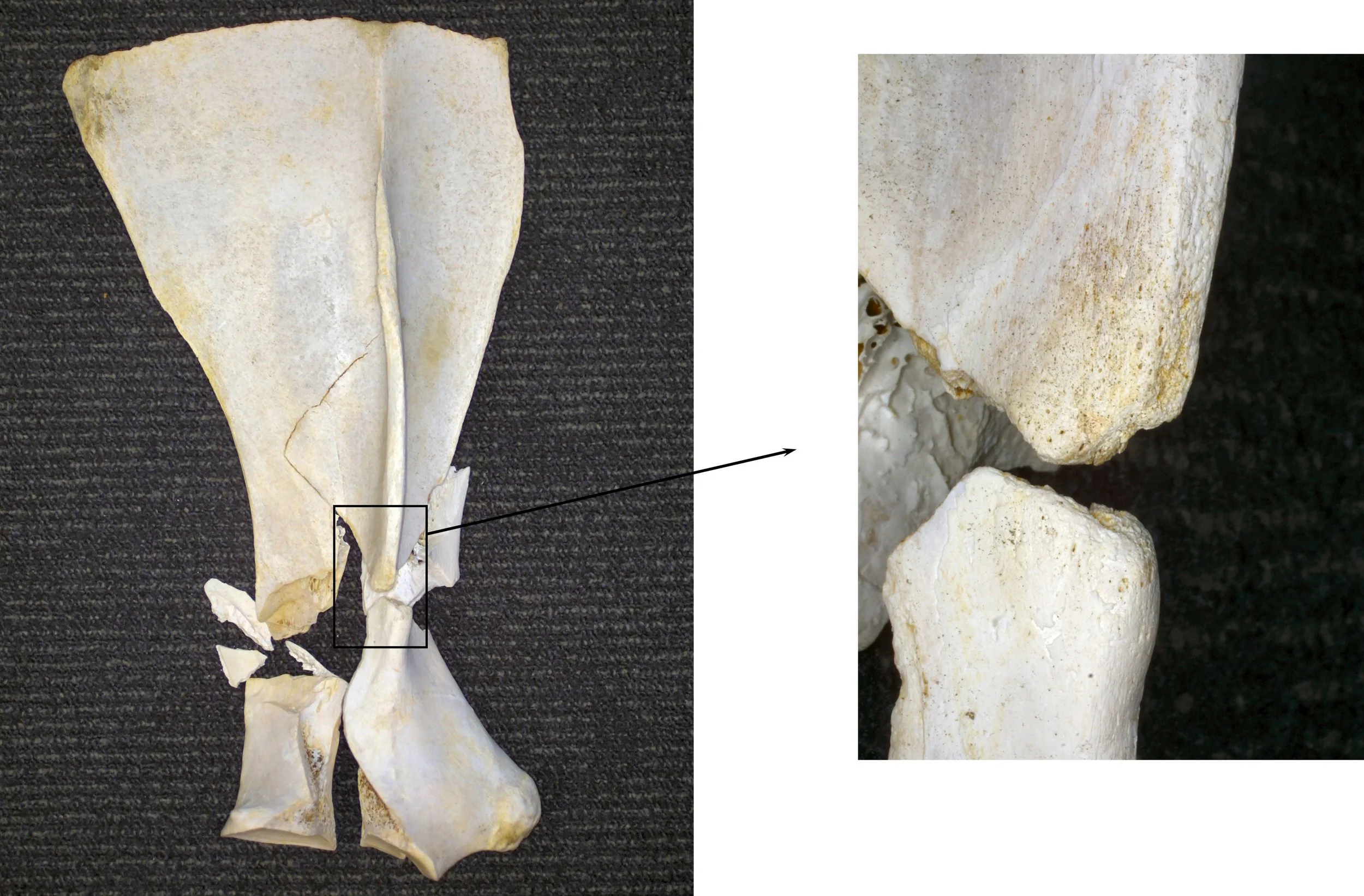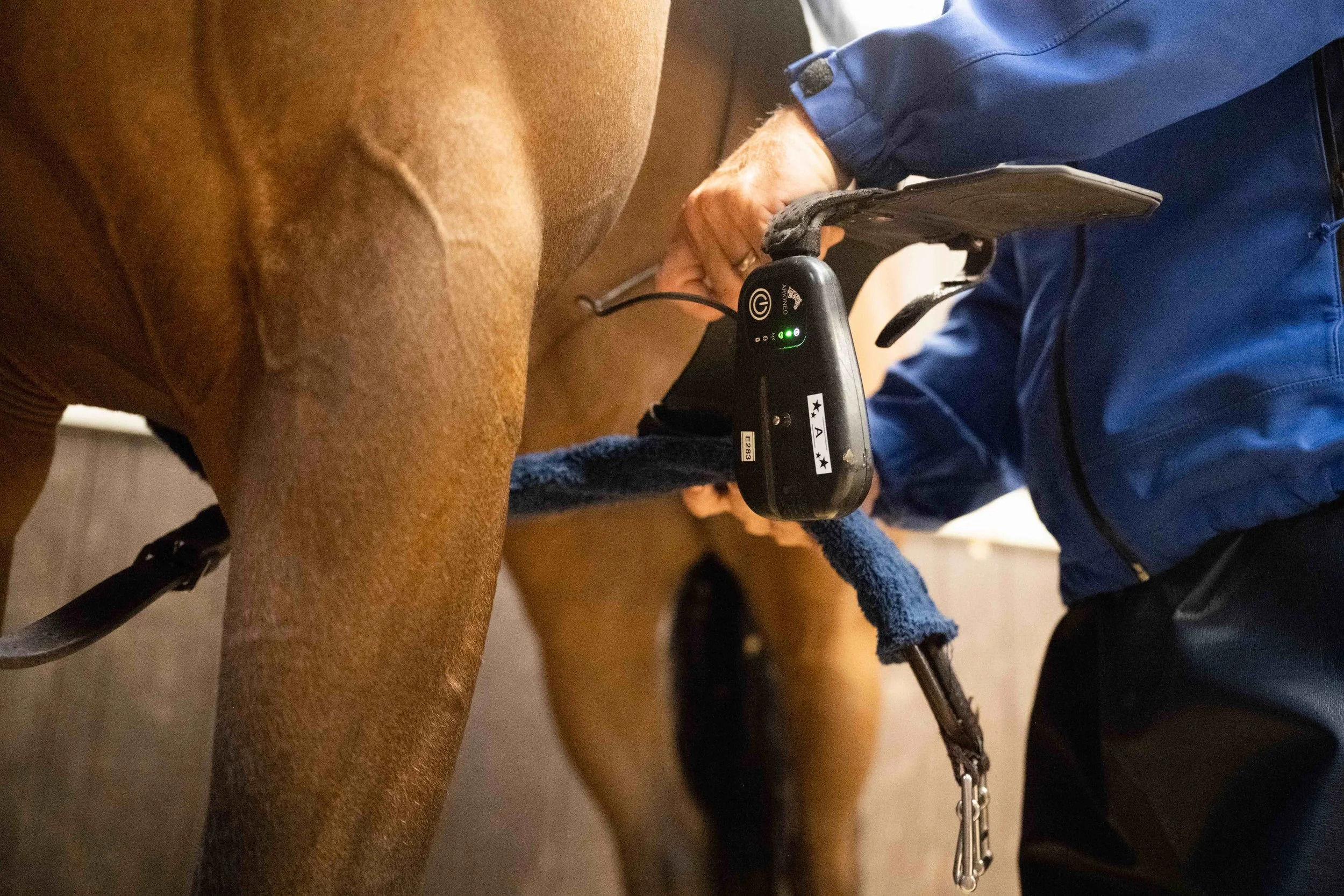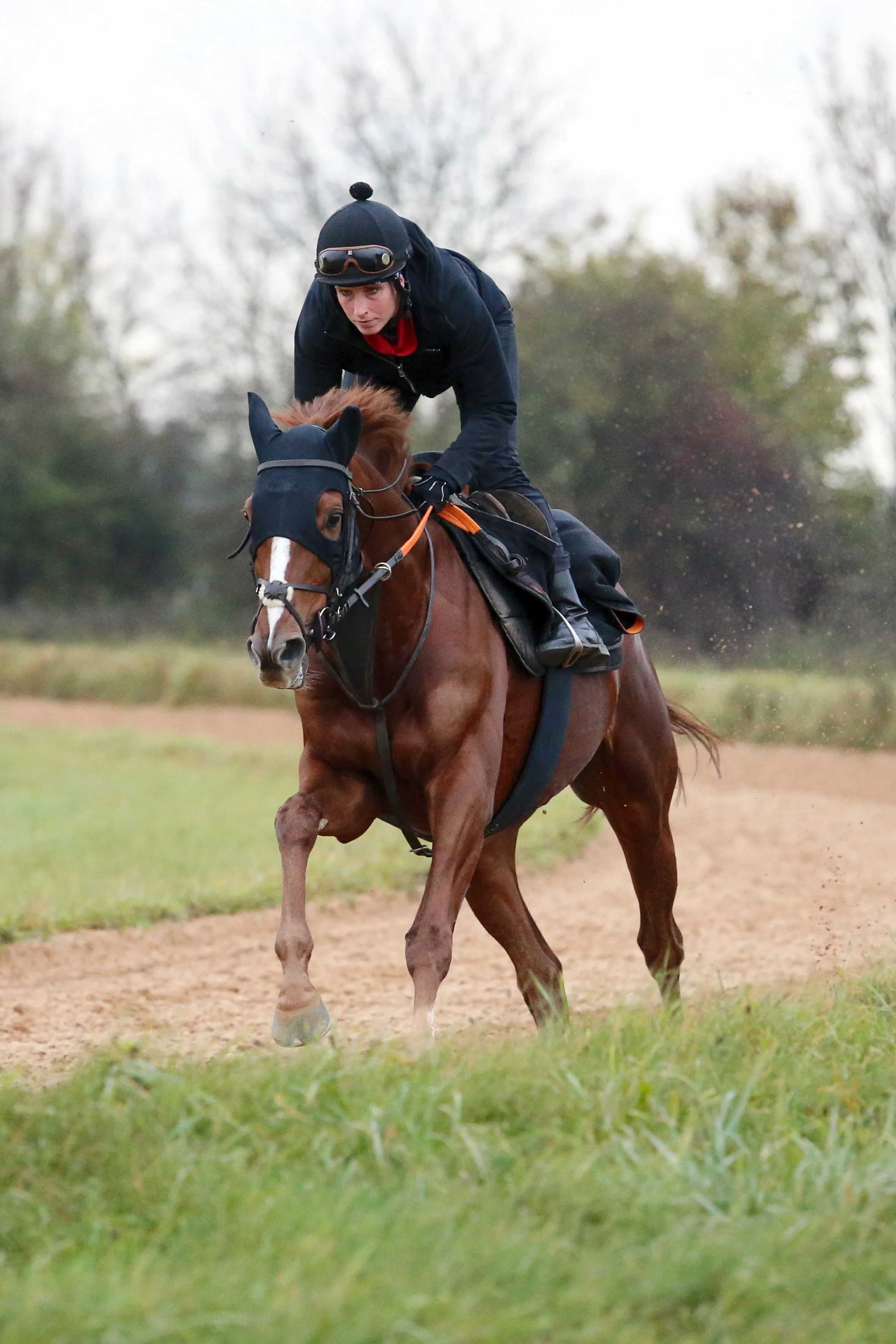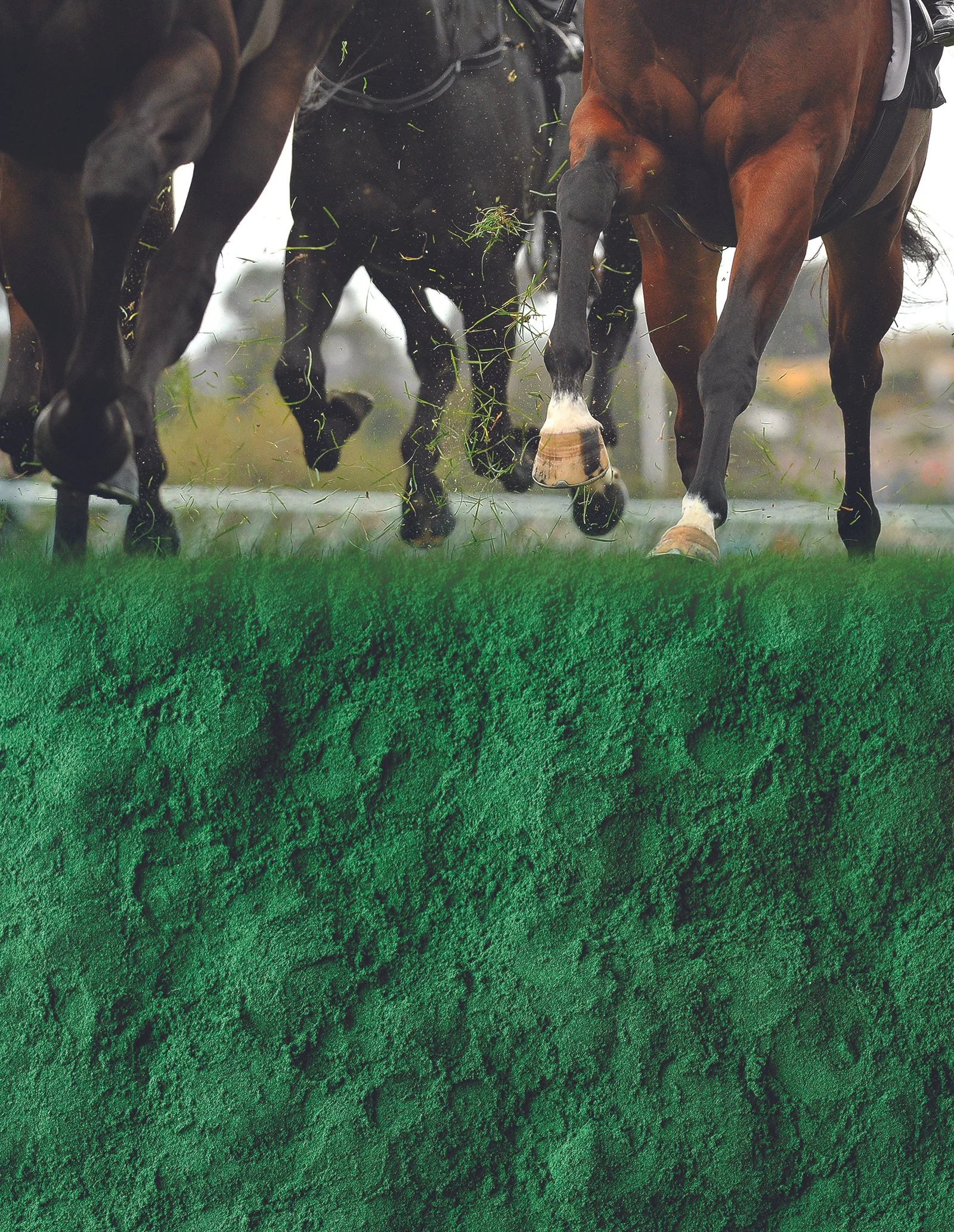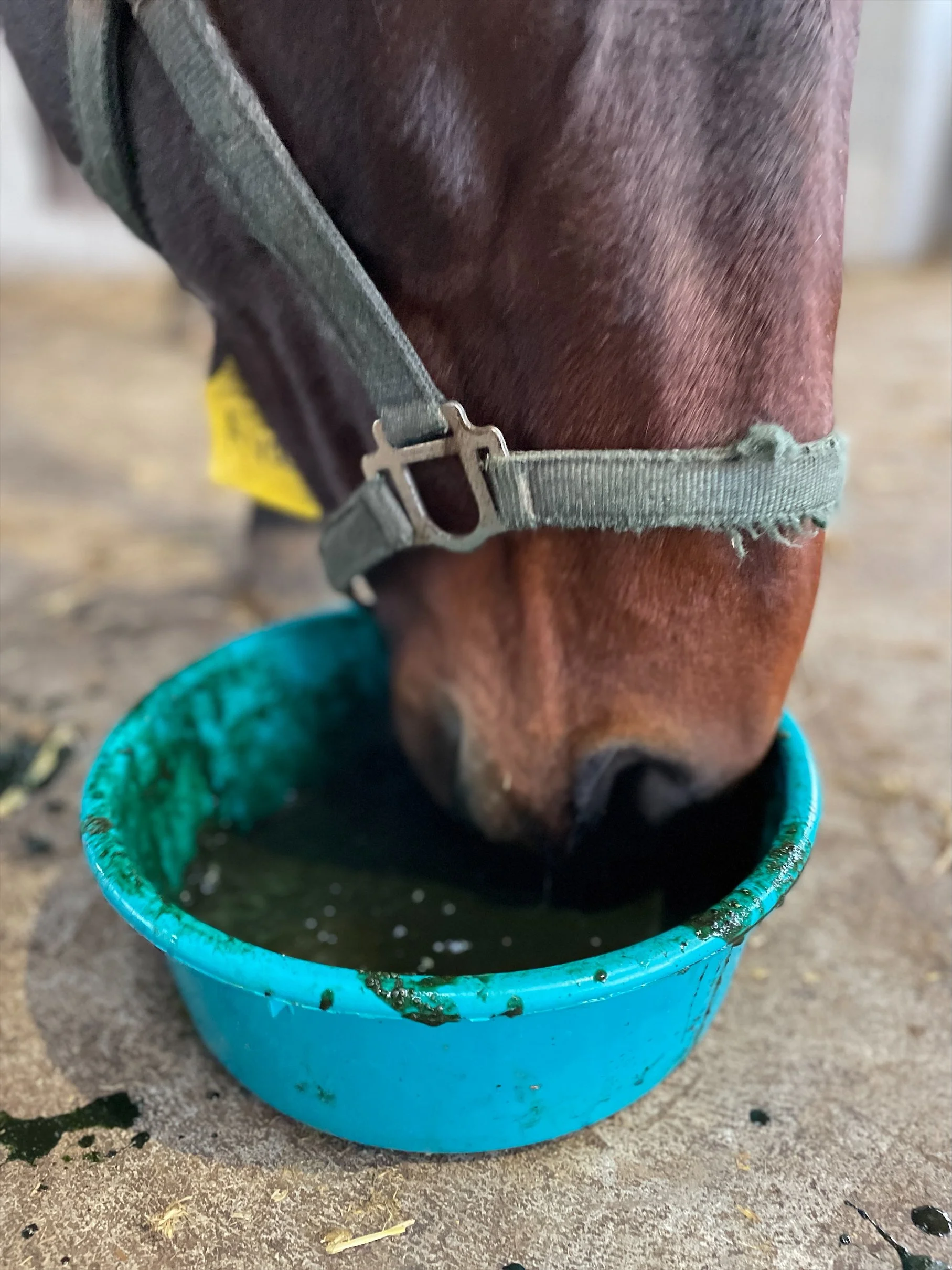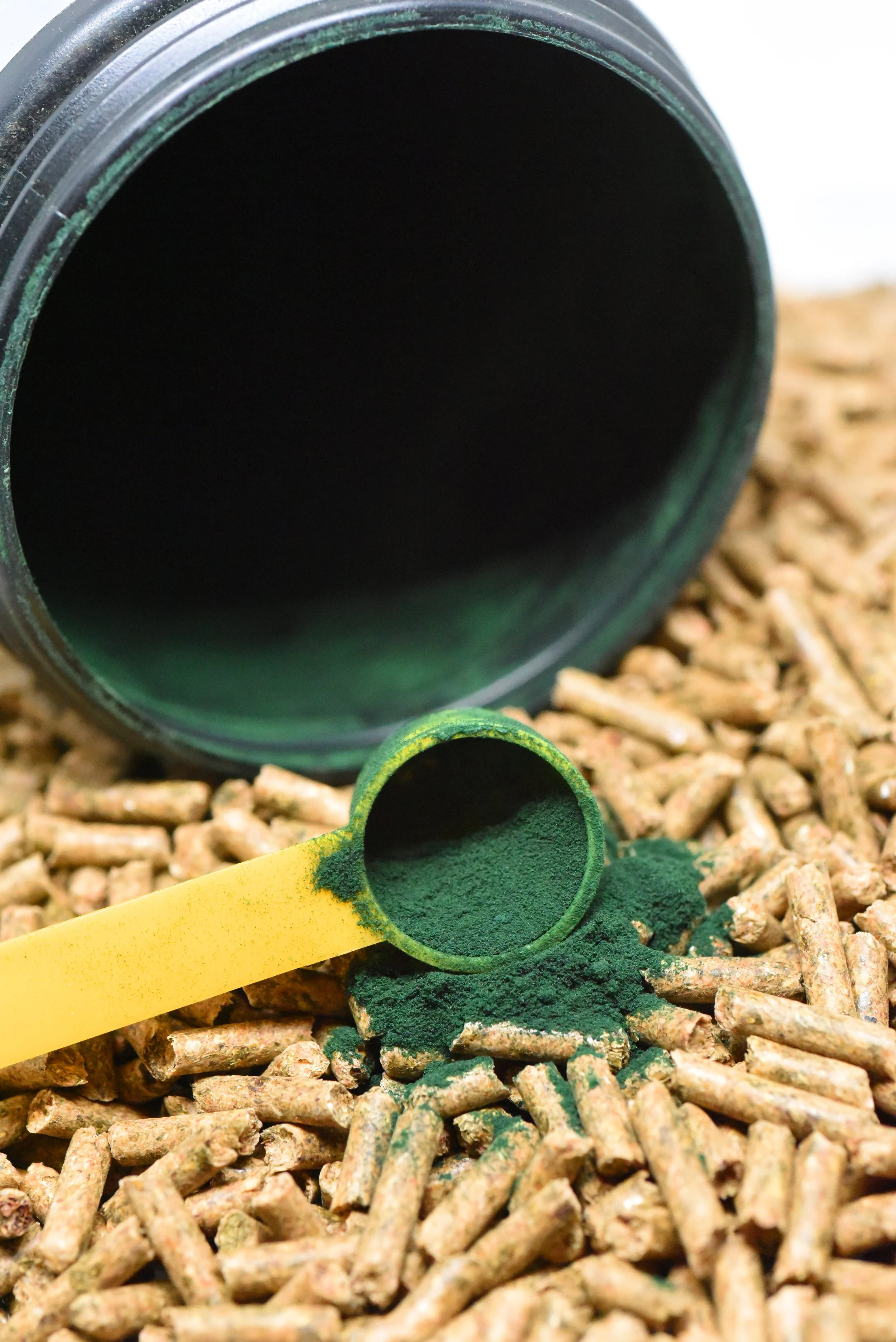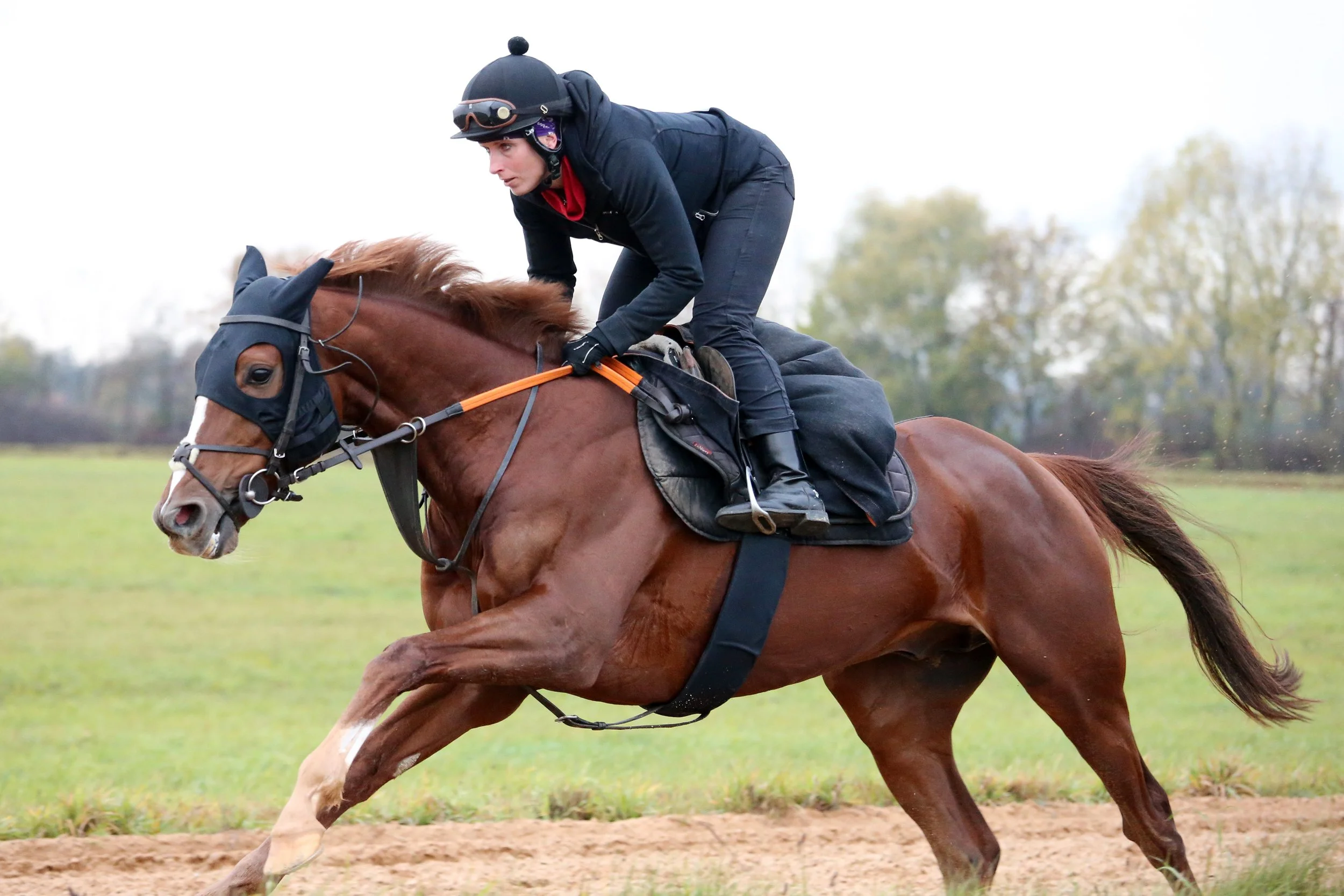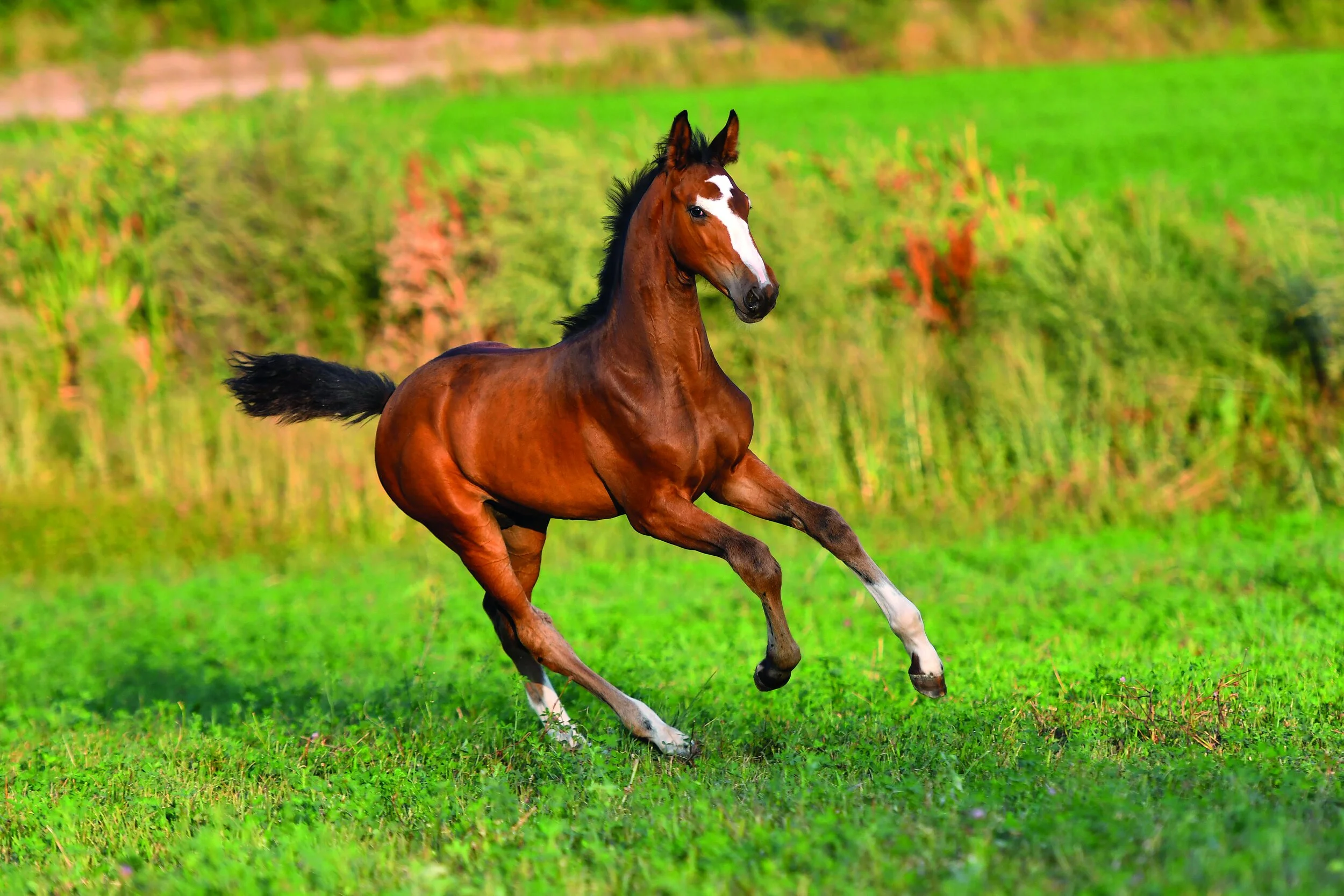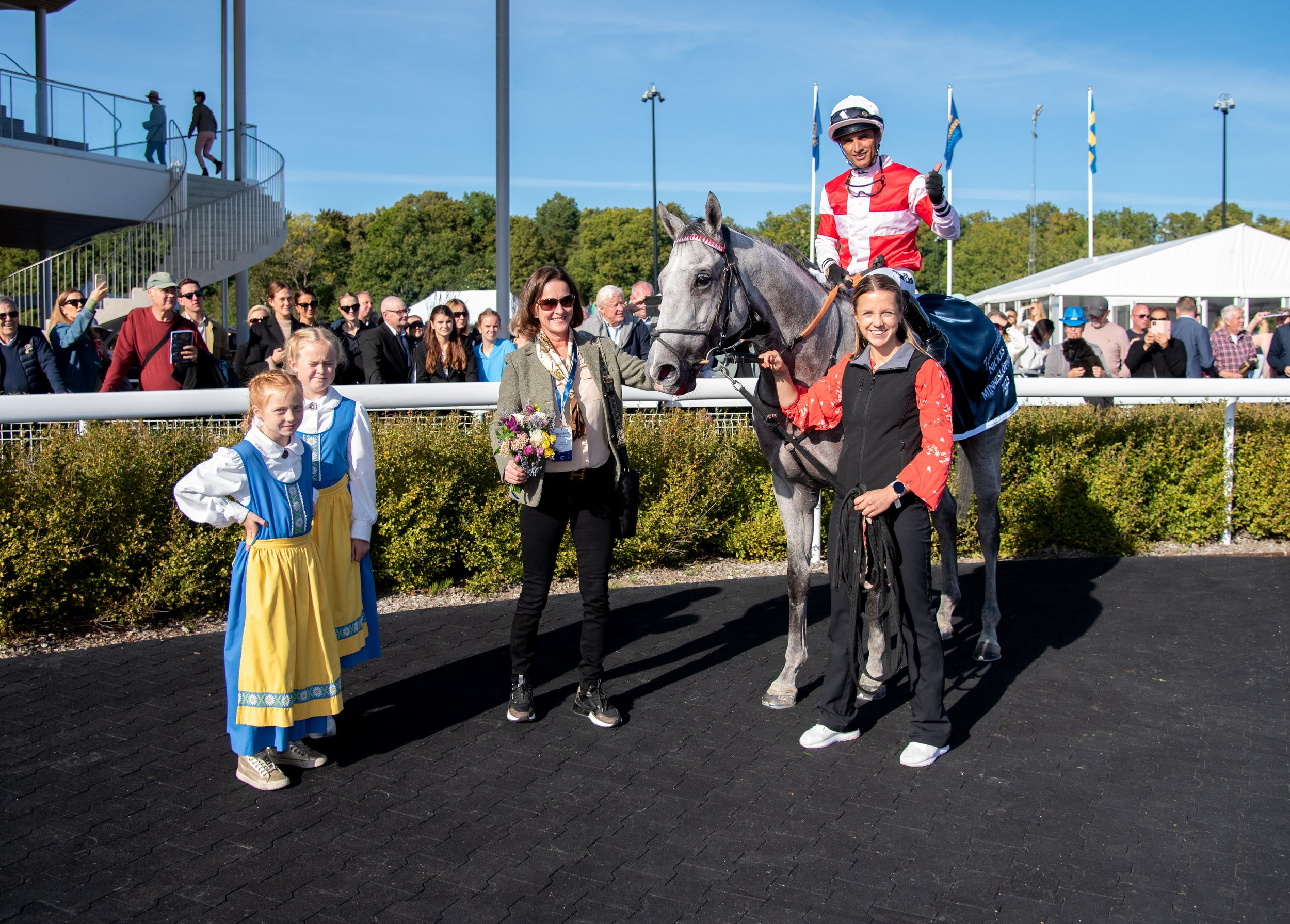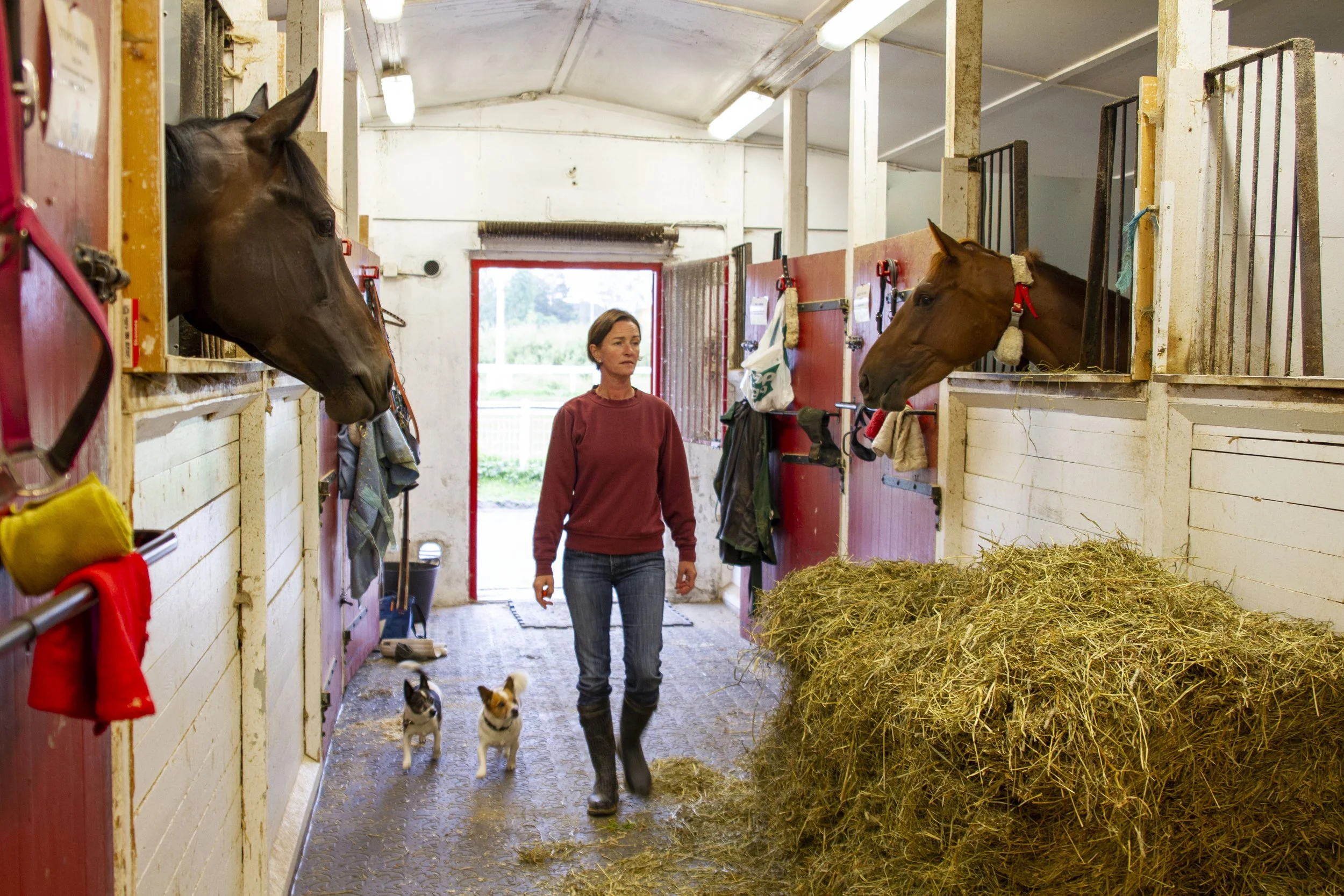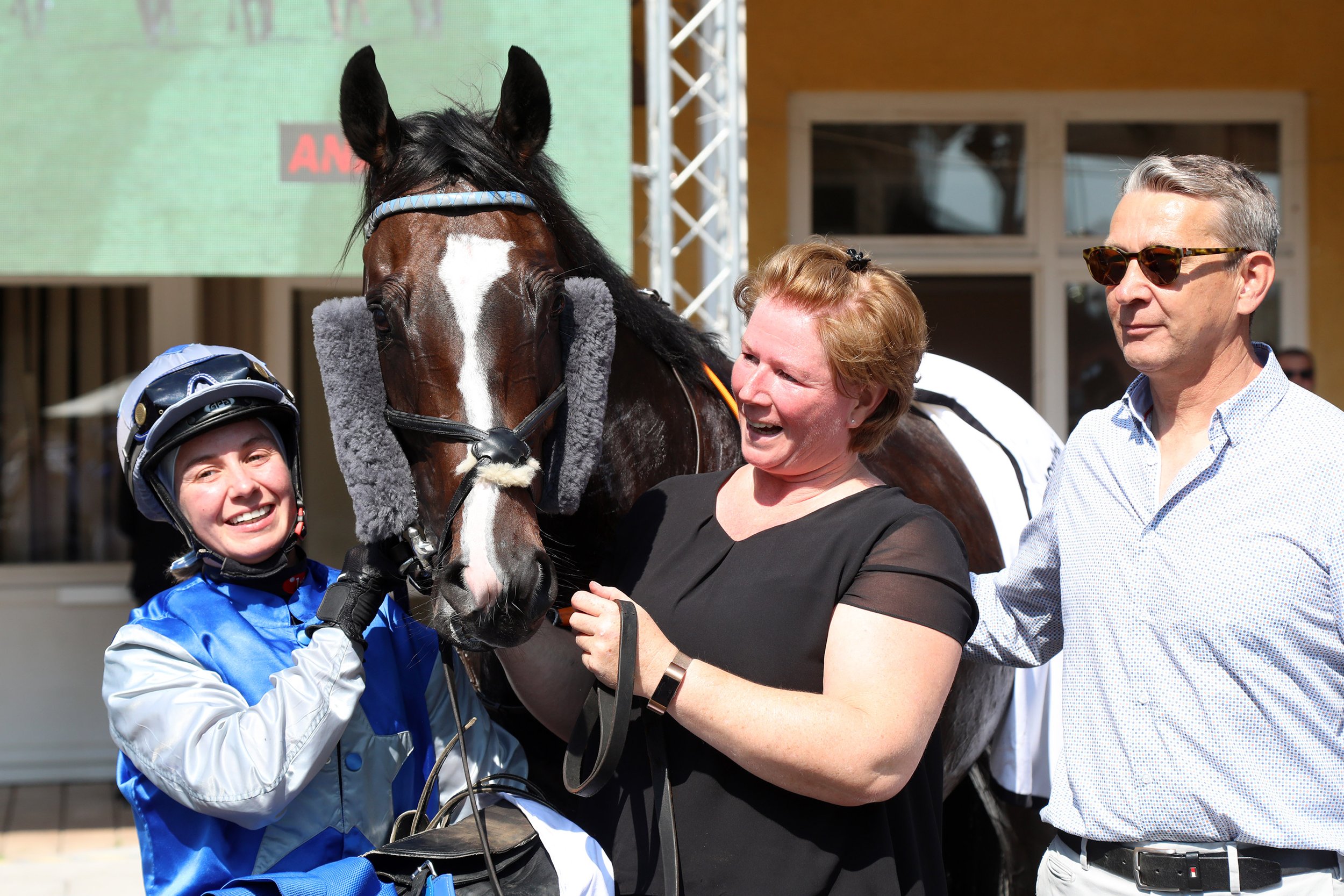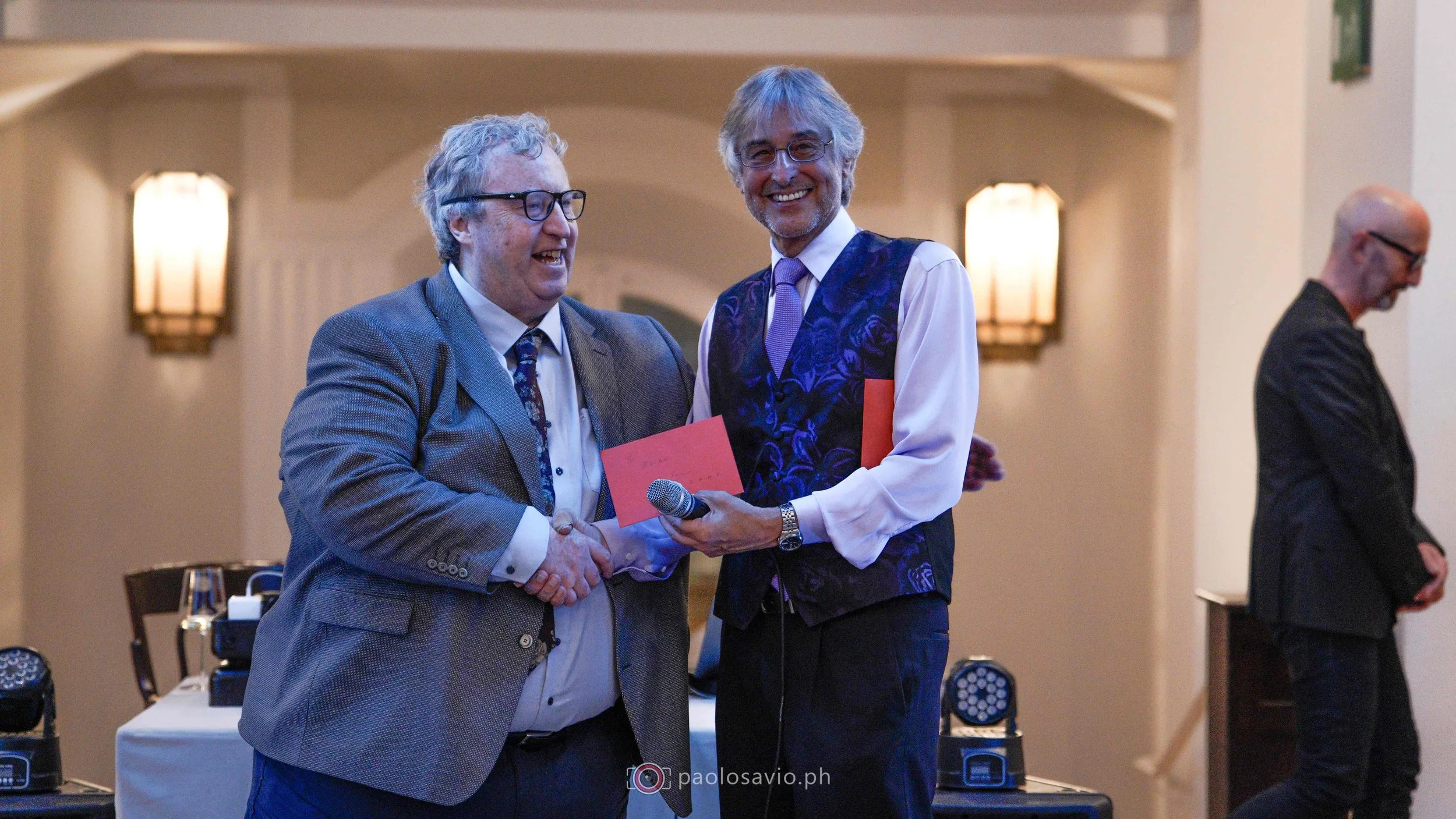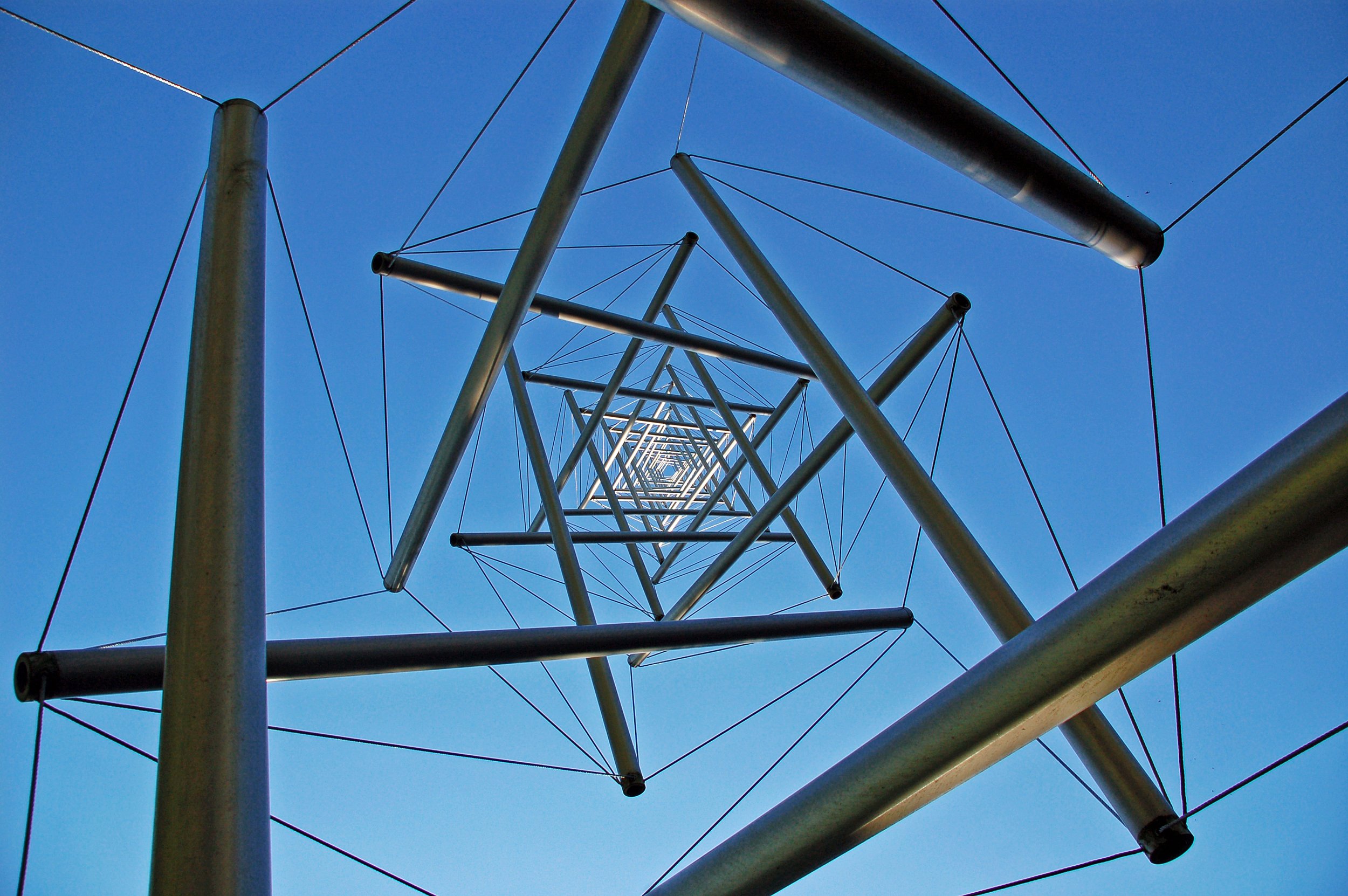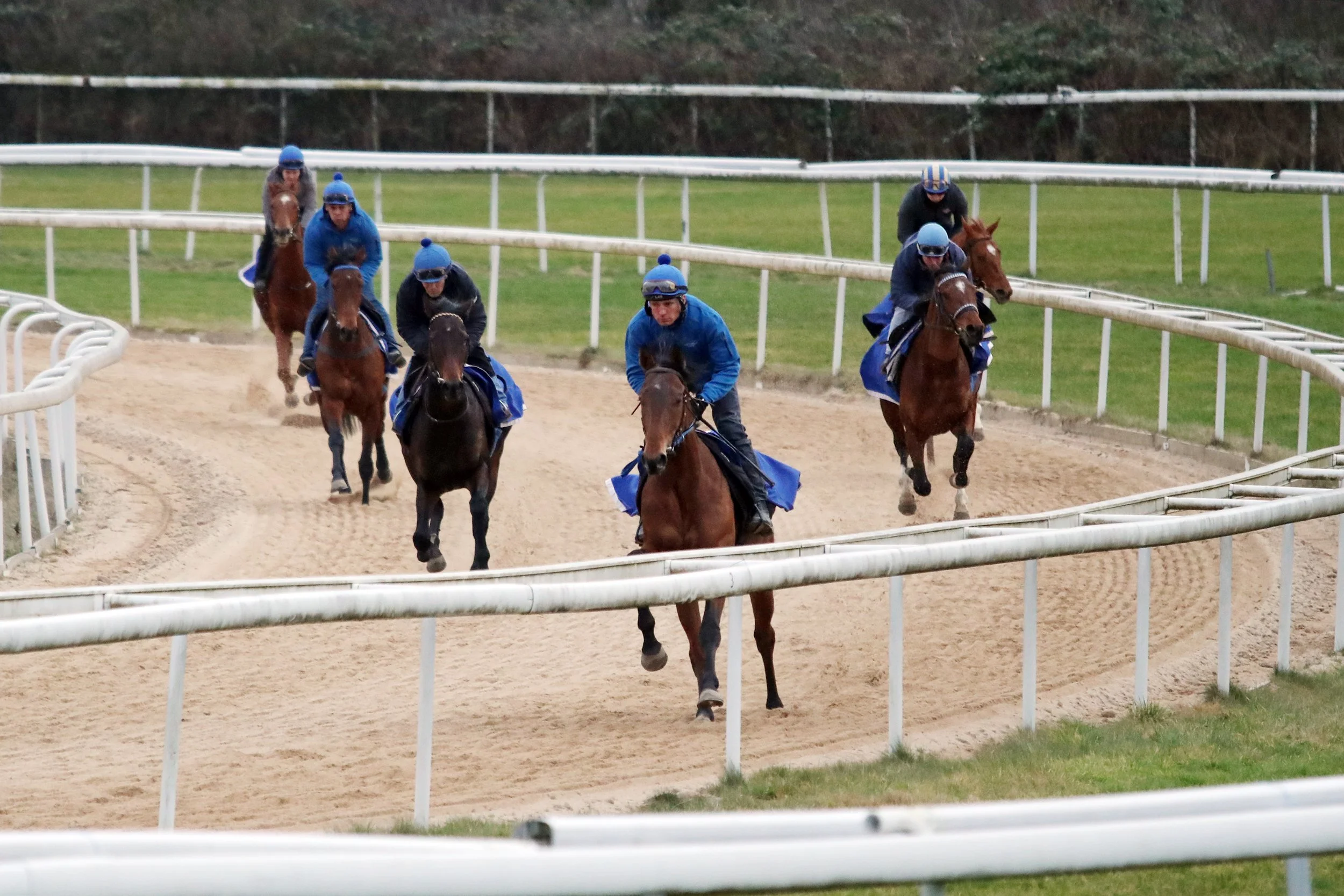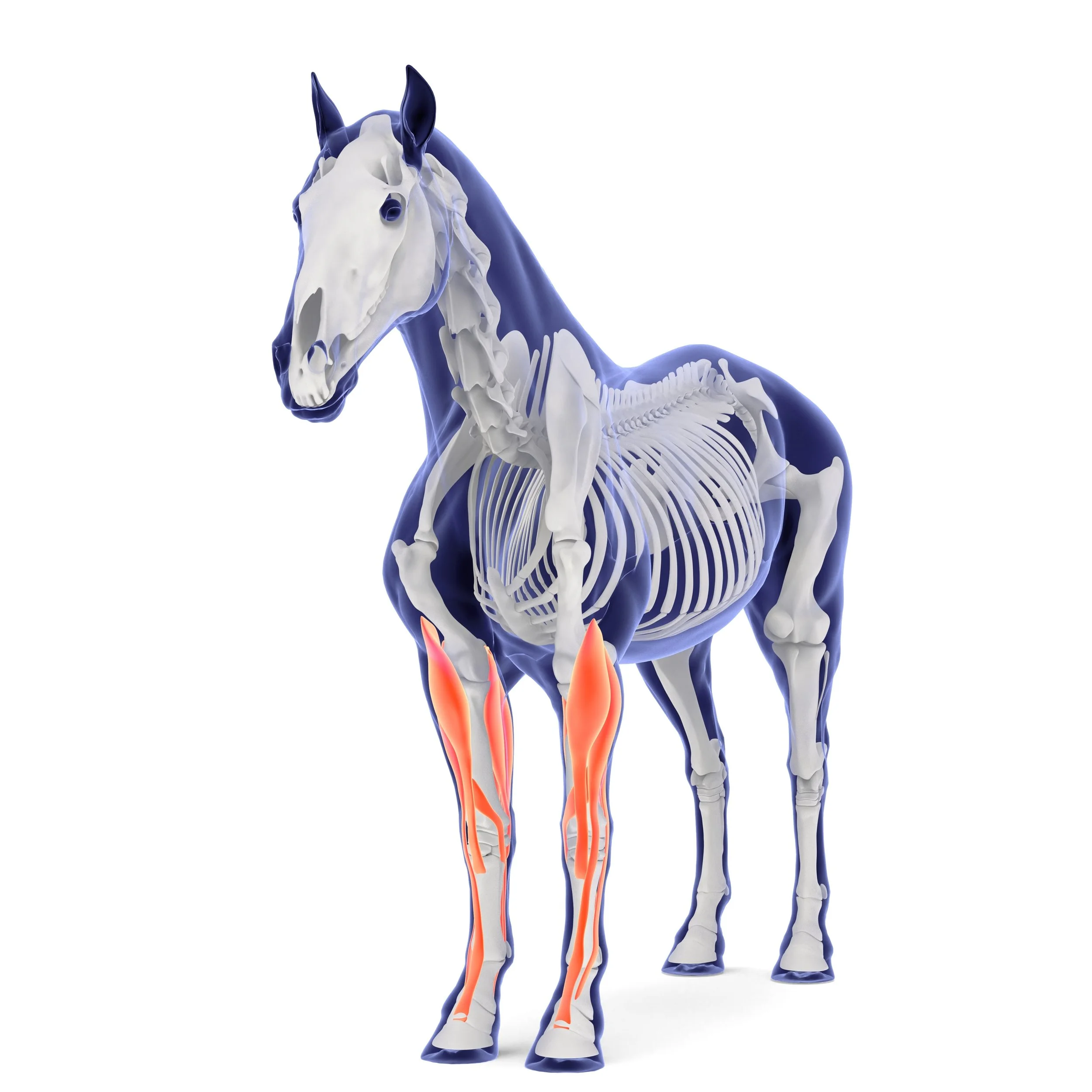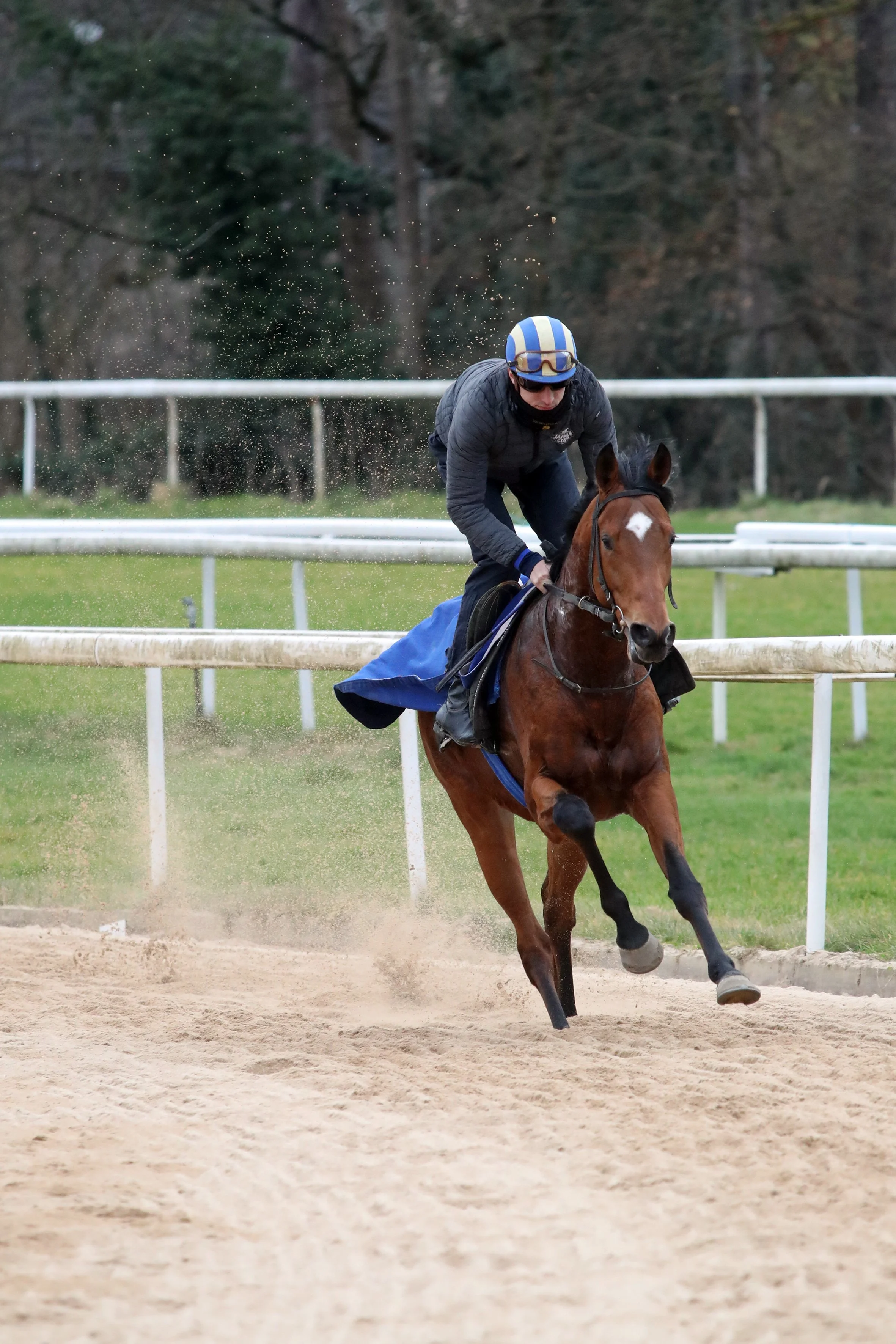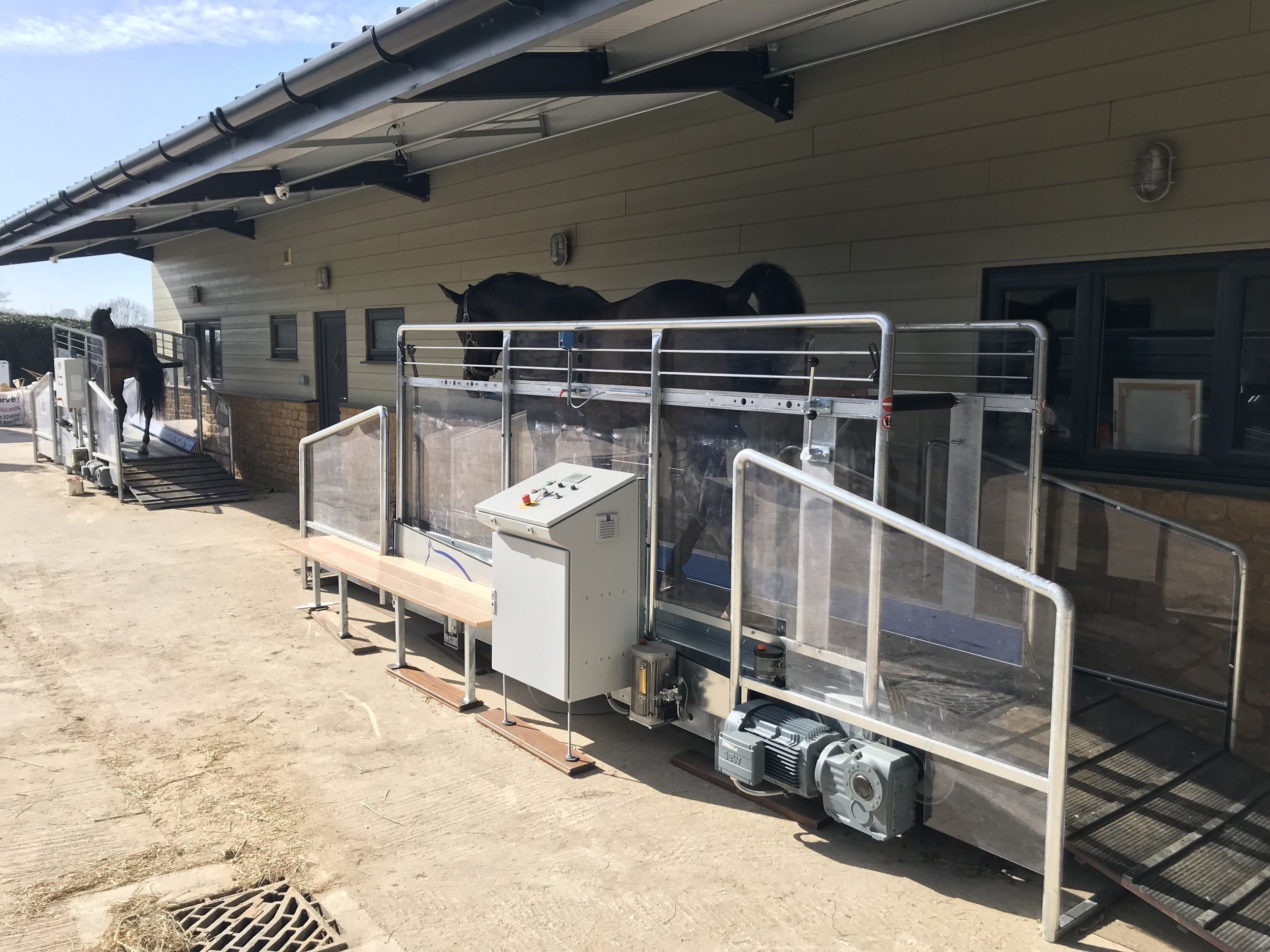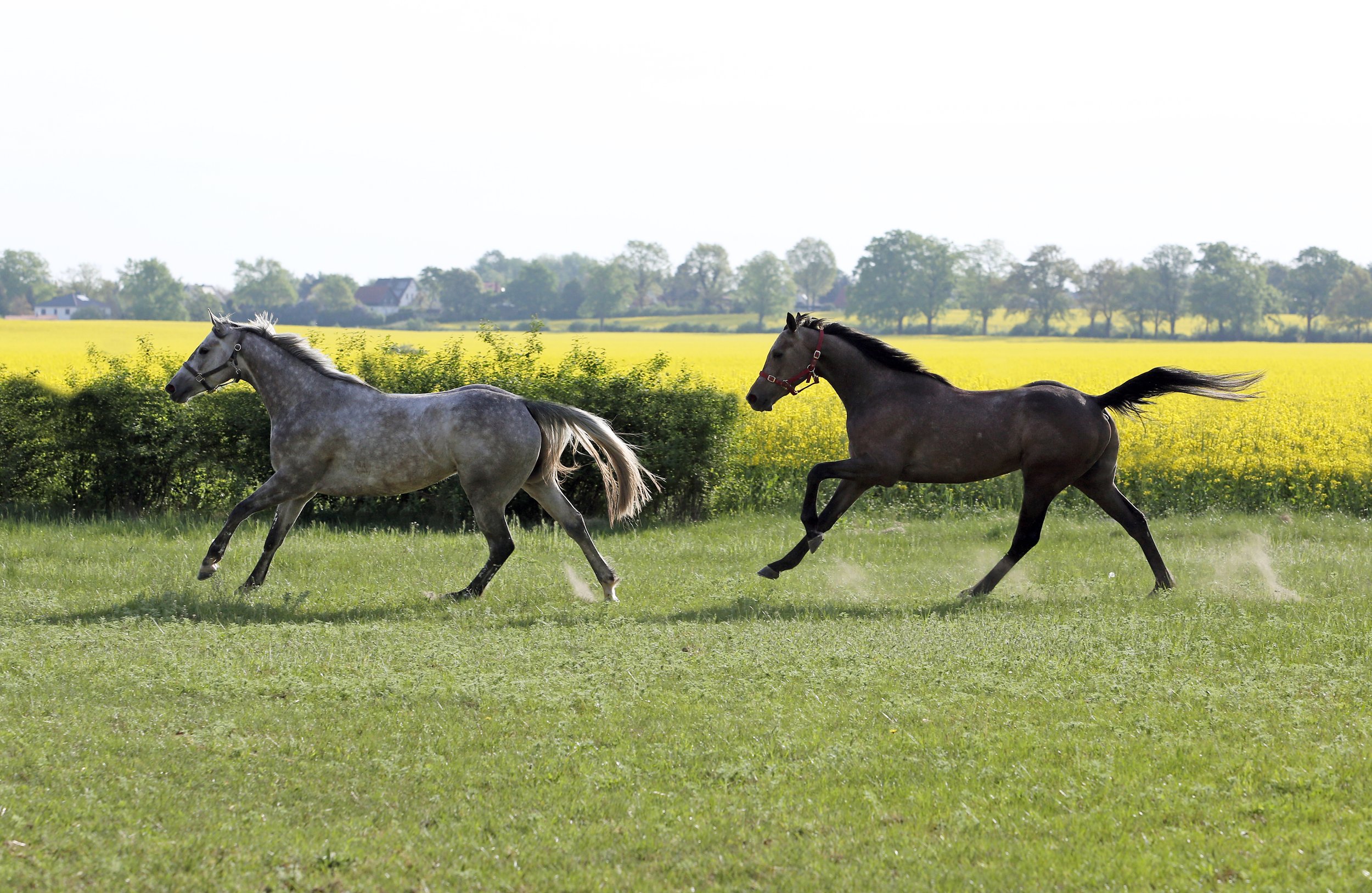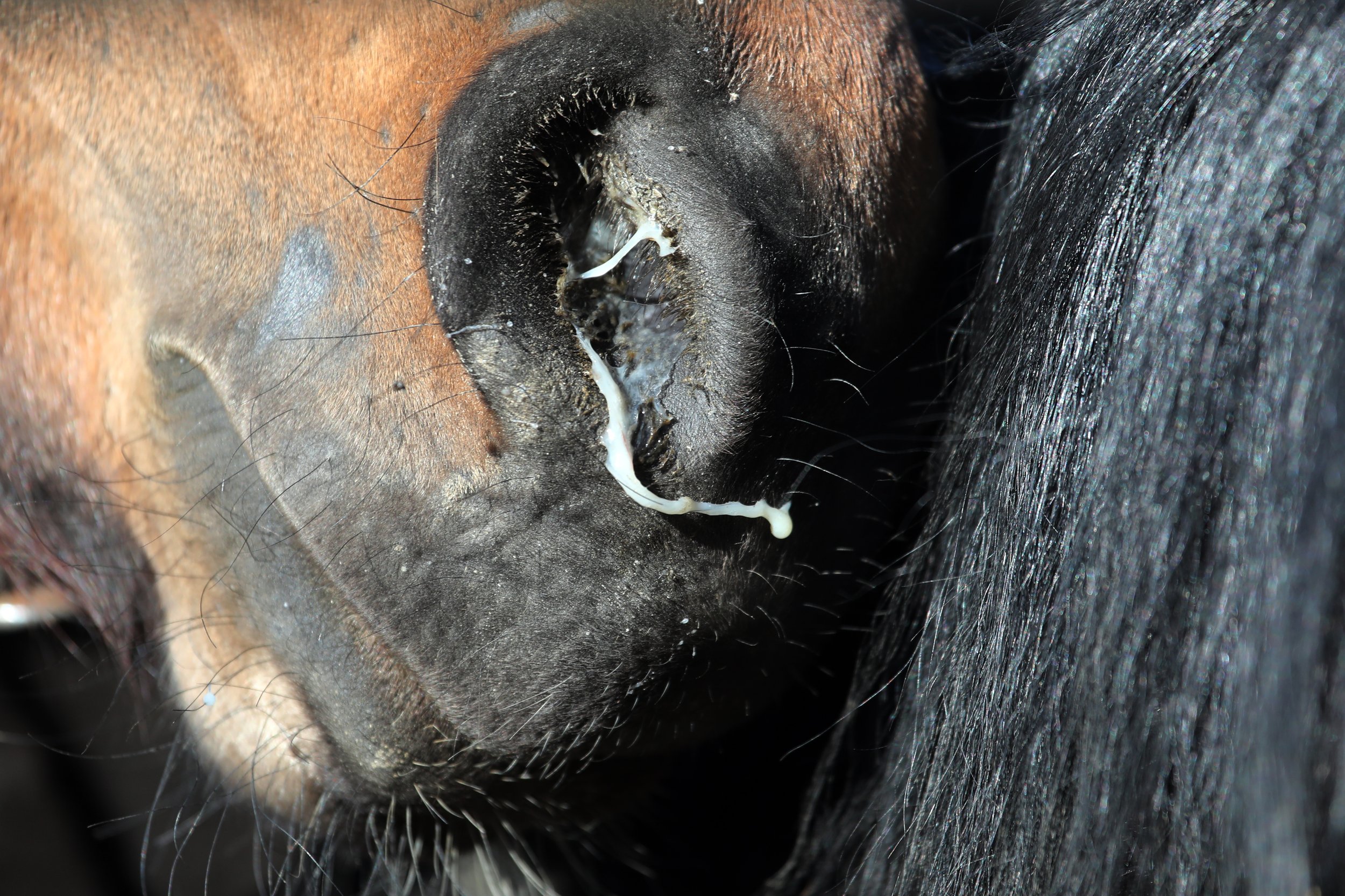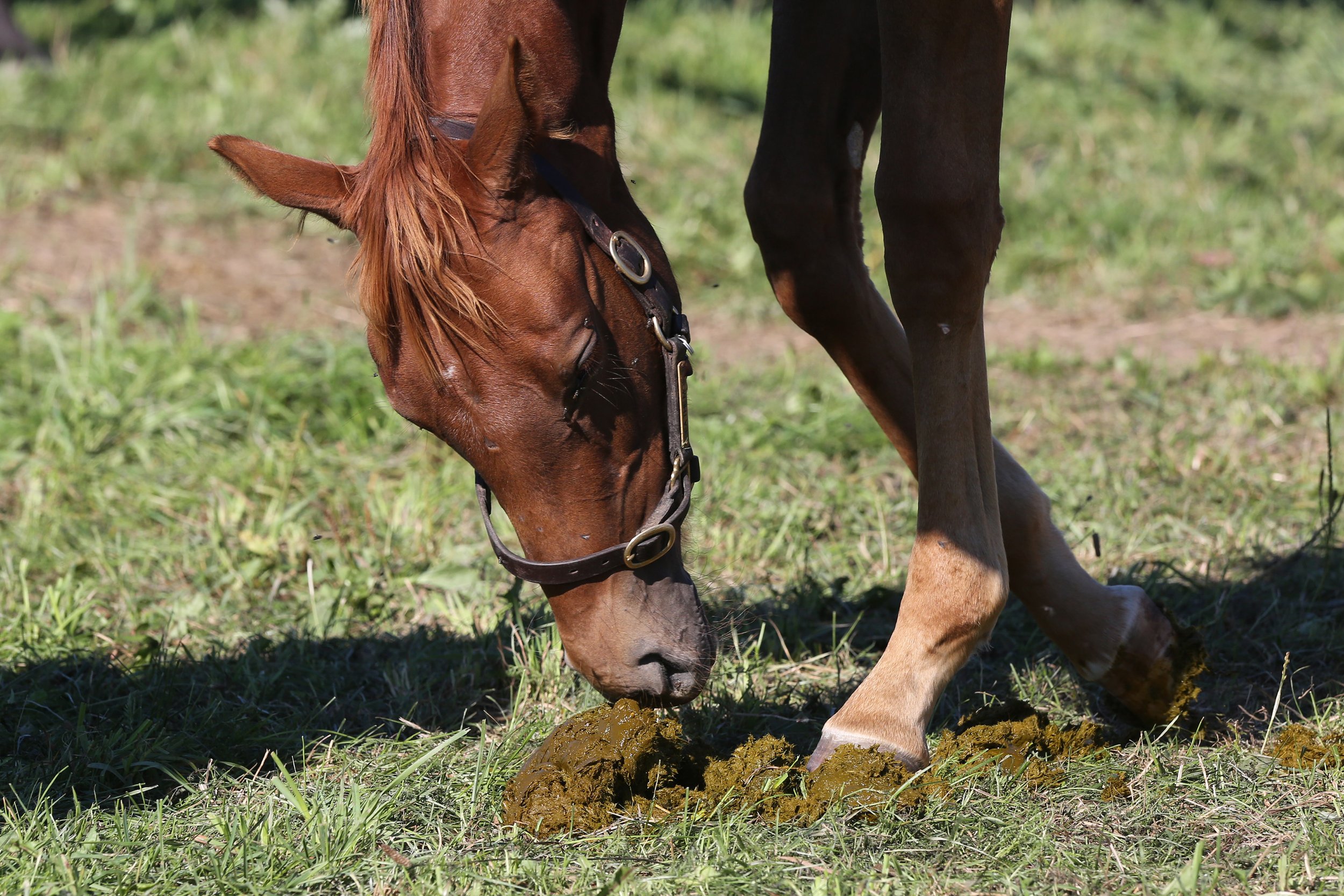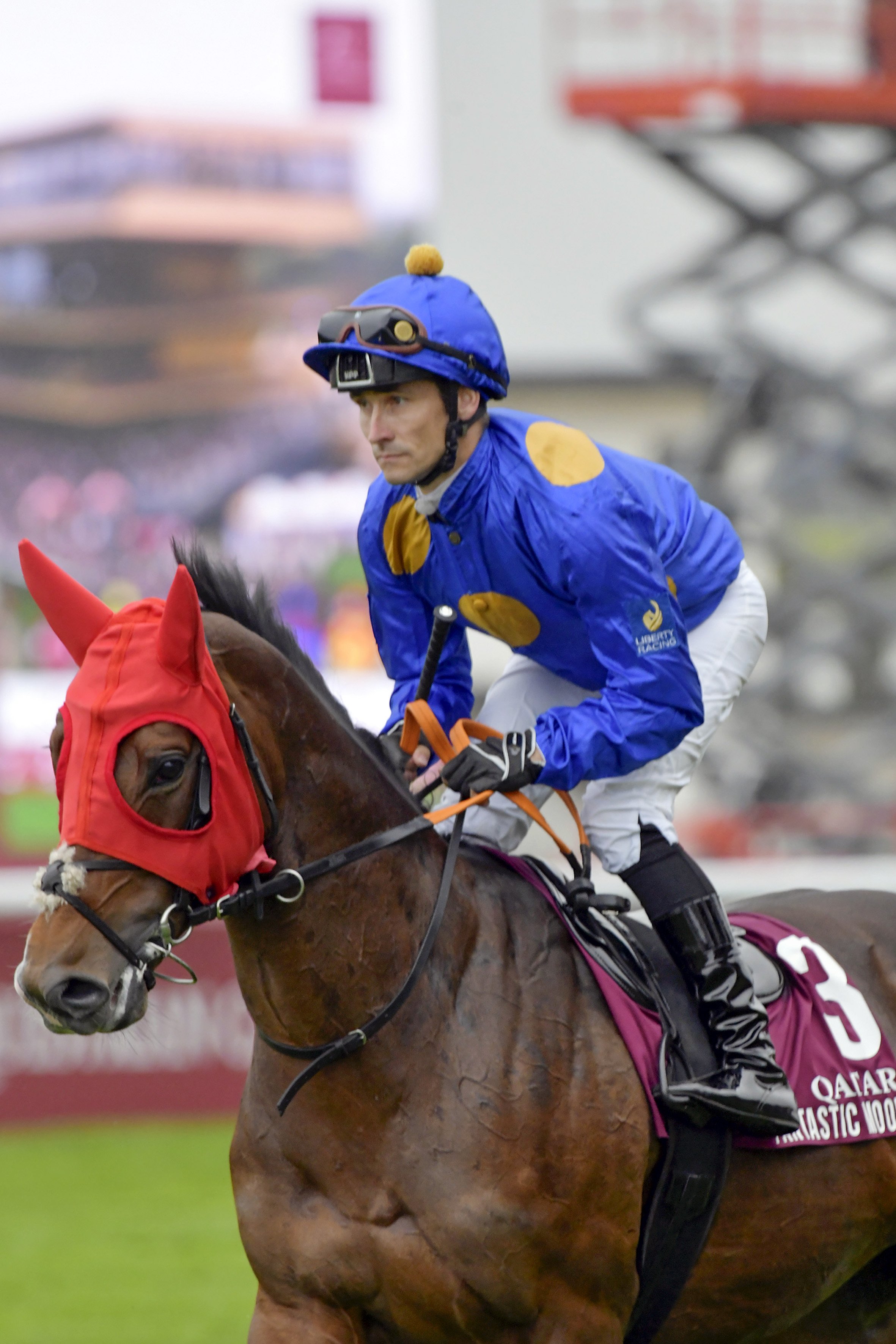Mario Baratti on how he’s created a classic winning stable in the heart of Chantilly
Mario Baratti is sitting behind the desk in the spacious office of his stable off the main avenue leading into Chantilly, munching a croissant in between second and third lots. I decline his offer of breakfast, and we quickly agree to communicate in French and to use the friendly “tu” form instead of the more formal “vous”.
Above the trainer’s right shoulder, a large watercolour depicts a scene of Royal Ascot, “it was a wedding gift and it was too big for the house so it has a perfect place here… The colours are beautiful and it’s a wonderful source of inspiration!” The walls are also adorned with photos and a framed front page of French racing daily Paris-Turf showing Baratti’s two Classic winners to date, Angers who lifted the German 2000 Guineas at Cologne in 2023 and Metropolitan who propelled his handler onto the big stage with a first Group 1 victory in the Poule d’Essai des Poulains a year later. There is plenty of space left for memorabilia which seems sure to come to celebrate wins in the future.
Born and raised in Brescia in North-West Italy near Lake Garda, Mario Baratti has a slightly different profile from several of his compatriots who are now successfully operating in Britain and France. The 35-year-old does not hail from a big racing family and he has little experience of training in his native country.
He explains, “My father was a great sportsman and was good at a lot of sports. Between age 18 and 25 he rode over jumps as an amateur. I started riding very early, at age four or five, and showjumped and evented when I was young and then started riding as an amateur as soon as I could. I was a true amateur as I didn’t start working in racing until I was 19. I was lucky to ride about 70 winners, in Italy but also in Britain and France, in a relatively short career in the saddle.”
A couple of summer stints with John Hills in Lambourn as a teenager further fuelled the young Mario’s passion for racing and he soon joined Italy’s legendary trainer, Mil Borromeo in Pisa, “Mil Borromeo was a great trainer, very sensitive and with an amazing capacity to listen to his horses. His objective was to create champions and he succeeded many times during his career. He was on the same level as the top trainers from England, Ireland and France from the time. He was very sensitive and attentive to his horses. My official title with him was assistant but I was so young I was more of an intern.”
After a year with the Classic Italian trainer, Borromeo advised the young Barrati to spread his wings and continue his education, both in racing and academically.
The Botti Academy
The logical port of call was Newmarket and the stable of training’s rising Italian star of the time, Marco Botti. “I used to ride out in the mornings and go to Cambridge in the afternoons to learn English. The original plan was to spend just a year in England to pass a language exam, but after I passed the exam, Marco Botti proposed the position of assistant if I stayed with him. When I started he had less than 50 horses and during the four years I was there the number rose to over a hundred so it was a real growth period. I had the good fortune to ride horses like Excelebration who was exceptional, and to travel to Dubai, or Santa Anita for the Breeders’ Cup... He had six or seven real high-quality Group horses, who could travel and win abroad.
I learnt many things during my time with Marco and the most important was probably how to manage the horses in the best possible way to optimize their potential. I think the secret to his international success is that he travels his horses at the right moment. He understands when a horse is tough enough to go abroad, and he doesn’t take them too early in their careers.”
After four years in the buzzing racing town of Newmarket, it was time to continue the learning curve and despite an offer to join another compatriot, Luca Cumani, Baratti remembers, “everyone advised me to go to America or Ireland.” So the young Italian found himself in rural County Kilkenny. “Jim Bolger said he would only take me if I stayed for three years, but in the end I cut my time short. It was a very good experience and I learnt a lot about breaking in yearlings and working with youngsters. I learnt what I could in a short time as I was only there for three or four months, an intense experience of work and life. Mr Bolger is a real horseman, who is tough on his horses but always manages to produce champions. He can do things that others cannot allow themselves to do, because he breeds and owns a lot of the horses himself.”
Despite the prestige of his Classic-winning mentor, Baratti was unable to settle in Ireland. “I like the countryside, but I was isolated. I was 25 years old and never saw or spoke to anyone and the lifestyle wasn’t for me. So one day I told him, “I can’t stay three years”, and he said, “you want to train in London? You can’t train in London!” I’ll never forget that! But he understood and in the end he said, “I’ve taught a lot of top professionals, McCoy, O’Brien, but it’s up to you if you want to leave. I hope that you find someone as good as me…””
Pascal Bary an inspiring mentor
Next stop was France, and Baratti took advantage of a couple of months before his start date with his next boss, Pascal Bary, to join fellow Italian Simone Brogi who had recently set out training in Pau. He also spent a month with Brogi’s former boss, Jean-Claude Rouget, at Deauville’s all-important August meeting.
“The time helped me to learn French and integrate into the French ambiance, which wasn’t easy. I found it much tougher to settle in France than in Newmarket. As a foreigner I felt less well received. Even at Newmarket, I started as an assistant when I was 18 years old, with no experience, and it was tricky to manage a team of 25 or 30 staff. But when I started here it was even more difficult to handle the French staff. They would say to me ‘I’ve never done that in 30 years and I’m not going to start now…’ During the early days with Pascal Bary, I thought that France wasn’t going to be for me. Then it became a personal challenge and I decided to stick it out. Now, Pascal Bary is one of the closest friends I have here in Chantilly, but at the start he wasn’t an easy boss. It took two years, of the four that I was there, before we built up a real relationship. On my side, I was very respectful, and I saw him as someone who was very reserved, so we kept our distance. I was in awe of him and his career. He wasn’t interested in just winning races, he wanted to develop the best out of his horses. That’s why he had such a great career. 41 Group 1 wins in a 40-year career is a huge achievement. He won Dianes, Jockey-Clubs, Poules, Guineas, Breeders Cups, the Irish Derby… He’s the only French trainer to win the Dubai World Cup. He started off going to California for the Breeders’ Cup when he was very young. He would dare to step into the unknown, because at the time it was much more complicated to travel around the world.
I was lucky to be there at the time of Senga - who won the Prix de Diane and Study of Man won the Prix du Jockey-Club. So I worked with top horses, who were perfectly managed, and many of them were for owner-breeders. Very early in the season, when the grass gallops opened, he would immediately pick out the three or four standout horses and plan their programme. He could tell right away which ones had talent ‘this one will debut in the Prix des Marettes at Deauville… ‘ I remember that year the filly did exactly that and won; it was Senga and she went on to win the Diane.
When you spend time with someone at the end of their career, there is more to learn. Pascal Bary had a superb training method, and he had the success he did because he was very firm in his decisions. He’s not someone who changes his mind every day, and there aren’t many people like that nowadays. He was very sensitive to his horses and always sought to create champions. I try to keep in mind his method.”
Changing dimension
The string for third lot is now ready to pull out and we make our way through the yard which has been adapted to accommodate an expanding string.
“We recently acquired the next-door yard and we knocked through the walls of a stable to make a passageway between the two. I now have 73 boxes in these two yards, plus 15 at another site which has the benefit of turnout paddocks.”
Through a gate in the hedge at the back of the courtyard and we are straight onto the famed Aigles gallops as the sun starts to break through the clouds on what had begun as an overcast morning.
“It’s a magnificent site; we are so lucky to have such beautiful surroundings and for me to be able to access the gallops on foot.” As we make our way to the walking ring in the trees where the Baratti string circles before and after work each morning, the trainer tells me, “I still ride out every Sunday, bar only two or three weeks in the year. I think it’s important to exercise as many as we can on a Sunday and if I ride two, that’s a help to the staff and a real pleasure for me too.”
The string of around twenty juveniles, many still unraced, passes before the trainer who gives multilingual orders. “Here we speak Italian, French, English, Arabic and Czech,” he explains, “we try to all speak French but of course sometimes we communicate in Italian, especially when things get heated! We’ve more than doubled in size since last autumn and so we built up the new team throughout the winter and in spring. It’s all coming together now. For the first few years everything went very smoothly, but there were only half a dozen members on the team! When you get up to 25, it’s a different story.”
The team includes a couple of former Italian trainers who left their country and now work as managers for the burgeoning Baratti stable, plus veteran Filippo Grasso Caprioli, Mario’s uncle who was a leading amateur rider in Italy in his time. “He “just” rides out, he doesn’t have a position of responsibility but he does give us the benefit of his age and experience!”
Another vital member of the team is Monika, Mario’s Czech-born wife. “We first met at the Breeders’ Cup when I travelled with Planteur and she was the work rider of Romantica for André Fabre. When I first moved to France we both lived in the same village, 100m away from each other but we never bumped into each other. We met again four years after I moved to France. We’ve been together now for seven years and married this spring. Monika is an excellent rider and she also takes care of the accounts, but her most difficult job is taking care of our two small boys. I think she sometimes comes into the yard for a break!”
As we trudge across the damp turf to the Réservoirs training track, Baratti expands on his choice of Chantilly. “When I was in Newmarket I thought I would never leave, but then it was logical to continue here after I had done my time with Pascal Bary. And of course, the French system is very beneficial compared to elsewhere in Europe. The facilities here in Chantilly are second to none. When I first started I used to use all of the gallops but now I have my routine and regularly use Les Réservoirs. I often use the woodchip but there is plenty of choice. Once you have understood how each track works then it’s simple.”
The first group of two-year-olds canter past, and Mario runs through some of the sires represented: Siyouni, Lope de Vega, Wootton Bassett, for owners such as Nurlan Bizakov, Al Shir’aa, Al Shaqab and powerful French operators such as Laurent Dassault, Bernard Weill and others.
“This is the first year that I’ve had such a good panel of owners, and a better quality of horses. It is certainly thanks to Metropolitan and the successful season we had last year. In previous years, we did well with limited material, and we managed to win Listed or Group 3 races which isn’t easy when you only have 20 horses. This year we have more horses but haven’t won any big races yet (he laughs nervously) but they will come…”
Indeed days after the interview, the stable enjoyed a prestigious Group success on Prix du Jockey-Club day with the Gérard Augustin-Normand homebred Monteille, a sprinting filly who was trained last year by the now-retired Pascal Bary.
“It's very important to have owners who also have a breeding operation. They have a different outlook on racing and they are often the ones that produce the really top horses. They expect good results, of course, but they understand the disappointments and are generally more patient. The other owners are important too, and Metropolitan, who we bought at the sales, is the proof of that.”
Classic memories
Understandably, a smile widens across Mario’s face as he remembers the day when the son of Zarak lifted the Poule d’Essai des Poulains to offer the trainer his first major Classic winner.
“I was only in my fourth year of training, it wasn’t even in my dreams to win a Poule so soon in my career. It’s hard to describe, the joy was enormous. The fact that we ran in the race again this year, with a very good horse (Misunderstood) but everything went wrong, makes you realise now how difficult it is for everything to go right on a day like that. I always thought that Metropolitan was an exceptional horse. We were far from favourites in the Poule but I knew we had a good chance of winning. The owners rang me on the morning of the race and asked, ‘Mario do you think we can win?’ and I said Yes! He had finished fifth in the Prix de Fontainebleau and we had ridden him to avoid a hard race, but still, many observers overlooked him. Apart from in his last race on Champions Day, he never put a foot wrong. He confirmed his class when third in the St James’s Palace Stakes in a top-class field and then was beaten by the best four-year-old miler in Europe, Charyn, in the Jacques le Marois. And at the time, we only had three or four three-year-olds in the yard, so the percentage was amazing.”
Baratti had already tasted Classic glory a year earlier, thanks to Angers (Seabhac) who won the Group 2 Mehl-Mülhens-Rennen (German 2000 Guineas). A first successful international raid from the handler who learnt from some of the industry’s specialists.
“You travel if your horse is very, very good, or not quite good enough,” he explains.“If you travel to Royal Ascot, you have to be exceptional, the same for the Breeders’ Cup. But for Germany you can take a decent horse who isn’t quite good enough for the equivalent races here. Angers had finished second in the Prix Machado which is a trial for the Poule d’Essai. I already had Germany in mind for him if he was placed in the Machado, and he went on to win well in Cologne. Every victory is very important, the key is to aim for the right race within the horses’ capabilities. Each horse has his own “classic” to win, with a made-to-measure programme.”
Many expatriate Italian trainers target Group entries in their native country, but Baratti is not keen to explore this option. “I have never had a runner in Italy. I did make an entry recently but we ended up going elsewhere. Italian black-type is very weak for breeding purposes, so it’s not really worthwhile for me to race there. There are a lot of good professionals in Italy but I don’t really have much connection with them because I’ve never worked over there, I left when I was young.”
A realistic approach
Baratti’s adopted homeland of France has recently announced austerity measures for the forthcoming seasons to compensate for falling PMU turnover and pending the results of a recovery plan which aims to increase the attractivity of French racing for owners and public. France Galop prize money will be reduced by 6.9%, equating to 10.5 million euros during the second half of 2025 and 20.3 million euros for following seasons until a hoped-for return to balance in 2029.
“It’s normal,” says the Italian pragmatically. “It’s better that they make a small reduction now than wait two or three years and have to make drastic cuts. It’s necessary to take the bull by the horns, not like how it was in Italy when they let the situation decline and then it became too hard and too late to redress. We are fortunate to be in a country where prize money is very good compared with our neighbour countries in Europe, so a small reduction won’t affect people too much.
Owning racehorses is a privilege and a passion. It is a luxury and people should treat it as such, not buy horses as a means to earn money. If you buy a magnificent yacht, it costs a fortune, and it’s pure outlay. Money spent on having fun. Nowadays, a lot of people invest in racehorses for business purposes, but they need to have the necessary means. If you are lucky to buy a horse like Metropolitan and then sell him for a lot of money, that’s another story, but it wasn’t the aim at the outset.”
He remembers an important lesson on owner expectations from former mentor Pascal Bary. “I was surprised once when Mr Bary received some foreign owners in his office. They wanted to buy ten horses. He told them, the trainer earns money, not every day, but he tries, in any case his objective is to earn money, the staff earn money and the jockey earns money. Normally, the owner loses money. If things go well, they don’t lose much, if they go very well they can break even, and when it’s a dream, then you can make money, but that’s the exception to the rule. The guys had quite a lot of money to invest and they were there, open-mouthed. In the end they chose another trainer. But Mr Bary was right. If I decide to buy a horse tomorrow for 5,000€, I have to consider that 5,000€ as lost. If I want to invest, I should buy a house.
His explanation was very clear and that’s how racing should be understood. It would be nice to have a group of friends buy a horse, but it costs a lot. Ideally it should just be for pleasure, like membership at the golf, or tennis. It's an expenditure. And if in the end you end up winning, then all the better. And it can happen. Bloodstock agents do that for a living but it’s their profession. My owners are in racing for the pleasure.”
With an upwardly-mobile, internationally-minded and ambitious young trainer, Baratti’s owners certainly look set for a pleasurable ride over the forthcoming seasons, and the office walls are unlikely to remain white for long.
Cavalor Trainer of the Quarter - Joseph Murphy - who saddled Cercene to win the Gp.1 Coronation Stakes at Royal Ascot
“I have been training for fifty years. Fifty years waiting for a Group One winner, we have been second and third in Group Ones, so we’ve been knocking on the door, but didn’t open it – today, we opened it. This is fifty years of work by the family, going from a small yard, switching from National Hunt to Flat, and buying horses and believing that they are going to be good. It is a lifetime's ambition to have a Group One winner.”
So said Joe Murphy at Royal Ascot after saddling Cercene to become the longest-priced winner of the Coronation Stakes, which deservedly earns him our Trainer of the Quarter.
Murphy trained his first winner in 1977 and has enjoyed a steady stream of success in Group 2 and Group 3 races, despite the wait for a Group 1. Gustavus Weston, Only Mine, Euphrasia and Ardbrae Lady were probably his best-known horses before Cercene delivered something of a surprise, though her form certainly didn’t reflect her long odds.
Now that the dust has settled, Murphy has a chance to reflect on Cercene’s achievement, although it was business as usual at his Crampscastle yard in Fethard, County Tipperary, when Vorfreude won the Ulster Derby at Down Royal the following afternoon, breaking his maiden at the sixth time of asking, having run up against some very good horses but nevertheless never finishing out of the first three this season.
“Cercene is just a really beautiful filly to have,” says Murphy. “The secret to her is to have the courage not to work her. When she’s fit we just leave her to herself, she seems to know. She may be small but she has a strong physique and a very strong, healthy constitution. She loves her work and she loves being in training. After Ascot we planned to give her a break for a week, but you could see straight away she wanted to be out on the gallops and in her usual routine. She was ridden out on Tuesday, back in her happy place.”
It is hard to know why Cercene was sent off at 33-1, having finished so well in the Irish 1000 Guineas and with many of the Coronation Stakes runners behind her at the Curragh. Now the plans, not the odds, are big.
“We are playing with the Irish Oaks in our minds, but really we’d be more aiming for the Nassau Stakes and Matron Stakes and the Breeders’ Cup, the gaps fit in quite well.”
Murphy acknowledges the help of his wife Carmel, son Joseph and daughter-in-law Olive, and the whole team at Crampscastle, “all good staff” and reveals Fethard is the perfect training centre. “The farm has always been a training establishment, originally Larry Keating was here and it has all the facilities, the original grass gallop and a nine-furlong (1800m) and seven-furlong (1400m) sand and fibre gallops, plus a three-furlong (600m) warm-up.”
Reflecting on his early beginnings in Kilkenny with his first two horses, Haybob and Vibrax, Murphy was privileged to be a part of what he describes as a “wonderful academy” under Willie O’Grady at Killeen. “There were so many great names there, Eddie O’Grady, Timmy Hyde, Mouse Morris, it was an unbelievable academy. A wonderful place to be and to get insight into the training of racehorses.”
That insight has certainly stood well to Murphy and with the likes of Lord Massusus, Vorfreude and Shiota, all, like Cercene, on an upward career path, it shouldn’t be another long wait until his next Group One.
How to choose the most effective supplements to support your horse
Good horse people want to do the right thing for the horses in their care. They want to help them perform to the best of their ability, and they want to help them to do that consistently, throughout the racing or competition season. Nutrition is a vital part of that. Every season, stables are presented with a long list of supplements, and every rep says theirs is the best. How do you know if you need to spend money on supplements, at all? If you conclude that you do, how do you sort the wheat from the chaff and pick the best one?
There are, essentially, only three reasons to feed a supplement:
To improve the balance of the daily ration,
To fill the gap between good daily nutrition and the increased requirements of horses under stress, and
To address specific health concerns.
Daily Ration Balance
First, remember that horses’ guts have adapted to digest roughage, and they need it. Hay (or grass, if you are lucky enough to have it) is the basis of a good daily ration.
You only need to feed a concentrated feed (the stuff you buy in a bag, like a Racehorse or Stud Farm Mix) to meet the additional protein, energy, vitamin, and mineral requirements that horses in work, growing, or breeding have. If the concentrate feed you choose has been prepared by a major feed company, it will generally be balanced for those things already, and they will essentially meet the daily needs of horses, when fed with forage. If you are having to correct deficiencies of energy or protein in your daily feed, consider picking a better-balanced concentrate feed for your particular horses.
In some parts of the world, grass isn’t plentiful, so forage is generally fed in the form of hay or green feed. Depending on the type of hay you choose, calcium and phosphorus balance might have to be adjusted with a daily supplement. You should ask your nutritionist or veterinarian to help you to get that right. In general, though, grains are high in phosphorus and low in calcium. Lucerne (Alfalfa) is high in calcium, while grass hays are generally lower in it. Feeding a mixture of grass hay and Lucerne as the main part of your daily ration, will likely mean that calcium and phosphorus will be close to right in your total ration, including the right concentrated feed. As an added bonus, Lucerne is a very good source of cost-effective and bioavailable protein for horses.
If you don’t need to add other stuff to your daily ration, don’t. With a few exceptions, it’s money wasted. Adding individual nutrients can produce no results or disrupt the balance of a good feed and actually have negative results.
Exceptions to the Rule
If the daily ration has selenium provided in an inorganic form, such as sodium selenite or selenate, have your veterinarian check blood selenium. Some horses will absorb and use those forms of selenium well, and others might not. Selenium has a very narrow therapeutic range (the amount they need is only a little bit less than the amount that is toxic), so it’s dangerous to over-supplement. If some horses need more, pick a supplement that provides selenium in an organic form like selenomethionine or selenocysteine. Yeast-based selenium is mostly a mixture of the two.
In a hot climate, some additional table salt or a salt block will be needed. Every horse, even spelling ponies, need access to a salt block.
Stabled horses and those in the Middle East don’t always get much grass. If horses aren’t getting fresh, growing grass, vitamin C might be low. Although it is often included in prepared feeds, it can be unstable, especially in hot climates, and levels can quickly drop. You might consider supplementing with vitamin C when horses are under extra stress. Vitamin C and the B group vitamins are water soluble, and they are not stored in the body. As a result, it makes more sense to provide those in supplements, given only when horses are under extra stress and requirements are increased.
When horses are under the added stress of hard work, transport, racing, competition, high heat and humidity, or ill health, requirements for many nutrients are increased. Feeding a daily ration designed for horses in hard work will generally provide energy, protein, fat soluble vitamins, and mineral levels to meet their overall needs, but some nutrient requirements will be increased beyond that, just at the time horses are under stress. B vitamins, for instance, will be needed in doses between 20 and 200 times requirements during times of added stress. If they were fed doses at this level on a daily basis, much of the dose would pass out in the urine. That is money wasted. On days they are travelling, racing, or sick, they would need more, absorb it, and use it. That’s money well spent.
At the same time as horses are under extra stress and need more nutrients, they will often go off feed and drink less than usual. Supplements will certainly be helpful, at those times, to fill the gap between good daily nutrition and the amount of nutrients they are eating and drinking voluntarily.
When you need a supplement for times of increased stress, it’s really important to read labels carefully. Ask yourself, these questions:
Does it have the right stuff? Is it complete?
Is the balance right?
Are the forms of nutrients and the doses going to meet the requirements of your horses?
To help answer these questions, consider the following:
Completeness
Metabolism is complex, requiring a broad range of essential nutrients. You can’t just feed two or three of them and hope to support performance, recovery, health, and metabolism. A lot of one nutrient doesn’t make up for deficiencies in another. If you ran out of food in your house and tried to just live on a big bag of salt, you wouldn’t last long. It is, therefore, important to consider if the supplement you are evaluating is complete enough to meet the complex requirements of equine physiology.
Balance
The balance between nutrients is equally important. Some nutrients are required for the uptake and function of other nutrients. (These supportive and cooperative nutrients are called co-factors.) Too much or too little of one nutrient may result in deficiencies or toxicities of other nutrients. Imbalances, therefore, can have a negative impact on health, performance, and recovery. At a minimum, imbalances in a feed or supplement can cost you money and have no effect at all.
For example, vitamin C is required for the absorption of iron from the gut. Without it, iron passes straight through the gut and out in the manure. Vitamin E binds with iron and reduces its absorption, causing much of it to be wasted. So, for horses to use dietary iron effectively, it has to be given with Vitamin C and without Vitamin E.
Bioavailability
Bioavailability refers to how well nutrients are absorbed and used. While this is partly related to the composition and balance of nutrients in a product, this is also about the form each nutrient is provided in. Some forms are more easily absorbed and used by the body than others.
The trace element chromium, for example, exists in several different forms. The form of chromium found in a chrome bumper on a car is, as you can imagine, not very digestible at all. The more organic forms like chromium picolinate (for people) or those incorporated into yeasts (a form often found in daily feed supplements for horses) is very easily absorbed and then used by cells. Minerals including calcium, magnesium, iron, cobalt, copper, zinc, selenium, and manganese can all be provided in a variety of forms, each of which have differences in their bioavailability.
In general, inorganic forms of nutrients are less well used than organic forms, though that is not always a reliable rule. Zinc oxide is one of the more bioavailable forms of zinc, whereas zinc chelate forms a big molecule that can be too big to be well absorbed. In most cases, though, minerals provided as gluconates, lactates, and amino acid or protein complexes are well used.
When reading labels, you should note whether the amount of the ingredient or the amount of the active nutrient is listed. For instance, Iron Bioplex, in which iron is bound to amino acids, contains only about 10% iron. If a label says a product contains 400mg of iron per dose, that means that a dose contains about 4000mg of Iron Bioplex yielding 400mg of very well absorbed and used iron. If the label says a product contains 400mg of Iron Bioplex per dose, then it really only has 40mg of actual iron. Make sure that you check those details carefully when reading labels and comparing products.
Doses and Nutrient Requirements
Do the doses of nutrients meet science-backed nutrient requirements? Caution! This might require math before you can measure a supplement against published nutrient requirements.
Labels will include the quantity of each nutrient, but those might be listed per kilogram or per dose. They might be in milligrams (mg), grams (g), or kilograms (kg), pounds (lb), ounces (oz), parts per million (ppm), percentages, or in some cases, a combination of units. All of these must be converted to the same units as the published nutrient requirements, and all have to be calculated per dose. It sounds seriously confusing, and it can be, but it’s also vitally important. If math isn’t your thing, ask a nutritionist for help. You can look up “NRC requirements” yourself or ask your nutritionist or veterinarian for help with this, too. Many feed companies have in-house nutritionists, and this can be a good way to get help, for a minimal charge or even for free, if you don’t have your own nutritionist.
Here's a tip to help make things easier:
If labels are easy to understand, and you can tell, at a glance, what you are feeding your horse in a single dose, then the manufacturer probably believes their formulation will stand up to scrutiny. If you have to perform too many calculations to figure out what you are giving, there’s a fair chance that the formulation isn’t great.
In any case, take the time to do the math and make sure you are comparing apples to apples before picking a supplement to spend your money on.
Addressing Specific Conditions or Concerns
Once the ration is properly balanced and nutritional requirements are being met effectively, you might also wish to feed supplements designed to address specific health issues. Nutraceuticals fed for healthy joints and tendons, or as digestive aids are common examples, and nutritional elements (vitamins, minerals, and amino acids) are also marketed for specific concerns. For example, vitamin K1 may support the development of strong cannon bones; biotin is fed to horses on high grain diets to support healthy hooves; chromium is fed to support muscle cells; and a variety of nutrients are fed to relax highly strung horses or to support red blood cell production in anaemic horses.
If you are looking at extra supplements like these, there are a few important questions to ask.
What scientific evidence is there that these products are likely to be effective?
Are the doses provided the same as the doses that produced good results in studies?
If nutritional elements are to be fed, do the amounts meet NRC requirements and are the cofactors needed for their absorption and effect also provided?
What quality, safety, and security assurance does the manufacturer provide?
Quality, Safety, and Security
How do you know if the product you are looking at contains what is says it does; only a fraction of what it says it has; or way more than it is supposed to have? Even more alarmingly, how do you know it doesn’t contain contaminants that aren’t supposed to be there?
There was an interesting study presented at an American Associate of Equine Practitioners (AAEP) meeting several years ago, in which several nutraceuticals were tested and their actual contents were compared with label claims. Those products were found to contain anywhere between 10 and 200% of the active ingredients that they were supposed to have. That is potentially a huge problem! If a product has too little of an ingredient, it may not be effective and will be a waste of money, but if it has a lot more than it is supposed to have, it may make horses sick or return a positive drug test result. We have already talked about how only a little too much selenium can be toxic, but for some nutrients like cobalt, an essential trace-mineral, feeding too much will produce a positive drug test. Contamination of feed supplements with Naturally Occurring Prohibited Substances, like caffeine, can also produce a positive test.
So, how do you know if a product is manufactured safely and meets its label claims?
This information isn’t generally on the label, but it can be just as important as the label itself. To get it, you either have to know the company management personally and have confidence in their diligence and ethics; you might have to talk to the manufacturer and ask questions; you can look at their website to find a statement about quality management; or you can look for third-party certification of their quality management practices. GMP or ISO certification are good ones to watch for. If a company has either ISO or GMP certification, you can be sure that the supplements they produce will be safe, secure, and generally meet label claims.
If a manufacturer lacks certification, it doesn’t mean they aren’t doing a fabulous job of quality management. They might have a written statement about their commitment to quality management or you might have to ask some questions to be sure. If at least some proportion of finished product undergoes analysis for common contaminants, the concentration of active ingredients, and microbial testing, it will likely be safe. If no testing is done, and the company doesn’t talk about product quality, safety, and security, you should be concerned.
Tip: Be sure to ask every rep that visits your stable about quality management as they will almost certainly be the most readily available source for this information. That is also a simple way to separate the wheat from the chaff. Any rep that can’t talk competently about their company’s quality management program, probably represents a company that doesn’t have one.
Feeding supplements can be necessary for adequately supporting horses, particularly during times of hard training, racing, competition, transport, illness, or stress. It is your responsibility to ensure the supplements you are feeding are necessary, complete, balanced, bioavailable, effective, and safe for health and drug testing. Get good value for money by avoiding under or over-supplementing. Hopefully I have helped you to make good choices, but remember, if in doubt – seek further advice from an equine nutritionist, veterinarian, or feed manufacturer.
Have Horse Will Travel - the international racing opportunities that trainers should be targeting this autumn
Ireland
The Irish Champions Festival takes place at Leopardstown and the Curragh 13th and 14th September respectively. The Curragh boasts the richest day of its year, with a card worth over €2.5m (£2.10m) in total. The highlights are the €600,000 (£503,865) Gp.1 Irish St Leger for three-year-olds and up, the Gp.1 Moyglare Stud Stakes and Gp.1 Vincent O’Brien National Stakes for juveniles and Gp.1 sprint The Flying Five Stakes, each worth €400,000 (£335,900).
The €200,000 (£168,000) Gp.2 Blandford Stakes, the €250,000 (£210,000) Tattersalls Ireland Super Auction Sale Stakes and two Premier Handicaps each worth €150,000 (£126,000) complete the card.
On the opening day at Leopardstown, the nine-race card features five Group races, including the €1.25m (£1.05m) Gp.1 Irish Champion Stakes 2000m (10f), the €400,000 (£335,900) Gp.1 Matron Stakes, €200,000 (£168,000) Gp.2 Solonaway Stakes, €150,000 (£126,000) Juvenile Stakes, €100,000 (£84,000) Gp.3 Tonybet Stakes, the €100,000 (£84,000) Ingabelle Stakes and two Premier Handicaps each carrying €150,000 (£126,000).
In addition to the Irish Champions Festival, the Autumn Racing Weekend will be held at the Curragh 27th and 28th September, which includes the 1400m (7f) €1m (£850,000) Goffs Million, the richest race for two-year-olds in Europe, and the richest handicap in Europe the 3200m (16f) Irish Cesarewitch, worth €500,000 (£425,000). The meeting will also include the Gp.2 Beresford Stakes (€120,000/£101,700) 1600m (8f) for juveniles, celebrating its 150th anniversary, 1200m (6f) Gp.3 Renaissance Stakes (€60,000/£50,800), and 1400m (7f) Gp.3 Weld Park Stakes (€60,000/£50,800).
Irish jumps series
For National Hunt runners, a series of seven 3300m (2m1f) 10-hurdle Irish Stallion Farms EBF Academy Hurdle races will be run in Ireland from October to December. The first is at Cork on 12th October, followed by Fairyhouse 4th October, Punchestown 13th November, Cork 23rd November, Navan 6th December, Naas 15th December and concluding at Leopardstown 29th December.
The races are open to three-year-olds which have not had any previous run under either Rules of Racing or I.N.H.S. Rules other than in Academy Hurdle races. Horses that run in any of the seven races can continue their careers in bumpers, maiden hurdles or Point-to-Points.
Jonathan Mullin, Director of Racing at HRI, explains, “Each of the races offer a Sales Voucher, similar to the IRE incentive for the owners of any eligible Irish-bred horse which wins or is placed either second or third. Each winning owner will receive a €5,000 voucher while the owners of the runner-up and the third-placed horses will each receive €3,000 and €2,000 respectively.”
Additionally, all seven races are part of the Weatherbys National Hunt Fillies Bonus Scheme, so three-year-old Irish-bred fillies that win an Irish EBF Academy Hurdle in 2025 will be awarded an additional €7,500 bonus on top of the race prize money and will still be eligible for the €5,000 scheme bonuses available if subsequently winning a bumper or a steeplechase, but not a maiden hurdle.
Germany
This season, Deutscher Galopp introduced 12 premium handicaps and 15 Premium Racedays, which included seven Group 1 racedays, guaranteeing at least €15,000 (£12,500) in handicaps and maiden races on those days.
The BBAG Auktionsrennen at Mülheim 4th October is worth €52,000 (£43,600), run over 2000m (10f) for three-year-olds offered as yearlings at the 2023 BBAG Sale, while at Krefeld 15th October is the €55,000 (£46,000) Gp.3 Herzog Von Ratibor-Rennen for two-year-olds, over 1700m (8.5f).
The Berlin-Hoppegarten card 3rd October is one of the Premium Racedays and as well as including the 2000m (10f) Gp.3 Preis Der Deutschen Einheit, €55,000 (£46,000) for three-year-olds and up, there is also a 1400m (7f) BBAG Auktionsrennen for three-year-olds offered as yearlings at the 2023 BBAG Sale, and a support card of seven other races from €15,000 (£12,500) to €22,000 (£18,500). Similarly, 19th October at Baden-Baden sees a nine-race card with the guaranteed minimum that also features the Gp.3 €155,000 (£130,000) Preis Der Winterkönigin for two-year-olds over 1600m (8f), and the Gp.3 Herbst Trophy €55,000 (£46,000) over 2400m (12f) for three-year-olds and up.
The 26th October Hannover Premium card includes the €55,000 (£46,000) Gp.3 Herbst-Stutenpreis over 2200m (11f) for three-year-olds and up and two €25,000 (£21,000) juvenile races over 2000m (10f) and, for fillies only, 1400m (7f). The Premium Racedays conclude at Munich 8th November, where the feature is the Gp.1 Grosser Allianz Preis Von Bayern over 2400m (12f) worth €155,000 (£130,000), and another €52,000 (£43,600) BBAG Auktionsrennen, this time for two-year-olds over 1600m (8f) offered as yearlings at the 2034 BBAG Sale.
Sweden
Sweden’s showcase takes place at Bro Park 12th September with a card that includes the Gp.3 Stockholm Cup International (Gp. 3) over 2400m (12f) for three-year-olds and up and worth SEK 1,000,000 (€91,700 / £76,900). The three Listed races on the support card are each worth SEK 550,000 (€50,500 / £42,350) and open to three-year-olds and up, namely the Bro Park Sprint Championship 1200m (6f), the Tattersalls Nickes Minneslöpning 1600m (8f) and the Lanwades Stud Stakes for fillies 1600m (8f).
Later Listed opportunities for three-year-olds up, each worth SEK 400,000 (€36,700 / £30,800), are the 2400m (12f) Skånska Fältrittklubbens Jubileumslöpning and the Peas and Carrots Mile over 1600m (8f) at Jägersro Galopp 5th October, and the 2100m (10.5f) Songline Classic at Bro Park 26th October.
Spain
The highlight of the Spanish season is Champions Day 19th October in Madrid, with a card that includes the Gran Premio Memorial Duque de Toledo over 2400m (12f) for three-year-olds and up, with a value of €50,000 (£42,000) and the Gran Premio Ruban over 1200m (6f) worth €40,000 (£33,500). The €40,000 (£33,500) Gran Criterium for two-year-olds is run over 1600m (8f) 26th October.
British Champions Day
Opening a card that features the British Champions Long Distance Cup (€590,000/£500,000), the British Champions Sprint Stakes ((€590,000/£500,000), the British Champions Fillies and Mares Stakes ((€590,000/£500,000), the Queen Elizabeth II Stakes (€1.36m/£1.15m), the Champion Stakes (€1.53m/£1.3m) and the 1600m (8f) Balmoral Handicap (€295,000/£250,000) is the newly-introduced Two-Year-Olds Conditions Race, worth €295,000 (£250,000), taking the total prize money on the day to €5.13m (£4.35m). Open to two-year-olds, the 1200m (6f) conditions race, like all races at this distance at Ascot, will be run over the straight course.
Turkey
The Jockey Club of Türkiye hosts seven international races in Istanbul at Veliefendi Racetrack, as part of the International Racing Festival run on the first weekend in September. The highlights are the €62,650 (£53,400) 2000m (10f) Gp.2 Anatolia Trophy for three-year-olds up, €190,000 (£162,000) Gp.2 1600m (8f) Topkapi Trophy for three-year-olds up, the €98,700 (£84,150) Gp.3 1200m (6f) Queen Elizabeth II Cup for two-year-olds, €197,500 (£168,400) Gp.3 2400m (12f) Bosphorus Cup for three-year-olds up and the Gp.3 1600m (8f) €142,400 (£121,400) Istanbul Trophy, entries closing 6th August. There is a transport subsidy for international races, $18,000 for round-trip per horse arriving from the continents of America (North and South), Oceania, Africa and Far East countries, €12,000 for round trip per horse arriving from Europe and United Arab Emirates. Any horses scratched from the race after arrival by veterinary report will still receive transportation subsidy. The Gp.3 Malazgirt Trophy for purebred Arabians over 1600m (8f) will also be part of the card.
USA
Kentucky Downs is home to America's only European-style 2000m (10f) all turf racecourse, hosting just seven days racing from 28th August to 10th September, entries closing from 16th August, when emailed expressions of interest must also have arrived for the invitationals. The feature races are the $3.5m (€3m/£2.6m) Gr.3 Nashville Derby Invitational over 2400m (12f) for three-year-olds, the $2.5m (€2.19m/£1.86m) Gr.3 1600m (8f) Mint Millions Invitational and the 2400m (12f) Gr.2 Kentucky Turf Cup Invitational of the same value which is also a "Win and You're In Breeders' Cup Turf" race. Both races are for three-year-olds and up.
Carrying $2m (€1.75m/£1.48m) each are the Gr.3 Kentucky Downs Ladies Turf for fillies and mares three-year-olds and up over 1600m (8f), the Gr.2 Kentucky Downs Ladies Turf Sprint 1200m (6f) for fillies and mares three-year-olds and up, the Gr.1 1200m (6f) Franklin-Simpson Stakes for three-year-olds, the Listed 1600m (8f) Gun Runner for three-year-olds, the Gr.2 1200m (6f) Music City Stakes for three-year-old fillies, the Gr.3 2000m (10f) Kentucky Downs Ladies Marathon Invitational for three-year-olds and up fillies and mares, the Gr.3 2000m (10f) Dueling Grounds Oaks Invitational three-year-old fillies, and the Gr.2 Kentucky Downs Turf Sprint 1200m (6f) for three-year-olds and up which is another of the "Win and You're In Breeders' Cup Turf Sprint Division” races.
Each carrying purses of $1m (€870,000/£738,000) are the Bowling Green Gold Cup Invitational 3200m (16f) for three-year-olds up, the 1600m (8f) Listed Kentucky Downs Juvenile Fillies, the 1200m (6f) Listed Kentucky Downs Juvenile Sprint, the 1600m (8f) Listed Kentucky Downs Juvenile Mile, and the 1200m (6f) Untapable Stakes for two-year-old fillies. The Listed Tapit Stakes over 1600m (8f) for three-year-olds up heads three races worth $500,000 (€437,000/£370,000), alongside the 1600m (8f) NTL Tight Spot Overnight Handicap for three-year-olds up, and the 1600m (8f) Listed One Dreamer for fillies and mares three-year-olds up. Maiden races, already the richest in the world, carry €181,000 (€158,000/£133,300) per race.
“We want to build the Nashville Derby into a race that American and European horsemen alike point to and buy horses for,” says Ron Winchell, co-managing partner of Kentucky Downs with Marc Falcone. “We’ve positioned the Nashville Derby so that it fits into a big-money circuit for three-year-old turf horses.”
The 42nd running of the Breeders’ Cup will be held for a fourth time in Del Mar, California, on the edge of the Pacific Ocean in San Diego “where the turf meets the surf”. Consisting of 14 Grade 1 races with purses and awards totalling more than $31m (€27.11m/£22.97m), the meeting takes place Friday 31 October and Saturday 1st November.
“Our return to Del Mar in back-to-back years marks the continuation of a wonderful collaboration and successful partnership, both with our friends at the track and with the greater San Diego area,” says Drew Fleming, President and CEO of Breeders’ Cup Limited. “We look forward to once again gathering where the turf meets the surf as the world’s best thoroughbreds put on an incredible show.”
“We couldn’t be more excited about hosting back-to-back Breeders’ Cup World Championships and welcoming the very best in international racing back to the town of Del Mar and the greater San Diego area,” said Joe Harper, CEO of the Del Mar Thoroughbred Club. “The Breeders’ Cup represents the pinnacle in world-class racing and the organisation’s willingness to return here again is a testament to the quality of our racing facilities, our idyllic weather, and the warm hospitality shown to our visitors by the local community.”
With 14 championship races held over two days, Future Stars Friday sees the two-year-old championships run for purses upwards of €931,130 (£783,500) and €1.9m (£1.6m). Saturday boasts nine races, culminating with the €6.5m (£5.5m) Gr1 Breeders’ Cup Classic. The “win and you’re in” series consists of 69 of the best races from around the world, from June to October, awarding each winner an automatic and free entry into the Breeders' Cup World Championships.
Bahrain
The Bahrain Turf Series is fairly new to the calendar and has seen just five renewals to date. Running from December through to February, each race carries prize money from €73,750 (£62,850) up to €91,880 (£78,200) with total and the series is designed to attract international runners rated 85-100 to compete against local Bahrain-based horses.
“We believe the time is right to build on the success of the Bahrain Turf Series and expand the international programme to incorporate our season’s premier races,” explains His Highness Shaikh Isa Bin Salman Bin Hamad Al Khalifa, Chairman of the Bahrain Turf Club. “Our most prestigious races, including the Crown Prince’s Cup and the King’s Cup, fall within the Bahrain Turf Series calendar, and are intended to make racing in Bahrain an even more attractive and compelling proposition for international visitors.”
In total, the Series of sprint and middle-distance races comprises of 12 races, six in each division, with each race carrying bonus prizes for the horses accumulating most points in their respective division.
At time of going to press the dates and 2025/26 prize monies were not available, but last year saw significant increases. In December are two 1000m (5f) and two 2000m (10f) races for horses rated 84-100 and a 1200m (6f) and 2000m (10f) race for those rated 80-100.
In January there are two conditions races, over 1000m (5f) and 1800m (9f). February, when the season concludes, sees opportunities for horses rated 80-100 at 1000m (5f), 1200m (6f), 1800m (9f) and 2000m (10f). For those seeking black type, the 2000m (10f) Gr2 Bahrain International Trophy in November for three-year-olds and up is establishing Bahrain as a premier horseracing destination. Run on turf, in 2024 the race was worth €921,858 (£785,315) in total, with €553,115 (£471,178) to the winner.
Entries close 2nd October with supplementary entry stages later in October, but there are three 'Automatic Invitation' races, for the first, second and third from The Royal Bahrain Irish Champions Stakes and the Gp.3 Strensall Stakes at York. The Bahrain Turf Club will provide air tickets for overseas connections and hotel accommodation on a room only basis. Shipment of invited horses will be arranged and paid for by the Bahrain Turf Club.
Australia
The Melbourne Cup Carnival needs no introduction and the Cup itself is only one of 10 Gp.1 racedays during the 22-day season at Flemington. The 3200m (16f) Gr1 Melbourne Cup will be worth A$8.66m (€4.93m / £4.14m) this year, with prize money down to 12th.
During the week there are three €1.8m (£1.6m) weight-for-age Gr1s, the 2000m (10f) Champion Stakes, 1600m (8f) Champions Mile and the 1200m (6f) Champions Sprint. “It is always a great thrill to host international connections who make the journey to Melbourne,” Leigh Jordon, the VRC Executive General Manager, tells us.
More recently the Sydney Everest Carnival held at Royal Randwick and Rosehill Gardens has competed for equal attention, running from 21st September to 9th November, and boasting the world’s richest race on turf, The Everest, over 1200m (6f) in mid-October at Royal Randwick and worth A$20m (€11.3m / £9.5m). The opening day at Royal Randwick features two weight-for-age races, each with a total prize of €615,840 (£520,265) for three-year-olds and up, The 7 Stakes 1600m (8f) and the Gp.2 1100m (5f) Shorts. Randwick later hosts the iconic 1600m (8f) Epsom Handicap, a Gp.1 worth €924,000 (£780,500) and on the Everest supporting card is the €3m (£2.6m) Gp.1 King Charles III Stakes over 1600m (8f).
At Rosehill Gardens, the Hill Stakes over 2000m (10f), and 1800m (9f) Five Diamonds each carry a purse of €1.2m (£1m), with the €6.2m (£5.2m) Golden Eagle over 1500m (7f) the showpiece in November.
Japan
The JRA offers travel incentives for particular overseas horses for Group 1 races and for invited overseas horses for the Japan Cup. The JRA provides air transport costs for the horse and two attendants, the owner, trainer, jockey, and their spouse/partner, and five nights’ accommodation at a JRA designated hotel.
All Japanese Gr.1s are free to enter, or by free invitation, and carry the same declaration fee of €20,200 (£17,500), with significant bonuses from first down to last for the participating winners of designated Gr.1 races globally. The 2400m (12f) Japan Cup is run at Tokyo in November for a purse of €7.3m (£6.3m), Also in November, at Kyoto, the 2200m (11f) Queen Elizabeth II Cup for fillies and mares carries a purse of €1.9m (£1.6m), and The Mile Championship is worth €2.7m (£2.3m). Run on dirt at Chukyo Racecourse, the 1800m (9f) Champions Cup has a total value of €1.7m (£1.5m).
Gerald Leigh Memorial Lectures 2025
The seventh renewal of the Gerald Leigh Memorial Lectures, in association with Beaufort Cottage Educational Trust took place at Tattersalls in Newmarket, England on June 4th.
The Gerald Leigh Charitable Trust was established in 1974, set up in memory of Gerald Leigh, a prominent owner breeder and best known for breeding the highly successful Barathea and Markofdistinction.
His legacy lives on through the trust, which not only reflects his remarkable achievements and lasting influence in the world of Thoroughbred breeding and racing, but also continues his deep passion for scientific advancement and the welfare of horses—both within the racing industry and the wider equine community. The trust stands as a testament to Gerald Leigh’s enduring commitment to excellence, care, and innovation in all aspects of equine life.
Wind ops- the decision making and diagnostics
Tim Barnett MRCVS of Rossdales Veterinary Surgeons, delivered two informative and interesting lectures on wind ops and the decision making and diagnostics relating to them. As we all know, wind surgery addresses upper airway conditions in horses that impair breathing and performance. Key anatomical structures involved include the arytenoid cartilage, vocal folds, epiglottis, and soft palate. Common issues include vocal fold collapse, often causing a whistling noise and linked to progressive recurrent laryngeal neuropathy “roaring”, which severely obstructs airflow. Another frequent problem is dorsal displacement of the soft palate (DDSP), where the soft palate flips over the epiglottis, blocking airflow and causing sudden loss of performance.
Palatal instability often precedes DDSP. Other conditions include medial deviation of the aryepiglottic folds, nasopharyngeal collapse, epiglottic entrapment, and ventral luxation of the arytenoid apex (VLAC). These disorders vary in severity and may be progressive or multifactorial. Barnett clarifies that although surgical interventions target these conditions, outcomes depend on the specific disorder and severity.
Upper airway conditions remain a major cause of poor performance in racehorses, with many requiring multiple surgical interventions. Accurate diagnosis, particularly via exercising endoscopy, is key, as many disorders only become apparent during physical exercise.
Tieback (prosthetic laryngoplasty) is the most common wind surgery but carries risks such as aspiration, pneumonia and swallowing dysfunction, despite efforts to improve surgical techniques. Newer techniques, like standing tiebacks and improved implants (e.g., titanium buttons, reinforced screws), aim to reduce complications and enhance results.
Other surgeries like Hobday (vocal fold removal via laser) were also discussed, emphasising the delicate nature of airway surgeries and the ongoing challenge to balance treatment effectiveness against risks and complications in our racehorses.
For DDSP, tie-forward surgery, which mimics natural muscle action to restore laryngeal position, has shown positive results, while thermocautery remains controversial. Epiglottic entrapment can now be safely corrected in standing horses using lasers or scissors. Emerging therapies include laryngeal reinnervation and dynamic neuroprosthesis to restore muscle function, as well as vocal fold filling to reduce aspiration pressure.
Collagen cross-linking is also under investigation as a less invasive method for soft palate stiffening. Barnett concludes, precise diagnosis and tailored interventions are crucial for optimal results in treating upper airway disorders in racehorses. These advances reflect a growing push for safer, more effective airway interventions in the racehorse.
Barnett then moved onto discussing the critical role of exercise endoscopy in diagnosing upper airway dysfunction in Thoroughbreds, highlighting the limitations of resting endoscopy. While useful for detecting conditions like total RLN, epiglottic entrapment, or arytenoid chondritis, resting scopes often miss dynamic issues such as soft palate disorders and vocal fold collapse.
Recent developments in overground endoscopy which are battery-powered and rider-compatible, allow evaluation during real time exercise, providing accurate and practical diagnosis. This method has become the preferred standard, especially for assessing palatal instability and early RLN.
Clinical signs such as respiratory noise, poor performance, or sudden stops may indicate airway dysfunction, but accurate diagnosis requires proper exercise testing with horses cantering or galloping while synchronising breaths per stride. Additional tools like laryngeal ultrasonography aid diagnosis and planning of treatment.
Barnett cautioned against performing airway surgery without thorough diagnostics, as multiple simultaneous conditions can exist, and treatments must be carefully targeted to improve outcomes. Around 25% of Thoroughbreds show clinical RLN, reinforcing the need for tailored, evidence-based treatment plans to support both welfare and performance.
Laryngeal surgeries - the evolution of research and engineering of the tie back and nerve graft
Dr Fabrice Rossignol, of Grosbois/Chantilly Equine Clinic discussed laryngeal surgeries, focussing on the evolution of research and engineering of the tie back and nerve graft. Rossignol’s specialist clinic is at the forefront of treating recurrent laryngeal neuropathy (RLN).
The condition is often linked to degeneration of the recurrent laryngeal nerve, affecting the cricoarytenoideus dorsalis (CAD) muscle, which is critical for opening the airway during exercise. Rossignol explains that this muscle contains few fatigue-resistant fibres, making it vulnerable to atrophy. Even minor narrowing of the airway significantly increases resistance, due to the exponential pressure effects described by Poiseuille’s law.
Diagnosis involves treadmill endoscopy and ultrasonography (caudal view of swallowing can be particularly useful) to assess dynamic airway collapse and muscle atrophy. Treatment is tailored to severity; advanced cases may require a tieback (laryngoplasty) using synthetic prostheses to partially open the arytenoid cartilage, though this risks complications like coughing. Newer techniques aim to restore function rather than replace it. One such innovation combines traditional tieback surgery with nerve grafting from the spinal accessory nerve, which activates during inspiration and contains fatigue-resistant fibres.
This hybrid approach improves airway opening and reduces side effects. Standing surgery under sedation allows more precise suture placement, minimising anaesthetic risk. Emerging technologies like 3D-printed implants and titanium screw anchors further enhance outcomes. Rossignol echoes Barnett’s earlier advice, that early intervention and careful case selection remain key to success.
Dr Rossignol continued on to discuss what and how we, as a racing industry, can learn from other disciplines.
Recent research in trotters and sport horses highlights how neck flexion contributes to dorsal and lateral pharyngeal collapse, likely due to nerve inflammation affecting muscles such as the stylopharyngeus. Nasal obstruction, including alar fold collapse and nasal muscle paralysis, also play a role in compromised airflow. Treatment options now include alar fold resection, nasal fenestration (widening), and innovative approaches like titanium mesh implants to replace lost muscular function.
Dr Rossignol explains that high-speed treadmill testing has proven critical in diagnosing dynamic airway conditions, while a multidisciplinary approach involving vets, trainers and farriers enhances management strategies. Use of nasal dilation devices, such as nasal strips, remains restricted under many jurisdictions' rules of racing.
It is clear that Rossignol champions cross-disciplinary learning, working with trotter trainers over decades has yielded practical insights, such as shoe removal to enhance performance. The methodical, detail-driven tack and equipment adjustments made in trotting disciplines provide valuable lessons in optimising performance.
Dr Rossignol also shares advances in surgical techniques, including refined approaches to epiglottic entrapment, emphasising the importance of collaborative care. Cross-disciplinary exchange continues to inform diagnosis, treatment and rehabilitation, enriching equine sports medicine and improving outcomes across disciplines.
An update on wind surgeries: what's new?
To conclude the lectures on wind ops, Mark Johnston, Dr Rossignol and Tim Barnett took to the floor to field audience questions. The discussion focused on recurrent laryngeal hemiplegia (RLN) in horses, highlighting its probable hereditary component but unclear linking between particular genes. Experts note the complexity of breeding influences and caution against oversimplifying genetic causes, as RLN will most likely be linked with other traits.
Surgery helps individual horses but may skew breeding populations, as generally only the more expensive stallions receive treatment. Disclosure of surgeries before breeding is debated but difficult to enforce. Non-surgical solutions like resistance masks are emerging but their impact on reducing surgery isn’t yet clear. Overall, understanding and managing RLN’s genetics and treatment remain challenging and unresolved.
Early diagnosis of recurrent RLN relies on ultrasonography to detect early muscle atrophy; surgery is recommended promptly to prevent irreversible damage. In contrast, dorsal displacement of the soft palate (DDSP) often stems from muscle fatigue, immaturity, or inflammation and is best treated medically with training and reinforcement until at least three years old. Surgery is a last resort if medical management fails.
Multiple surgeries can be ethical if done safely and explained clearly. Yearling wind testing is variable and challenging to interpret, complicating sales disclosures. The increase in buyers scoping foals’ pre-sale is seen as an invaluable and unpleasant practice due to solid evidence that a foal’s laryngeal physiology will and can change tremendously as they mature. Ongoing research explores novel therapies such as pacemakers and magnetic stimulation.
The practical management of tendon rehabilitation
There is no introduction needed for Mark Johnston, who kindly provided us with his insight on the practical management of tendon rehabilitation. A renowned trainer with decades of experience offered a pragmatic view on tendon injury rehabilitation in racehorses, challenging long-held optimism around recovery. Despite advancements in ultrasound imaging and a range of therapies, from anti-inflammatories to experimental interventions like carbon fibre implants, he is yet to witness a truly successful long-term return to peak performance in top-level racing following a diagnosed tendon injury.
While ultrasound provides valuable detail, he still relies most on visual and tactile assessment, particularly tendon profile and signs of ‘bowing,’ which he considers a critical turning point. In his experience, few flat horses make a full comeback; many may race again, but recurrent issues and shortened careers are the norm. Mark’s approach is rooted in realism: throw everything anti-inflammatory at the injury early, manage workload carefully, and temper expectations.
Long rest alone is rarely effective and controlled rehab and early, aggressive treatment are key. He notes that previous use of prophylactic anti-inflammatories post-race helped reduce injuries, and questions whether restrictions on racecourse treatments may hinder progress. Prevention, early detection, and practical management remain the trainer’s most reliable tools.
Tendon injuries in racehorses
Professor Roger K.W. Smith FRCVS presented a detailed lecture on tendon injuries in racehorses, focusing on the superficial digital flexor tendon (SDFT) and the role of science in improving prevention and rehabilitation strategies. As a key structure for locomotion, the SDFT functions as an energy-storing spring but operates near its mechanical limits, especially in Thoroughbreds, making it prone to injury from accumulated loading rather than acute trauma.
Research shows that degeneration often precedes clinical injury, particularly within the interfascicular matrix (IFM), which loses elasticity with age and training. Tendon cells also become less responsive with age, impairing repair. Matrix metalloproteinases (MMPs) are implicated in post-exercise matrix degradation, further weakening the tendon.
Professor Smith emphasised prevention through training adjustments: avoiding hard ground, spacing out intense work, and ensuring sufficient recovery of, ideally 72 hours. Early detection is critical. Diagnostic tools such as ultrasound, Doppler, and Ultrasound Tissue Characterization (UTC) can identify structural changes before injury becomes apparent.
When injury occurs, a prolonged, structured rehabilitation programme guided by regular imaging is essential. Biologic therapies like mesenchymal stem cells (MSCs) and platelet-rich plasma (PRP) are showing encouraging results, improving tendon structure and reducing re-injury rates. A personalised, biologically informed approach remains key to safeguarding tendon health in racehorses.
Tendinopathy - its causes, treatments and parallels between equine and human medicine
Lt. Col. Dr Tom Clack delivered a comprehensive lecture on tendinopathy, highlighting its causes, treatments, and parallels between equine and human medicine. Tendinopathy, a chronic overuse injury, follows a three-stage progression: reactive tendinopathy (early inflammation), tendon disrepair (structural change and neovascularisation), and degenerative tendinopathy (reduced symptoms but increased rupture risk).
Historically, eccentric loading exercises, which came about via human Achilles research, became the core treatment. Today, management is more tailored, focusing on biomechanics, load control, and personalised rehabilitation.
Diagnosis includes clinical evaluation and ultrasound, with advanced modalities like Shearwave elastography and UTC offering deeper insights into tendon integrity and healing.
Dr Clack advocated a multimodal treatment strategy: progressive loading, extracorporeal shockwave therapy (ESWT), and injectables such as corticosteroids (for short-term relief) and PRP, which supports healing through growth factors.
Crucially, he emphasised the value of Thoroughbred racehorses as models for human tendon injury. Their tendons endure similar high loads, and developments in imaging, PRP, and regenerative therapies in equine medicine are increasingly influencing human sports injury treatment.
Dr Clack echoed the importance of early detection, strategic recovery protocols, and ongoing collaboration between human and veterinary medicine to improve long-term outcomes in equine athletes.
Rehabilitating the equine athlete
We were then treated to a lecture by Veterinary surgeon Amelia MacArthur, who provided a grounded and insightful view on equine rehabilitation, shaped by her hands-on experience running a specialist rehabilitation yard in North Yorkshire. Based at the former training yard of Peter Beaumont, her facility includes a water treadmill, deep sand gallop, extensive hacking, and a quiet stable environment, all tailored to support recovery and performance conditioning.
It is clear that MacArthur advocates for a genuinely holistic approach, not rooted in fads, but in understanding the whole horse: injury history, temperament, conformation, previous management, and future athletic goals. Rehabilitation begins with controlled exercise, which is often hand-walking, though she acknowledges the safety challenges of managing fresh horses, advising use of protective gear and sedation when necessary. In-stable physiotherapy, such as weight-shifts and limb lifts, can supplement or replace walking early on.
She stresses that rehabilitation literature often lacks clarity, so individualised programs with regular reassessment, particularly ultrasound checks, are essential. Progressive loading, surface variation, and adapting treadmill use depending on injury type all help prevent reinjury. For tendon cases, treadmill work is delayed to avoid strain from reduced slip.
Crucially, MacArthur highlighted the impact of rider weight and balance, particularly for ex-racehorses, and the importance of body condition in supporting soundness. A striking case study showed how fat loss transformed a Highland pony’s tendon recovery and competitive ability.
Tendon injury; therapy and management
The final open floor discussion of the day took place between Mark Johnston, Professor Roger Smith, Dr Tom Clack and Amelia MacArthur. The topic of military-style training programmes running parallel with equine management were discussed, particularly in managing overuse injuries like stress fractures. Key strategies include load management and gradual conditioning over 4–8 week cycles. It was noted that today’s horses, like modern human recruits, can often lack natural conditioning, especially in the feet, increasing injury risk.
Prevention is focused on structured training that supports both tendon and bone development, particularly in young horses (yearlings), where tendons must adapt before bones are heavily loaded. Ground conditions and surface variation also play a complex role in musculoskeletal health.
Rehabilitation and pre-training approaches remain debated, but there's agreement that progressive, controlled exercise is essential. Tendon injuries, especially in flat racehorses, are notoriously hard to overcome. Advances in ultrasound and imaging, such as UTC and shockwave elastography offer new promise, though they come with high costs and technical demands.
National Hunt horses often return to competition successfully after injury, offering hope, but managing owner expectations remains key. Medication use, such as dexamethasone, is tightly regulated on racecourses to uphold integrity. Like elite human athletes, horses need carefully balanced workloads and rest to prevent chronic damage. While rehabilitation methods are improving, prevention remains the best strategy.
This year’s renewal of the Gerald Leigh Memorial Lectures was once again full to the brim with exciting new research and innovative thoughts from world leading experts. Attendees, all involved within various areas of the horseracing industry made for diverse and thought-provoking discussions.
The commonality amongst the lecturers and attendees alike was the undeniable commitment to ensuring the betterment of equine welfare in all avenues of bloodstock, racing and life after. Safe to say, all who attended are already looking forward to the 2026 lectures.
The work being done on the prevention of serious fractures in the racehorse
Fractures: are they inevitable or preventable?
The incidence of serious fractures in horses racing on the flat is low (around one case every one to two thousand starters); but when fractures occur the consequences are often severe for the horse and, sometimes, the jockey. Both the severity and the dramatic nature of these injuries cause a significant negative impact to everyone connected with the horse, as well as spectators.
The International Federation of Horseracing Authorities (IFHA) convened the Global Summit on Equine Safety and Technology at Woodbine Racecourse, Toronto, in June 2024, to focus on how current research into causes of racehorse fatalities on the course, including fractures, can be advanced and translated into action, to better understand the factors leading to fatalities and potentially mitigate them. At the meeting there were two workshops where specialist veterinary clinicians, pathologists and researchers came together to focus on Exercise Associated Sudden Death incidents and fractures.
1: Why do fractures occur?
While most fractures that affect racehorses on the flat appear to arise spontaneously, while the horse is racing, and in the absence of any obvious trauma, we now know that the majority are the consequence of structural fatigue, involving a process that started weeks or even months earlier. Just as a paper clip will break if it is repeatedly bent once too often, a bone will fracture if it is loaded recurrently beyond certain limits. Microscopic damage accumulates in the bone tissue until a small fissure develops, which can extend to a severe fracture if it is not detected and the horse continues to race.
The fatigue life of bone decreases exponentially as the magnitude of load on the bone during each loading cycle increases. Loads on the skeleton are directly related to the speed of exercise, work at a fast gallop causes fatigue damage at a rate many orders of magnitude greater than when the horse is exercised at slower speeds. Unfortunately, fatigue damage, and even formation of small fissures in the bone, often proceed without the horse showing any outward signs and so, historically, affected horses have often gone undetected until it is too late.
2: Are there any natural biological mechanisms that protect against fracture?
An ability to run fast has been of evolutionary benefit to horses by enabling them to escape predators. Humans have refined this characteristic in specific breeds, notably the Thoroughbred, through targeted breeding and training practices. The need for a horse to undertake a fast gallop in the wild is likely to be relatively infrequent and well-within the bounds that are likely to cause fatigue damage. Conversely, society’s expectations of racehorses, and the training imposed on them, place loads on the skeleton that may be excessive.
Some readers may be surprised to learn that bone is a remarkably “smart” tissue. It is so much more than the equivalent of the “concrete structural beam” laid down to support man-made structures. While bone is composed partly of minerals, it is still very much a living tissue, packed with blood vessels, nerves and cells. Furthermore, the cells are all physically interlinked through microscopic projections, and can communicate with each other through their interconnections. This biological network allows bone tissue to detect the effects of loads applied to the bone as whole, and to initiate a cellular response to model the bone structure if those loads change.
For instance, increase in the magnitude of prevailing loads (e.g. through increase in an animal’s weight or the introduction of high-speed work) will cause greater deformation of the bone and this will stimulate a process that results in the formation of additional bone mass and, if beneficial, subtle reshaping of the bone’s geometry. The bone will be stronger as a result and deform less for the given load. Conversely, if the prevailing loads decrease (e.g. during a period of rest) bone deformation is reduced, and bone may be removed through a process of resorption. This overall mechanism of remodelling is called “adaptation”. Bone adaptation facilitates the formation and maintenance of a skeleton that is continually fit for purpose, even as that purpose changes.
Beyond this, there are biological mechanisms that detect when a bone is damaged (e.g. small cracks develop) and will initiate repair. The restoration process involves removal of microscopic packets of bone tissue, including the damaged portion, and its replacement with fresh, healthy material. This process means that fatigue-related damage of bone can be resolved and, theoretically, that a bone can tolerate infinite cycles of load. However, the process of repair has been shown to be inhibited if the bone is still regularly subjected to cycles of high load (i.e. the horse remains in training) and it can also be overwhelmed if the rate of damage accumulation is too high.
3: Are fractures something that racing just has to live with or can we do something about them?
Applying the knowledge we have gained from research over the past forty years has already had an impact on reducing the risk of fractures in some situations, and there are good reasons for optimism that we will be able to prevent a much greater proportion of racing fractures in the future. For example, epidemiological studies can help to identify certain management practices and design features of racecourses associated with an increased risk of fracture and these can be modified.
The introduction of strict rules governing the validity of sale of a horse in a claiming race in some jurisdictions in the USA, depending on the health status of the horse immediately after the race, has had a significant impact on reducing the incidence of fractures. Over 300 potential risk factors have been examined and those found to have a significant association with fracture, modelled in numerous studies.
Applying the findings to individual racecourses still requires much work and, ultimately, almost half of the variation in risk of fracture appears to be due to factors associated directly with the horse itself. Epidemiology has also been applied to identify characteristics of a horse’s history that may indicate that it is at higher risk of fracture. These studies depend on access to detailed and accurate data and recent work has highlighted the importance of including veterinary records. Access to these records, suitably anonymised to protect confidentiality, will have a profound impact in the development of more accurate models that can be used to predict the risk of fracture.
Studies into the genetics of Thoroughbreds have identified particular genes that are associated with a predisposition to fracture. This is a highly complex field and interaction of the environment and genetics ultimately determines the fracture status of an individual animal. However, genetic screening will help to identify horses that may benefit from closer monitoring. Clearly this is a sensitive topic, especially to breeders, although hopefully stakeholders will make choices that will be in the best interest of Thoroughbreds and racing in the long term.
Wearable technology, carried on the horse to record cardiac and stride data shows promise in being able to identify horses at early stages of skeletal injury. Preliminary results suggest that this is possible by identifying changes in stride characteristics, such as stride length, in individual animals in races leading up to the horse sustaining an injury. There has been a lot of interest and publicity associated with wearable technology and its use to identify horses both at imminent risk of fracture as well as those with irregularities of cardiac rhythm which may lead to exercise associated sudden death, although work still needs to be undertaken to substantiate their use in both these contexts.
These devices are also proving increasingly valuable as tools to record actual workload undertaken by individual horses in training. This is important information that is needed for researchers to accurately model associations between workload and risk of fracture, and for trainers to use to apply such models in the future.
Modern clinical imaging technology, especially that which allows detailed scrutiny of areas of bones in the locations where fractures commonly originate, facilitates identification of bone damage due to fatigue much earlier than was previously possible. The increasing availability of computed tomography (CT) and positron emission tomography (PET) machines that can be used to image the lower limb of the standing horse has made their application more practical in horses that are in active training.
There is potential for this technology to be used to screen horses prior to racing, as is currently undertaken before some race meetings in the state of Victoria, Australia. The enhanced resolution of CT helps to identify subtle fissures in bone that may be overlooked by conventional x-ray procedures and in such cases its value as a screening tool is indisputable. However, work is still ongoing to decipher the importance of even more subtle changes in bone structure. Undertaking imaging studies carries expense, and is not without some risk, and the concept of regularly imaging the relevant anatomical regions of racehorses to screen for risk of fracture clearly has challenges.
A simple blood test for “biomarkers” that could identify animals at an early stage of pre-fracture pathology would be a helpful tool. Even if the accuracy of such a test was insufficient to make important decisions about whether or not to race a horse, it could at least be used to reduce the number of animals that would need to be subjected to imaging studies.
Research into changes in the patterns of arrays of many molecules in the blood (so called “omics” studies) have led to many breakthroughs in screening systems in humans and animals. Preliminary studies give hope that this technology can be used to assist in the detection of horses at increased risk of fracture, although a practical test is still likely to be several years off.
It is important to acknowledge that all screening tests carry some risk: they may falsely identify normal horses to be at increased risk (false positives) and fail to recognise horses that have a problem (false negatives). Careful development and thorough testing of screening systems is therefore essential, and this takes time and money. Furthermore, no test is ever 100% accurate, and the practical application of screening designed to prevent fractures will require racing to strike a balance between stopping some normal horses from running and failing to identify some of those likely to suffer a fracture. This will require informed and engaged discussion between researchers and all relevant industry stakeholders, and strong leadership and clear communication from racing’s regulators.
Perhaps an even greater question is whether we can recommend ways of exercising horses in training that minimise the risk of fatigue damage that leads to fracture in the first place. Research conducted in Melbourne, Australia demonstrated that trainers who worked their horses at high speed in training less frequently than others experienced a lower incidence of fracture.
A very important additional bit of detail was that, excepting the extremes, their racing results and performance outcomes were no different. Recognition that bone is like other tissues, in that it needs time to respond to changes in physical activity and requires a training programme that accounts for this, is important. We are all well aware of the need to develop muscle to improve power and endurance in training, but the concept of training bone is less familiar.
Fortunately, an adaptive response of bone has been shown to occur reasonably quickly to only a few cycles of altered load. Stimulating young, healthy racehorses to increase the strength of their bones requires only a short distance of gallop work. Therefore, introducing a very small amount of fast work at the early stages of a training programme can be sufficient to prepare the bones for more sustained work without the risk of causing substantial fatigue damage. However, if the horse is rested from high-speed work for more than a few days, the process reverses, and bone mass will start to be resorbed (in evolutionary terms, there is no point wasting energy carrying around bones that are bigger and heavier than you need them to be).
So, when a horse is brought back into work after a period of rest, the process of training the skeleton has to be considered all over again. Periods of rest in themselves are also important to allow the bone to repair because even a sensitive training programme will result in some fatigue damage, and the accumulation of this damage may eventually lead to fracture. The innate, biological mechanism of bone repair is switched off (inhibited) while horses remain in active training and a period of rest is required for this process to be reactivated and for repair of fatigue-damaged tissue to take place. Therefore, periodic periods of rest from training are required in order to give the skeleton the best opportunity to heal and “reset” itself.
In summary, a training programme that:
reduces the distance of work (especially high-speed work) that a horse undertakes in its racing career to optimal levels that promote bone health (while racing and training);
stimulates appropriate development of bones through short bursts of fast work early on in a training campaign;
builds periods of rest into a horse’s life span in training;
will all reduce the risk of accumulated fatigue damage that predisposes to fractures developing.
To move forward, the industry needs to invest in research so that metrics can be developed to help trainers to apply these concepts to their own training techniques in a practical way. There will be a range of durations and speeds of work that will reduce the risks of fracture across different populations of Thoroughbreds, and these will only be demonstrated by investing in studies measuring the effects of different training regimes in significant numbers of horses.
Scientists and Racing Working Together
Developing and applying measures that are designed to reduce the risk of fracture will require the commitment of all stakeholders. We also need to be realistic in acknowledging that, due to the athletic nature of racing, the risk of a racehorse sustaining a fracture will never be eliminated and, sadly, for some of these injuries euthanasia will be the only humane option.
When racing authorities communicate to the public that the safety of equine athletes in racing is a priority, their credibility is clearly demonstrated by investing in work to bring the risks of injury, including fractures, down to the lowest possible level.
There will inevitably be an element of “pain” associated with the work and changes required to reduce injury rates. Screening systems will disrupt normal cycles of work, there will be frustration as horses that appear fit are withdrawn from races on the basis of findings of “risks” that we might find difficult to conceptualise, there will be additional financial demands to fund studies, and a sense of exposure as records that are necessary for researchers to do their work are shared, even with promises of confidentiality and anonymity.
At the Toronto meeting, the IFHA has already committed to supporting global scientific research efforts to reduce the incidence of racehorse injuries, including fractures. I look forward to the benefits this co-ordinated approach to research can bring by both reducing injury rates in equine athletes, and at the same time, demonstrating to society the priority racing gives to equine welfare.
Can Spirulina help horses recover faster from intense exercise?
Elevating performance and seeking the competitive edge is what makes equine supplements a billion-dollar industry, but what makes the difference between a supplement that simply creates ‘expensive urine’ and a nutritional supplement that could actually have an impact?
Associate professor at the University of Guelph, Wendy Pearson and Ph.D. candidate Dr. Nadia Golestani, answer this question and more in their quest to develop quality nutraceuticals with positive equine health benefits. Their latest study on Spirulina reveals potential for expediting recovery after intense exercise. It also holds promise supporting joint health and optimising performance through enhancing oxygen delivery in the bloodstream.
Why Spirulina?
After becoming a DVM, Dr. Nadia Golestani began to pursue her goal of becoming an animal nutritionist, enrolling in the University of Guelph’s Master of Animal Biosciences program under the supervision of Dr. Wendy Pearson.
After attending Pearson’s lectures on exercise physiology, Golestani developed a good understanding of the controversy surrounding antioxidants and the lack of research as to whether they were good for exercise performance or not. For her Master’s, Golestani examined inflammatory response of cartilage during exposure to nutraceuticals that could potentially have a role in equine joint care.
Golestani had her eyes opened to the potential of Spirulina after reading a book named ‘Spirulina World Food.’ It was a gift from accomplished medicinal chemistry consultant, Ralph Robinson, which accompanied an award for Golestani’s research in equine nutrition and physiology.
Golestani wanted to explore ways Spirulina could be used in exercise physiology. Her Ph.D research, under Pearson, set out to study the effects of Spirulina as an antioxidant and how it could potentially modulate inflammation after high-intensity exercise in horses. It was made possible thanks to the support of Robinson, owner of Selected Bioproducts (Herbs for Horses) Inc., and funding from Equine Guelph.
What is Spirulina?
The blue-green algae is gaining popularity not just in human athletes but in equine ones as well. The nutritional profile contains C-phycocyanin and Beta carotene and 60 – 70% amino acids. It has vitamin B, iron, vitamin E and essential fatty acids, particularly gamma-linolenic acid (GLA) plus many more vitamins, proteins and minerals.
Golestani’s study focused on C-phycocyanin and Beta carotene in Spirulina with their potential antioxidant effects. New data shows antioxidants can be a double-edged sword with the capability of reducing inflammation as this may actually interfere with natural tissue adaptation after the rigors of exercise. Golestani’s study is looking for the best applications for Spirulina to optimise equine performance without interfering in the natural tissue adaptation process.
Enhancing recovery without interfering with transient inflammation
Some inflammation is normal after exercise and protects structures as they recover from the workout. Only when inflammation becomes excessive, does it become a concern in disrupting recovery.
“Transient inflammation is good and needed for recovery. Inflammation challenges the tissue, and the tissue responds by becoming stronger,” says Pearson. “What isn't good is chronic, sustained inflammation. We want to see if we can do something about the way tissue responds to an exercise bout, without interfering with transient inflammation.”
Golestani explains, when a horse undergoes exercise, their ATP (adenosine triphosphate) producing mitochondria are working hard. One of the natural byproducts is Reactive Oxygen Species (ROS are highly reactive molecules containing oxygen), which is good unless they are produced in excess leading to oxidative stress. When there is an imbalance between the production of ROS and the body's ability to detoxify them with antioxidants, this is when chronic oxidative stress can trigger vicious cycles of inflammation. Oxidative stress can also lead to cell death and therefore dysfunction and disease. Maintaining balance between ROS production and antioxidant defenses is essential for cellular health.
Golestani sums up, “Strenuous exercise, especially when it is high impact, is going to stress the horse’s joints and increase oxidative stress. Imbalance can damage the cells, proteins, lipids in the joint tissue and may lead to early onset of arthritis.”
Pearson adds, “Moderate intensity exercise is very good for protecting cartilage structure, but when you have repeated bouts of strenuous or very high intensity exercise it can tip the scales to more breakdown of cartilage than you have time to resynthesise. Tissue breakdown occurs when synthesis can't keep up, that's when you start to see declining structural integrity of the tissue.”
‘What is adequate recovery time’ becomes the million-dollar question with no definitive answer given a multitude of variables including the starting fitness level, type of activity, intensity of work, and other factors specific to each horse as an individual. This is where talented horse trainers excel. They can pick up on a change of behaviour in the horse in a workout even before physical signs of stress and adjust the training program accordingly.
You bet your biomarkers
Golestani researched the antioxidant effects of Spirulina, by looking at biomarkers associated with inflammation. In her study, biomarkers were measured before and after exercising horses that were given a Spirulina supplement against those who were not.
Results showed that exercise caused a temporary increase in nitric oxide (NO), a marker of oxidative stress, shortly after activity. This rise was discovered in both blood plasma and the synovial fluid. Horses given Spirulina had lower NO levels during recovery, indicating better management of oxidative stress. In joint fluid, NO levels increased 24 hours after exercise but were better controlled in the Spirulina group, with lower levels observed later in recovery. This signifies not only the potential for quick recovery from exercise but also properties that could promote joint health.
Another inflammation marker, prostaglandin E2 (PGE2), was also measured. PGE2 levels in the blood peaked eight hours after exercise and were higher in horses that received Spirulina, suggesting a stronger initial response to exercise. In joint fluid, Spirulina-supplemented horses showed lower PGE2 levels early in recovery, which may help reduce inflammation in joints over time and lower chances of early onset of arthritis.
A key finding was that Spirulina boosted levels of Resolvin D1 (RvD1). “RvD1 is so important in resolving the inflammation and promoting the clearance of inflammatory cells and for tissue repair,” said Goestani. RvD1 is a bio active lipid mediator derived from omega-3 fatty acid. Horses receiving Spirulina had consistently higher RvD1 levels in their blood and joint fluid during after exercise.
The rise in the RvD1 biomarker highlights how Spirulina has the potential to enhance this natural resolution pathway and its potential to protect against inflammation, speed up recovery and promote cartilage protection.
Pearson echoed the dramatic increase in Resolvin D1 in the horse’s receiving Spirulina to be pretty strong evidence that it could protect horses from bouts of transient inflammation from becoming chronic and contribute to faster recovery after exercise.
Horses fed Spirulina in the study also had higher hematocrit levels, which means their blood could carry more oxygen, translating into potentially enhanced performance. They also maintained higher glucose levels during recovery, providing more energy. Eight hours after exercise the control group had a drop in glucose, but the group fed Spirulina did not. Retaining glucose stores post-exercise is especially helpful for performance horses that need sustained energy and endurance during training or competition.
Importantly, there were no negative effects on cartilage biomarkers, further suggesting Spirulina may also promote joint health during recovery.
Look at the label and beyond the label
“Buying a quality product requires looking beyond the label,” says Pearson. “There are so many products on the market today that it is virtually impossible for even somebody like me, who spends my life looking at nutraceuticals, to look at a label of one product and tell the difference between that and the product on the shelf right next to it.”
Looking for third party quality assurance can be one indicator on the label that the product has some validity. Examples include:
ISO 22000 The International Organisation for Standardisation (ISO) provides standards to ensure the quality, safety, and efficiency of products.
HACCP Hazard Analysis and Critical Control Points principles identify, evaluate, and control hazards that are significant for food safety.
CCP Critical Control Point is a step in the manufacturing process where control can be applied to prevent, eliminate, or reduce a food safety hazard to acceptable levels including: properly mixing ingredients to ensure uniform distribution and prevent contamination, applying heat or other sterilisation methods to eliminate microbial hazards and ensuring the final product is packaged in a way that prevents contamination and preserves quality.
NASC The National Animal Supplement Council (NASC) Quality Seal is a mark of quality assurance for animal health supplements in the USA.
GMP (Good Manufacturing Practices) Certification: This certification ensures that the products are consistently produced and controlled according to quality standards. It covers all aspects of production, from the raw materials to the hygiene of staff.
UFAS (Universal Feed Assurance Scheme): This scheme is specific to the UK and ensures that animal feed and supplements are produced to high standards of safety and quality.
BETA NOPS (Naturally Occurring Prohibited Substances): This certification is particularly important for competitive horses. It ensures that the supplements are free from substances that are banned in equine sports.
Most importantly, Pearson implores horse owners to find out if the manufacturer has invested in research on the particular product they are marketing. “Lots of companies will talk about the fact that they're science based, but if you peel off a layer or two, you find that in fact the science they're talking about is science other researchers have done on ingredients that show up on the label on their product.”
Pearson emphasises the importance of manufacturers conducting research of their products in the targeted species that supplement is created for. She takes a moment to lament the vast number of supplements on the market with no significant research behind them. It is much cheaper for companies to use anecdotal reports or sponsor a top rider to promote their products than conduct double blind studies with valid evidence-based results.
“The research is expensive,” says Pearson. “We are lucky to have funding from Equine Guelph for our latest study on Spirulina. If consumers prioritised purchasing products with research behind them, manufacturers that are not yet doing research on their products would have an economic reason to do so.”
So, horse owners have a bit of homework to do if they want a quality product and not just ‘expensive urine’. Asking to see the research on the product you intend to buy is the best bet for purchasing a product that is likely to deliver on its claims.
Nutraceuticals Increasing Popularity Raises Precautions
Pearson recalls when she started researching nutraceuticals for horses in 1997, “The word was not even well-known back then. It simply wasn’t a ‘thing’ at the time.” We have gone from whisperings of feed additives and ‘novel’ ingredients being the work of ‘witch doctors’ to the common place practice of adding supplements to feed.
“There is a night-and-day difference with upwards of 80% of horse owners adding something to their horses’ diet; whether that something is electrolytes or nutraceuticals or herbal supplements,” says Pearson. “These products can be really helpful in improving health, but they are not intended to be an opportunity for horse people to start to self-diagnose and self-treat disease.”
Pearson tells horse owners to always work with their veterinarian. “This is a very important point. Where these products are best positioned is when it's in conversation with the vet; not that all vets are experts in nutraceuticals, but they are all experts in animal health and specifically animal disease.
Potential problems arise if horse owners end up delaying treatment of a potentially serious problem by reaching for a supplement rather than calling their vet. Pearson cautions, “Using these products can potentially delay proper veterinary care when they're not used properly.”
#1 Consult your veterinarian before adding supplements to your horse’s diet.
#2 Buy from a company that conducts research on their products and doesn't just claim to be ‘science-based’.
Top 3 practical take-aways:
Enhanced Oxygen Delivery and Energy Boost: Spirulina helped improve oxygen delivery and energy reserves in horses.
Support for Joint Health: Spirulina supplementation reduced markers of oxidative stress and enhanced inflammation resolution without damaging joint cartilage. This suggests Spirulina may protect against wear-and-tear on joints, helping reduce the risk of arthritis and supporting long-term joint health in active horses.
Faster Recovery After Exercise: Horses given Spirulina recovered more effectively after intense exercise, as seen by enhancing the production of pro-resolving molecules like Resolvin D1 (RvD1). This makes Spirulina a practical addition to the diet of horses involved in regular training or high-intensity work.
These findings highlight Spirulina’s potential as a safe and natural dietary supplement for managing inflammation, protecting joint health, and supporting recovery in equine athletes. Further research is needed to confirm long-term benefits, but this current study provides evidence that Spirulina offers a promising tool for promoting health and performance in horses.
The work being done to monitor and detect gene doping practices and understanding the future perspectives in breeding
The pursuit of genetic perfection no longer ends with traditional selection. Alongside meticulously planned breeding programs and increasingly sophisticated genomic profiling, a new and controversial possibility is quietly gaining ground - gene doping. The idea of altering a thoroughbred’s gene expression to enhance muscle power, endurance, or cellular recovery is both compelling and profoundly unsettling.
In experimental research, these tools are already being tested using animal models and although no official cases have been reported in racing so far, the specter of their potential use is growing increasingly real. The discourse around gene doping and gene therapy more broadly, is emerging with greater urgency, raising complex ethical, technical, and regulatory questions.
This is an extremely dangerous development, not only because it threatens the integrity of competition, but also due to the unknown risks it poses to the animals themselves, who may be subjected to genetic manipulation without the capacity to understand or consent. Both the World Anti-Doping Agency (WADA) and the International Federation of Horseracing Authorities (IFHA) have taken a clear stance against such practices, prohibiting their use in both human and equine athletes.
Despite these regulatory safeguards, the rapid pace of genetic science is testing the limits of current frameworks. Advances in biotechnology are no longer confined to the laboratory or speculative discourse they are beginning to manifest in the real world. While equestrian regulators have outlined strict prohibitions, enforcement is inherently reactive, often lagging behind innovation. The gap between what is technically possible and what is legally permitted is widening, and within that space, experimental applications of gene editing are quietly advancing. It is in this grey zone, between regulation and research, that the first real-world example of genetically edited equine athletes has emerged.
This shift from theory to application became strikingly evident in October–November 2024, when Argentina’s biotech firm Kheiron Biotech announced the birth of five genetically edited polo foals, marking the world's first CRISPR‑Cas9–engineered equine athletes.
These horses were derived from mesenchymal stem cells of Polo Pureza, a champion Argentine polo mare celebrated in the breeders’ Hall of Fame. Rather than cloning, scientists used CRISPR‑Cas9, a highly precise genome-editing tool, acting like molecular scissors to modify specific DNA segments. The primary target was the myostatin (MSTN) gene, which restricts muscle growth by silencing or altering this gene. The resulting foals were designed to possess enhanced muscle mass and explosive speed, while preserving the mare’s natural agility and temperament.
The editing process involved removing an oocyte’s nucleus, replacing it with DNA from Polo Pureza’s edited stem cells, and implanting the embryos into surrogate mares; five live foals were born from eight pregnancies.
In the context of the horse racing industry, where the value of a Thoroughbred can hinge on milliseconds of performance and the ability to sustain speed over distance, gene editing presents an especially tempting field.
Can we imagine this scenario extending into the racing world?
Scientifically, the answer is yes. The same techniques used to enhance athletic potential in polo ponies could, in principle, be applied to racehorses. Several genetic traits directly influence race performance and could be enhanced through precise gene editing. The range of traits that could be enhanced is both broad and strategically targeted. The ultimate goal would be to produce a horse that runs faster, resists fatigue better, recovers more quickly, and possibly even suffers fewer injuries, all thanks to targeted genetic interventions.
One of the primary areas where gene editing could intervene is muscle development. Racehorses rely on explosive power and speed, and one of the key genes responsible for regulating muscle growth is myostatin (MSTN).
This gene acts like a natural limiter, preventing muscles from growing excessively. By suppressing or modifying MSTN, it’s possible to significantly increase the mass and strength of skeletal muscles, giving horses more power during acceleration and allowing them to maintain higher speeds.
Enhancing muscle development could be especially valuable for short-distance (sprint) races, where raw power is a major performance factor. Alongside MSTN, scientists may also target follistatin, a glycoprotein that naturally inhibits myostatin and encourages muscle growth. Its manipulation, already studied in other species, could serve as an indirect yet powerful enhancer of muscle development in horses.
Another key aspect involves muscle endurance and recovery, where hormones like Insulin-like Growth Factor-1 (IGF-1) and growth hormone (GH) play essential roles. IGF-1 stimulates protein synthesis and helps in repairing tissue damage after intense effort.
Gene therapy involving IGF-1 has shown increased muscle mass in animal studies, even without training. When combined with exercise, its effects are amplified, and it may also reduce muscle loss during periods of rest (highly relevant in racing horses recovering from injury or off-season periods).
Performance in longer races, however, is not just about power, it’s about how efficiently a horse uses oxygen. Here, oxygen transport genes like erythropoietin (EPO) and HIF-1 become highly relevant. By increasing red blood cell production, these genes allow muscles to receive more oxygen during effort, delaying fatigue and improving aerobic endurance. In practice, a horse with genetically enhanced EPO expression could maintain high levels of exertion for longer without performance dropping off. In addition, HIF-1 also activates other processes, such as the formation of new blood vessels (angiogenesis) and improved mitochondrial function, both of which contribute to athletic stamina.
There is also the possibility of influencing muscle contraction efficiency through genes like ACTN3, which is associated with fast-twitch muscle fibers, those responsible for rapid, explosive movements. Variations in this gene may help differentiate a horse better suited to sprints versus long-distance racing.
Beyond functional performance, gene editing also opens the door to phenotype modification, adjusting physical traits that contribute indirectly to racing ability. This includes aspects like limb length, back structure, stride angle, body mass distribution, and joint strength. Studies have identified quantitative trait loci (QTLs) and genes like TBX15 that influence skeletal development and muscle fiber differentiation.
By acting on these, one could refine the physical ideal standard of a horse to better match the ideal conformation for speed and biomechanics. This would mark a radical shift from traditional breeding, where physical traits emerge through generations of selection, to a scenario where conformation is engineered at the embryonic stage.
In essence, the application of gene editing in horse racing presents the theoretical possibility of designing equine athletes tailored not only for general fitness, but for specific racing distances, styles, and even track conditions. A genetically customised thoroughbred could, in theory, be built for explosive sprints, long-distance endurance, or optimal biomechanics on certain surfaces.
“Does the end justify the means?”
This timeless question, posed by Machiavelli centuries ago, feels strikingly relevant in today’s ethical debate over gene editing in sport horses. The growing scientific evidence that gene editing in horses is not only possible but increasingly feasible brings to the forefront a complex and deeply important moral dilemma. Just because we can manipulate the genome of a future equine athlete, should we?
At the heart of the discussion lies the fundamental value of fair play, a core principle that defines the legitimacy of competitive sport. If one horse is genetically enhanced before birth while others are bred through traditional means, can they still compete on equal terms? Gene editing, by its very nature, introduces an artificial advantage, one that is not earned through training, nutrition, or breeding judgment, but through direct technological intervention at the biological level.
Such practices risk turning the racecourse into a competition not of horses, but of laboratories and geneticists. The fairness of the sport would be compromised, not only for competitors but for owners, breeders, and spectators who trust in the authenticity of the contest. Moreover, equine athletes cannot give consent to be genetically modified. Altering their genome for human-defined goals raises profound questions about animal welfare, autonomy, and dignity. Is it ethical to “design” an animal for performance, knowing that such manipulation may also carry unknown health risks or reduce genetic diversity?
While innovation has always shaped sport, from training techniques to equipment, the line between enhancement and manipulation must be clearly drawn. Gene editing, when used for performance purposes, crosses that line. It challenges the spirit of horsemanship, the unpredictability of natural talent, and the integrity of racing itself. Ultimately, preserving fair play may mean accepting the biological limits of even the most elite Thoroughbreds and recognising that what makes sport meaningful is not control over the outcome, but the uncertainty of it.
Indeed, these ethical concerns have not gone unnoticed by the governing bodies of equine sport. Organisations such as the World Anti-Doping Agency (WADA), the International Federation of Horseracing Authorities (IFHA), and most notably the British Horseracing Authority (BHA) have already taken a firm and proactive stance against the use of gene editing for performance enhancement.
The BHA, in particular, is now leading the way globally in developing and implementing anti-gene doping protocols within its world-class equine anti-doping programme. In a decisive move to protect the integrity of British racing and the welfare of thoroughbred horses, the BHA has officially expanded its anti-doping operations to include routine testing for gene doping, both on raceday and out-of-competition.
This includes the detection of direct DNA manipulation via gene editing as well as gene transfer, where foreign genetic material is introduced into the horse’s cells to boost athletic traits or accelerate recovery.
Such practices are clearly prohibited under the Rules of Racing, and the BHA recognises gene doping as a serious and growing threat, not only to fair competition, but also to equine health and the future integrity of the breed.
To confront this emerging risk, the BHA has invested nearly £2 million in cutting-edge scientific research in collaboration with the LGC laboratory in Fordham, establishing a dedicated gene doping detection team as early as 2019.
In partnership with the Centre for Racehorse Studies, researchers at LGC have successfully developed analytical techniques capable of identifying evidence of gene doping, achieving UK Accreditation Service approval to perform this next generation of highly sensitive testing. This new gene doping detection framework is already active, forming part of a comprehensive testing programme that combines random sampling with intelligence-led investigations.
The goal is not only to ensure compliance with the Rules of Racing, but also to act as a powerful deterrent preserving the fairness of the sport and prioritising the welfare of the horse. With this initiative, the BHA is sending a clear message: that the use of genetic engineering to manipulate equine performance will not be tolerated, and that the tools now exist to detect and act upon it.
Gene-doping represents the current frontier of innovation and concern within the world of racing. While science continues to demonstrate the increasing feasibility of genetic intervention, both in theory and in practice, this progress brings with it a set of unresolved questions that extend beyond biology or regulation.
The potential to influence a horse’s genetic makeup with surgical precision is no longer a distant possibility, but a reality under active discussion. Yet, embracing such power uncritically could signal a shift in the very foundation of equestrian sport: from a celebration of natural ability, training, and partnership, to a controlled outcome engineered in a lab.
At its core, this conversation is not just about doping, it is about the boundaries between humans and nature, between technological capability and ethical restraint, and between competition and manipulation. The choices made now will shape not only the future of the sport, but also its meaning. As the line between what is possible and what is permissible becomes increasingly thin, the challenge will not only be to detect gene doping, but to decide, collectively, whether sport should allow itself to go down this path at all.
The 2025 EMHF AGM and three trainers who topped their respective national championship tables for the first time last year
Last month we published tables of reigning National Trainers’ and Jockeys’ Champions. Here, we get to know two trainers who have become, for the first time, champions in their respective countries.
In Norway, Cathrine Erichsen finally broke a thirteen-year stranglehold which Niels Petersen had held on the title, while in Belgium, it was Nadine Verheyen who prevailed.
CATHRINE ERICHSEN
A lot has happened in Cathrine Erichsen’s career since we profiled her in our October - December issue back in 2019.
For Erichsen, a national rider’s title preceded her entry into the training ranks. “My journey with Thoroughbred horses began when I was introduced to them by some of my friends in secondary school, around the age of 13 or 14. I was instantly captivated by these beautiful creatures and fell in love with them. One of the most memorable moments of my life was riding in my first race at the age of 15; it was an exhilarating experience that gave me a tremendous sense of accomplishment. The following year, in 1986, I achieved my goal of becoming an amateur champion jockey”.
Erichsen’s career change to training was made at the tender age of 24. “When I first obtained my trainer's license, I set a five-year plan with the intention of eventually returning to my college studies in economics and marketing. However, here we are, nearly 30 years later!
“Reflecting on my journey as a trainer, I recognise that it has been quite challenging, particularly as a woman in this field. However, I feel privileged to have received strong support from my owners and to work alongside a reliable and competent team. Their belief in me and their hard work have been crucial to my success. I have always taken a hands-on approach, personally riding my horses, which has been both a healthy and educational experience. I have also been fortunate to meet many friendly people and wonderful horses along the way. Additionally, I've had the opportunity to travel extensively, which has enriched my journey. While this path has proven to be more challenging than I initially expected, I could not imagine my life without it”.
With Øvrevoll being the country’s sole gallop track, Norwegian-based trainers inevitably compete their horses in neighbouring countries, but Erichsen’s foreign forays have extended beyond Sweden and Denmark.
“Every year, I send my horses to compete in races in other Scandinavian countries, and I have also sent them to Germany, France, and Britain. I have won four Derby races and hope to achieve the same success in Sweden. I sent Albaran to Germany for the Hansa Preis, a Group 2 race, where he finished second. He then set a track record in the Scandinavian Open, a Group 3 race in Denmark, where he faced international competitors and won in a photo finish against Yoanna's Pace, the Group 1 St. Leger winner from England. His track record time still stands. Later, in 1999, we participated in the Prix de l'Arc de Triomphe, where we didn’t win but competed against some of the best horses in the world. All the big names were there. That same year, Albaran also won the Stockholm Cup in Sweden and the Scandinavian Open in Denmark”.
Raids to Britain have met with notable success, with Easy Road, winning a Listed race at Doncaster in October 2015 and returning to Ascot a year later to win another Listed event, with the likes of Medicean Man and Sole Power in behind.
“Those trips are, without a doubt, some of the true highlights of my career. Not only did I take the bold step to travel to Britain, but I also succeeded, marking one of the most significant events I have ever experienced. I will never forget when the world renowned jockey, William Buick, mentioned how incredible it was for him to win a race on his new home turf with a horse trained in Norway. Being a guest on the Morning Line show and having the chance to express my joy repeatedly is a memory that many, including myself, will cherish. I vividly remember arriving at Ascot with Easy Road and seeing the Racing Post create a travel map for all the runners that day. We undoubtedly had the longest journey, traveling for days with several stopovers!”
The best horse to have been through Erichsen’s hands was probably, Duca Di Como, a predominantly dirt horse whom Erichsen sent over for the Wokingham two years ago and for whom the Breeders' Cup was once on the cards.
“I bought Duca di Como unseen at the Breeze-Up Sales when he was a two-year-old, based on advice from one of my contacts. Initially, my impression of him was somewhat disappointing - until I saw him working. That’s when I realised that this horse had real potential. He was quite immature and inexperienced, so I chose to wait until he turned three to start him in races. Once we began, he showcased exactly what I had anticipated. I had aspirations for him to compete in the Breeders' Cup. It's still frustrating to think about the opportunity we had to attend the Breeders' Cup with Duca when he was at his best, and we chose not to take that risk. The Wokingham marked the end of Duca's career. He had, quite literally, won everything in Scandinavia multiple times, so trying something new was an exciting challenge. He performed exceptionally well on both grass and dirt, and he still holds track records for milers in Scandinavia”.
So how, after decades of persistence, did Erichsen finally achieve her breakthrough trainers’ title?
“Although my superstar, Duca di Como, was not in his best shape, the rest of my horses stepped up and truly delivered. I had strong performers across all categories, from handicappers to homebreds and quality horses. Each one of them rose to the occasion, even though my horse material is smaller and simpler.
“Racing is a minor sport in Norway, which means that owners do not often reach out to you on their own. As a trainer, connecting with owners is a crucial part of my job, and while it can be time-consuming, it is also quite exciting. My background in college studies in economics and marketing often proves beneficial in this aspect of my work”.
Like most horses in training in Norway, Erichsen’s are trained on the track. Of course, the Norwegian climate poses challenges, but, also, according to Erichsen, offers unique advantages, too. “Based on my experience, training horses during the winter in the beautiful snow that is common in Norway is highly beneficial. Snow can be prepared in various ways to create an excellent footing for the horses. It cools their legs and has a natural give, making it gentle on their joints. In short, snow is advantageous for horses”.
And which jockeys, racetracks and fellow trainers does she hold in the highest esteem?
“Aiden O’Brian is the trainer I admire the most.
“As for racecourses, among the ones I have seen, Ascot and Longchamp stand out the most. I have been fortunate to attend many race meetings around the world, including the Saudi Cup, the Royal Ascot, the German Derby, and various events in Dubai. Unfortunately, I have not yet experienced the Breeders' Cup. However, if I had to choose my favourite among the events I have attended, it would be the Royal Ascot.
“William Buick is undoubtedly the best jockey in the world. I remember when he first arrived at Øvrevoll, so small and eager to ride; all the horses galloped away with him. His tremendous success, competence, and skill make me proud to be Norwegian. The day William won the race for me at Ascot still remains the most unforgettable moment of my career”.
NADINE VERHEYEN
As with Erichsen, Nadine Verheyen’s maiden championship is the culmination of a decades-long training career. In 2005, she secured a licence as a private trainer for the Molenhof Stable, an extensive concern, situated 30kms south-east of Antwerp, whose main focus is on breeding and developing Belgian Warmbloods, primarily for show jumping. She did this with her partner, Wim Van de Poel, whom she had met in 1991, when Wim was an Amateur jockey – her first encounter with Thoroughbreds. Later, they were to become owners and raced at the now closed Flat track at Sterrebeek.
Seeding her fledgling training operation with purchases of horses-in-training from both BBAG and Tattersalls, they also bred Thoroughbreds for a period of time. “Some of the young horses were entrusted to trainer Andreas Löwe and his team in Cologne (Germany)”, she explains.” We had an excellent working relationship with him. There was always mutual respect and a strong focus on the wellbeing of the horses. We learned a great deal from him. And learning never stops, we firmly believe that”.
Verheyen is still based at Molenhof. “Today, we have ideal facilities: stables, meadows, paddocks, a covered horse walker, an indoor arena, and a 1600-meter training track”.
However, due to time constraints, journeys to compete at German and French tracks have diminished, as have their number of horses in training. Which makes last year’s success all the more remarkable. “We owe this above all to the horses, who have remained fit and injury-free, and to a fantastic team that is available day and night. A passionate team, united in pursuit of the same goal and deeply connected to the horses, is the key to success.
“Being 100% professional in the flat racing sport in Belgium is not financially viable today. It is, however, a real asset that Belgian racing still has international value and that we continue to have an all-weather track in Mons and beautiful turf racecourses in Ostend and Waregem”.
Verheyen retains a deep admiration for Lowe, although he is no longer active as a trainer. “He found the perfect balance between caring for the horses, his staff and the owners. Andreas Löwe achieved impressive results, sometimes with rather modest horses, but he always acted with great passion and consistently maintained his belief and trust”.
As for jockeys, “Terence Hellier is definitely one of our favourites. He handles pressure well and has an excellent feel for his horses. It's a pity he no longer holds a jockey license.
We also have tremendous admiration for our Belgian top jockey in France, Christophe Soumillon, not only as a rider but also as a passionate mentor for future jockeys. It's truly impressive how dedicated he is” – a reference to Soumillon’s Pony Academy.
“We are fortunate to have experienced many memorable race days, over the years. The German Baden-Baden (Iffezheim) meetings were our holiday destination for many years. We took as many horses as possible and spent ten days racing at a beautiful racecourse. It was both a vacation and hard work, but we enjoyed every moment of it. In 2009 we enjoyed 4 wins with 2 horses and, two years later, we topped this with 5 wins.
“We also enjoyed numerous victories with Lady Magda and our female amateur jockey Karen Dieltjens, who gave us incredible goosebumps moments both in Ostend and at Waregem Koerse. The highlight of this combination came in 2022, with 5 starts and 5 wins, including the Prix de Prince Rose in Ostend and the Prix Bingoal St Leger in Waregem, which we won for the second year in a row. In 2023 a long break was necessary for Lady Magda, but in 2024 she won the Prix de Prince Rose in Ostend again, which is a unique achievement. No horse has ever won the Prix de Prince Rose twice”.
A third victory might even be on the cards on August 4th for Verheyen’s stable star, who now races in the colours of her amateur rider, Karen Dieltjens. “We hope to participate again this year with Lady Magda and Karen Dieltjens in the Prix de Prince Rose in Ostend and the Prix Bingoal St Leger in Waregem.”
KAVANAGH PRESIDES OVER FINAL EMHF MEETING
At 1.30pm on June 1st 2010 the founding meeting of the European and Mediterranean Horseracing Federation took place in Stockholm, Sweden. The Chair that day, as for the next fifteen years, was Brian Kavanagh, then CEO of Horse Racing Ireland. At 5.00pm on Friday, May 3rd 2025, in Merano, Italy, Kavanagh – now CEO of The Curragh racecourse – drew to a close the first day of this year’s EMHF General Assembly, which was to be his final meeting in charge of the Federation.
Italy's most northerly racecourse, Merano Maia, sits against a backdrop of towering, snow-capped Alpine mountains. Just south of the Austrian border, this area of South Tyrol has a vibe all its own, where German is at least as widely used as Italian. Italy’s premier jumps track, home each September to the Gran Premio Merano, must rank among the world’s most beautifully-situated and several of the delegates revealed that it was on their ‘bucket-list’ of courses to visit.
The meeting saw the re-election of Poland’s Jakub Kasprzak to its nine-strong Executive Council. Sadly, Lebanon’s Associate Membership was suspended, due to the absence of Thoroughbred racing there in recent years. The group received a presentation from the EMHF’s Political Advisor, Cathy McGlynn, on the status of the EU review of its legislation relating to animal welfare in transport and on ongoing efforts to secure free movement for Thoroughbreds being moved for breeding and sales purposes. Commitments were made to hold EMHF Seminars, later this year, on the subjects of Handicapping and Co-Ownership. The General Assembly had been immediately preceded by the second EuroMed Stewards’ Conference, again organised by the British Horseracing Authority.
There was a strong and varied contingent of representatives of relevant commercial organisations, many making return visits, and presentations were made by LockCon, manufacturers of doping control kits, MYLAPS (automated timing technology), Pegasus (horse nutrition and transport) and Equine MediRecord (anti-doping and horse welfare systems) as well as from the International Representative of the Organization of Racing Investigators.
For the first time, much of the second day of business was set aside for group strategic discussions, in which members discussed what they would like to see from the Federation over forthcoming years, as we enter a new era of our development under new Chair, France Galop’s Henri Pouret. These ideas will be considered further by our Executive Council at its next meeting, in Navan, Ireland, in November, before a plan for the future is presented to next year’s General Assembly.
Our Italian hosts, the Ministry of Agriculture and the executive of Maia Racecourse, then treated the group to a dinner in the Restaurant in the Kursaal, the grand hall within the Kurhaus, a famous architectural landmark in the city, at which a presentation was made to Kavanagh in reflection of his enormous contribution to the Federation.
We close this piece with some reflections from our recently departed Chair.
Q: How would you characterise the development of the EMHF, since its inception fifteen years ago?
It has been very satisfying to see the development of the federation over recent years into more than just a networking body between large and small racing jurisdictions in the region (although that is still a very important function). The participation at a senior level from all member countries is a big benefit and has encouraged a structured and consistent approach to areas such as horse welfare, doping control, race planning and grading through the region. The federation plays an active role within the ifha and through its contacts with other industry bodies is working to assist eu policy development in critical areas such as horse transport. The work of paull khan as secretary general is critical in pulling all of this together.
Q: You also held high office – as Vice-Chair for many years – of the global body, the International Federation of Horseracing Authorities. What do you feel are the additional benefits that the regional federations, like the EMHF and Asian Racing Federation, bring to the sport?
I think they are essential to filter IFHA policy decisions down to individual member countries and to ensure a consistent approach both regionally and globally. They are also very important channels to ensure that specific regional issues are properly articulated and addressed by the senior international racing body.
Q: You must hold many memories of visits to EMHF member countries for your annual General Assembly and Executive Council Meetings. Which are the most vivid?
It has been a privilege to visit so many wonderful racing venues throughout the european and mediterranean region and to see at first hand the high quality and wonderful variety of racecourses within the region. It would be wrong to single any one out, but my abiding memory will be of the wonderful people working to promote horse racing throughout the region and the firm and lasting friendships made.
Next year, the EMHF ‘roadshow’ rolls into Porto. Portugal has kindly offered to host what will be the first EMHF meeting in that country. It will take place on July 11th and 12th 2026.
Young racehorse development through the lens of biotensegrity and fascia science
The debate surrounding the appropriate age to commence racehorse training remains a contentious topic. Advocates of traditional biomechanical models argue that training at 18 months is premature, as a horse's skeletal system does not reach full maturity for several more years. However, skeletal development alone presents a limited perspective. I would like to introduce another perspective from a rising research field. Through the lens of biotensegrity and fascia science, a more comprehensive approach emerges—one that considers the interconnectedness of a horse’s entire physiological system. Well-structured training at a relatively young age can support the holistic development of the racehorse, fostering both physical and psychological adaptability.
The Influence of gravity and early adaptation
From the moment a foal is born, it must quickly adapt to the force of gravity. Passage through the birth canal initiates its structural alignment, and within hours, the foal is standing and moving independently. Foals are born with predominantly fast muscle fibres (2X). The ability to travel up to seven kilometers daily alongside its dam is a testament to the foal’s inherent adaptability. This early exposure to movement and environmental stimuli plays a crucial role in its physiological and neurological development.
Challenging traditional views on skeletal maturity
This article seeks to introduce an alternative perspective on how the horse interacts with gravity, incorporating the principles of biotensegrity and fascia. It is important to note that most research is done on corpses and the fascia dries out almost directly after the circulation stops. Traditionally, equine skeletal maturation has been the primary concern regarding the timing of racehorse training. However, a singular focus on bone development overlooks the adaptability of connective tissues and the overall structural integrity of the horse. All young horses as an adaptation to their environment are in a critical phase of learning and adaptation—both physically and mentally—which must be accounted for in any training approach.
Veterinary discourse on skeletal maturity presents conflicting perspectives. Veterinarian Chris Rogers asserts that the skeleton of a two-year-old Thoroughbred is sufficiently developed for training, drawing parallels to human child development. Conversely, Dr. Deb Bennett posits that full skeletal maturity does not occur until six to eight years of age regardless of breed. All horses go through almost the same skeletal development phases, although thoroughbreds are extremely adapted through breeding to grow much quicker. While Bennett’s perspective has been widely accepted, Rogers’ viewpoint aligns with the practical realities of racehorse development, supporting the industry’s traditional training timelines.
Flat racehorses typically begin training at around 18 months of age. At this stage, their skeletal and connective tissues are still developing, as research consistently shows. Cartilage, bones, muscles, and ligaments undergo intensive growth and adaptation. Every experience the young horse encounters contributes to its physiological and neurological development, shaping its ability to perform the tasks expected of a racehorse. Training at a young age offers several advantages, as young horses are highly receptive and adaptable. As explored later in this article, their connective tissues develop in response to the challenges they are exposed to, reinforcing their structural integrity over time.
Racehorse training inherently involves a selection process. Horses that do not meet performance expectations within the first few seasons are often retired from racing by the age of three or four, making way for new yearlings. Those that demonstrate both speed and durability may continue competing well into their later years. Those are often geldings. Mares and stallions that show promise may transition into breeding programs. The rest, if their foundational training has been well-structured, can adapt successfully to second careers as riding horses, often becoming ideal partners for young equestrians at the start of their horsemanship journey.
Tensegrity principles
Tensegrity (tensional integrity) is a structural principle that explains how forces of tension and compression interact to create stability in a system. Originally coined by architect and engineer Buckminster Fuller, tensegrity has been widely applied in biological systems, including human and equine anatomy.
The role of fascia and biotensegrity in equine development
A traditional biomechanical view perceives the horse's skeleton like a rigid brick wall—if one part weakens, the entire structure becomes vulnerable to collapse. In contrast, a tensegrity-based perspective views the horse as a dynamic suspension bridge, where forces are distributed across an interconnected network of fascia, tendons, and ligaments. In this model, the skeleton is not a rigid load-bearing framework but rather ‘floats’ within the fascial system, allowing for adaptability, resilience, and efficient force distribution.
Biotensegrity highlights the balance between tension and compression within the body. In equine anatomy, the skeleton functions as a stabilizing framework, while fascia, tendons, and ligaments manage dynamic forces. Fascia, composed predominantly of collagen, exists in various densities, from loose connective tissue that facilitates muscle glide to the more rigid structures forming tendons and bones. This complex, fluid-filled network plays a crucial role in maintaining stability, distributing forces, and mitigating the impact of training.
Training influences the structural adaptation of connective tissues. Properly executed, it can enhance durability and resilience, reinforcing ligaments and tendons much like steel cables under controlled tension. Understanding the dynamic interplay between muscle, fascia, and skeletal development allows for training methods that optimise long-term soundness and performance.
Fascia
One of the most abundant proteins in the body is collagen, which forms connective tissue in all its various forms—from loose fascia, which separates muscles, to denser collagen structures that align with the direction of force and develop into tendons, ligaments, or bone. One of the key functions of loose fascia is to allow muscles to glide smoothly against one another without friction when one muscle contracts and another stretches.
Loose fascia consists of a collagen network, with its spaces primarily filled with water and hyaluronic acid. It is a highly hydrated structure—young horses are composed of approximately 70% water. Imagine a water-filled balloon, where the skin acts as the boundary between the internal and external environments. During fetal development, collagen structures form first, providing the framework within which the organs develop. Collagen, a semiconductive protein, relies on water to function optimally.
The water-rich environment surrounding fascia transforms it into an extraordinarily intelligent communication network. Its function is highly responsive to the body's pH levels, adapting moment by moment to internal conditions. As the central hub for force transfer and energy recycling, fascia provides immediate balance and support—often operating beyond the constraints of the nervous system.
Fascia's remarkable adaptability is rooted in its multifaceted properties. It is nociceptive, meaning it is capable of detecting pain and harmful stimuli, alerting the body to potential injury or strain. It is also proprioceptive, enabling the body to sense its position and movement in space, which aids in maintaining coordination and balance. Additionally, fascia exhibits thixotropic properties—allowing it to shift between a gel-like state and a fluid-like state depending on movement, which enhances flexibility and responsiveness.
Finally, fascia demonstrates piezoelectric properties, generating electrical charges in response to mechanical stress, playing a crucial role in cellular signaling and tissue remodeling. These combined characteristics enable fascia to dynamically adjust to both mechanical and biochemical stimuli, ensuring optimal function in response to ever-changing internal and external conditions."
Fascia has no clear beginning or end; it distributes pressure and counteracts the force of gravity.
The biotensegrity of equine locomotion and how horses rest while standing
Horses possess a remarkable evolutionary adaptation that allows them to rest while standing, a capability underpinned by the principles of biotensegrity. This structural efficiency is achieved through an intricate network of tendinous and ligamentous locking mechanisms working in harmony with the skeleton.
In the forelimbs, the extensor and flexor tendons engage to stabilise the skeletal structure, minimizing muscular effort. Meanwhile, in the hind limbs, a specialised locking mechanism is activated when the patella (kneecap) is positioned against a flat section on the femur just above the stifle, further contributing to this passive support system.
This adaptation allows horses to conserve energy while remaining poised for rapid movement. In the event of sudden danger, they can instantly transition from rest to flight, ensuring their survival—an essential trait for both wild and athletic performance. The efficiency of this natural support system exemplifies the principles of biotensegrity, where tension and compression forces work in balance to maintain structural integrity with minimal effort.
The head and neck function as critical balancing structures, comprising approximately 10% of the horse's total body weight. The forelimbs bear roughly 60% of the body’s weight, but true structural support originates from above the elbow joint. The spine, a central element of equine biomechanics, acts as a suspension system. The primary function of the equine spine is to support the internal organs, a role that also enables the horse to carry a rider.
This structural foundation ensures both stability and balance, allowing for efficient movement and performance under saddle. The propulsion generated by the hind legs is efficiently transferred to the forehand through the back muscles, which are reinforced with robust connective fascia plates, ensuring optimal movement and stability. This structural complexity underscores the need for a training regimen that respects the developmental timing of multiple interrelated systems beyond just the skeletal framework.
Risks and adaptations in young racehorses
While early training offers advantages in developing resilience in young racehorses ( they have a high percentage muscle fiber 2X), it also presents risks. The spinal column, particularly the lumbar-sacral junction, endures significant forces during high-speed galloping. Without appropriate conditioning, the vulnerability of these structures can lead to pathologies such as kissing spines or pelvic instability. Their growth plates remain open, making them more susceptible to the impact of high-speed forces, compensatory adaptations to early training stress may manifest as different maladaptive adaptations in connective and skeletal tissues, potentially diminishing long-term performance capabilities.
However, when managed correctly, the high adaptability of collagen structures in young horses allows for positive adaptation. Training introduces controlled tensile and compressive forces, fostering the development of strong, functional connective tissues. The challenge lies in striking the right balance between stimulus and recovery to optimise long-term soundness and athletic potential.
The value of tacit knowledge in training practices
Experienced trainers have an intuitive understanding of the complex relationships between tissues and biomechanics, a knowledge that is often honed through years of careful observation and practical experience. This tacit expertise is fundamental in shaping training strategies that take into account the horse’s overall development. A comprehensive training program should not only focus on the maturation of the horse’s bones but also prioritise the adaptive growth of fascia, ligaments, and muscles. By doing so, trainers ensure that young racehorses develop in a way that is aligned with their evolving physiological capabilities, promoting balanced growth and minimizing the risk of injury. This holistic approach allows for the optimal performance and longevity of the racehorse, fostering a more sustainable path toward peak athleticism.
Conclusion: a holistic perspective on racehorse development
The evolution of equine training methodologies has greatly benefited from recent advancements in scientific understanding, offering a more refined approach to racehorse development. By incorporating biotensegrity principles into training programs, a more comprehensive view of the horse’s physical structure and function emerges, shifting the focus from skeletal maturity alone to a broader understanding of the interconnected roles of fascia, connective tissues, and adaptive biomechanics. This shift in perspective allows for the cultivation of healthier, more resilient athletes who can perform at their peak while minimizing the risk of injury.
With equine welfare at the forefront, adopting a holistic approach to racehorse development—one that blends cutting-edge biomechanics, physiological insights, and traditional training wisdom—will pave the way for more sustainable, ethical practices within the industry. Such an approach not only enhances performance in the short term but also ensures the longevity and well-being of racehorses throughout their careers. Ultimately, by embracing this integrated perspective, the racing industry can promote a future where both the performance and welfare of horses are prioritised, leading to a more ethical and effective standard of training.
---
Extra Reading References
- Levin, S. (Biotensegrity: www.biotensegrity.com)
- Clayton, H. M. (1991). *Conditioning Sport Horses*. Sport Horses Publications.
- Adstrup, S. (2021). *The Living Wetsuit*. Indie Experts, P/L Austrasia.
- Schultz, R. M., Due, T., & Elbrond, V. S. (2021). *Equine Myofascial Kinetic Lines*.
- Bennett, D. (2008). *Timing and Rate of Skeletal Maturation in Horses*.
- Rogers, C. W., Gee, E. K., & Dittmer, K. E. (2021). *Growth and Bone Development in Horses*.
- Ruddock, I. (2023). *Equine Anatomy in Layers*.
- Myers, T. W. (2009). *Anatomy Trains (2nd Edition)*. Churchill Livingstone.
- Diehl, M. (2018). *Biotensegrity*.
- Kuhn, T. S. (1962). *The Structure of Scientific Revolutions*. University of Chicago Press.
- Tami Elkyayam Equine Bodywork
Henke Grewe - the Classic winning German Trainer
Article by Catrin Nack
When Grewe retired from race-riding and took up training in 2014, it wasn’t exactly the hottest news in German racing. He had been a middle-of-the-road jockey, never reaching lofty heights. But as a trainer, he has made it to the top of his profession.
Eleven years later and February 2025 - it’s six fifteen in the morning and It's pitch black. The first lot is out already, and Grewe is in the saddle.
The majority of German racehorses are trained on a racecourse. Nearly every main track – think Düsseldorf, Cologne, Hannover, Iffezheim or Hoppegarten – doubles as a training centre. A chosen few have the luxury of private premises, but Grewe shares Cologne racecourse with three other major trainers, and roughly 300 horses.
Shared facilities consist of a trotting ring, and two sand gallops, sand, not fibre. His roughly 78 boxes are split into four stable blocks, of various size and quality. The largest block of roughly 40 boxes was actually a grandstand in bygone times.
Tighter animal welfare measures saw a row of windows being installed, with one row of horses glancing onto the stable alley, the other side enjoying a room with a view to both sides.
Every box is filled generously with straw, something increasingly rare in domestic racing yards. “The year I used sawdust was my worst ever, and I am convinced there is a correlation. Horses feel comfy on straw so there you go.” Three horse-walkers grace the place, one is called “the terrace” as it has no roof. And basically, that’s it. The height of technical racehorse training.
A covered trotting ring is in the distance, but “that’s not mine. That’s Peters [Schiergen, of Danedream fame]” says Grewe.
No saltbox, treadmill, solarium, let alone a pool. Scales somewhere, “but I hardly use them.” He concedes that horses may have a perfect racing weight, “but I need to see that. If a trainer can´t spot it, well….”
There is a simplicity in the whole setup, mirrored in the trainer´s beliefs. “Really, you can train a horse anywhere. Hans-Walter Hiller [who was Champion Trainer in 1999, and whose yard he was attached to as a jockey] trained on a strip next to a motorway, so clearly you don’t need much.”
Grewe’s principles when it comes to readying horses are cut from the same cloth. “The most important thing is routine. Routine. Once the horse figures out what he has to do he can relax in that routine, and he feels secure. I don’t like fresh horses. On average my horses are out three hours a day, it comes down to three things: routine, the feeding, and proper medical care.”
The yard has a couple of paddocks now too, and some horses are turned out in the afternoon. Roughly 23 people work for Grewe, with active and retired jockeys playing a vital part in the morning. Thore Hammer-Hansen is one of them.
Having returned to his roots in 2024, the jockey, with a retainer from Cologne racecourse president Eckard Sauren, wasted little time to take German racing by storm. He combined with Grewe (but not Sauren) to win the German Derby on Palladium (more of him later); the end of the year saw him crowned Champion jockey as well.
Fresh from a trip to Riyadh, where he guided the Marian-Falk Weißmeier-trained, Straight to a respectable 5th place at Gp.2 level, Hammer-Hansen feels slightly under the weather but is full of praise of Grewe, who “is a team-player and a very good trainer”.
Much needed positives after other work-riders declare that the trainer's most remarkable trait is “his bad mood before the first lot”. While such statements are (hopefully) tongue-in-cheek, the relaxed atmosphere with a lot of banter is duly noted; Grewe is usually riding three lots himself and doesn’t shy away from the general chores.
Grewe doesn't miss a beat: while preparing his horse and answering cumbersome questions at the same time, his eye is all over the place and every idleness is (duly) spotted.
It all started inconspicuously. Born in 1982, his parents had a couple of horses, so the foundations were laid early on. “I had to decide whether I wanted to be a professional table tennis player or pursue horses. I felt there was more money in the latter.” The good, the bad and the ugly, money is a recurring theme for Grewe.
It is what drives him, because, quite plainly, “I want to be rich”. Grewe retired from race-riding with a handful of Black-Type wins to his name. With the help of then-business partner Christoph Holschbach he set up a limited company to train racehorses on August 1st 2014, with a mere 12 (bad) horses; his first runner, just 20 days later, was a winner.
They kept coming. It was quantity over quality at first, “I had to get my name out”. In his prime Grewe had roughly 120 horses. The first Listed winner came in 2017, the first Group winner, Taraja in a Hamburg Gp.3, in May 2018. Khan, who eventually switched to hurdles, provided the breakthrough at the highest level when taking the Großer Preis von Europa in September 2018.
The hardy and consistent Rubaiyat flew the flag for four seasons; unbeaten as a 2yo in 2019, he won at least one Group race in every season. While he missed out on valuable Gp.1 glory, his trainers list of high-class winners started growing: the German Derby (Gp.1) twice (Sisfahan and Palladium), the German Oaks (Muskoka), the Großer Preis von Europa (Donjah and Khan), The Großer Preis von Bayern (Sunny Queen and Assistent).
When asked if he has a preference for fillies or colts, the answer is an emphatic “no”. While the German Derby was the highlight of 2024 (next the birth of his son Mikk), the yard won eight more Group races. Having been crowned Champion Trainer in 2019 and 2020, Grewe's focus started to shift.
He still likes to travel, but now it´s for Black-Type and not for claimers. His intimate knowledge of the French racing system means that country still is his preferred hunting ground, along with Italy, where he has won 10 Group-races to date if our counting hasn’t let us down. But gone are the days when for every domestic runner he had two abroad.
Grewe no longer has that number of horses, nor does he want to. “Horse numbers are down [in Germany] because training is just too expensive,” he admits. “Look, I am very open about this but every month my owners part with €3000 per horse. Who can afford that? Look at the prize money and do the maths. Syndicates are the solution, no two ways about it.”
It helps that Grewe has syndicated horses in his yard. While Germany may not be ready for micro share syndicates (even though Hammer-Hansen evidently thinks so), it was certainly ready for a syndicate called Liberty Racing, founded in 2020 by shrewd entrepreneur Lars-Wilhelm Baumgarten and partner Nadine Siepmann. Selling 25 shares at €25.000 apiece (for a bundle of three hand-picked horses) may have taken some persuasion at first, but success came almost instantly; now there is a waiting list.
Buying (and owning) a Group 1 winner in every year since its foundation, Liberty Racing has now won two German Derby’s in a row. Fantastic Moon was their flagbearer in 2023 when taking the blue ribbon for trainer Sarah Steinberg, and Palladium was the winner of last year's race on the first Sunday in July - the traditional date for the German Derby.
Palladium was trained by Grewe, who still marvels in the wonders of it all. After spending considerable time telling me that he doesn’t ‘do’ emotions, doesn’t have a favourite horse and doesn’t get attached to horses, his eyes did light up when recalling that day. “Look, nothing came easy to Palladium and he didn’t excite us at home.” He ran ok as a 2yo [no win] and proceeded to win a small race on his fourth start, before finishing a lacklustre 4th in Germany's main Derby trial, the Union Rennen.
“I am still not sure what wonders combined in Hamburg and how we managed to win there. It was great, especially with my girlfriend being heavily pregnant with our first child [son Mikk was born later that month]“.
So you had emotions that day? “Maybe for five minutes,” he smiles.
Mikk naturally changed a lot. “Everything changed with him, and I wonder what I did all day before he came. We came home from a holiday the other day, so many suitcases and his buggy. I thought - clearly we need a bigger car! I don’t think it changed the way I train, but I do feel more pressure to succeed, to earn money as I want him to have every chance in life.” The money, right? No emotions, right?
Palladium of course went on to write his own chapter in Grewe's (and Liberty Racing’s) vita when selling for €1.4 million at last year's Arc Sale. This made him the highest-priced horse ever to go hurdling and joined Nicky Henderson’s famed Lambourn stable. He was a winner on his first start over the smaller obstacles at Huntingdon in late January. But, come this summer, an ambitious flat campaign may beckon too.
It's not that Grewe and Liberty Racing are resting on their laurels. The latter naturally features prominently on Grewe's owners list, with five 3yo’s for three different syndicates. Among those is a strapping son of Camelot, purchased for €180,000 at the 2023 BBAG Sales and from Röttgen Studs fabled A-damline.
Called Amico, and stabled in the same block that housed Assistent and Muskoka, Grewe asks, “do you want to see this year's Derby winner?” Well that is some introduction. History in the shape of three Derby winners in a row would beckon for Liberty Racing, and while that’s not unprecedented in the annals of the German Derby, it certainly hasn’t been done with shared ownership.
Nowadays Grewe trains roughly 80 horses and runs a tight ship. “It´s too expensive to have a bad horse in training and I am quick to call a spade a spade. Not everyone likes that.”
He always has an eye on the strike-rate and had nearly 30% winners to runners in 2024. His horses are brought along a little slower nowadays, but 2yo racing with its lucrative sales races is vital to his business. “Nothing wrong with training 2 year olds, in fact they need it and studies clearly show the benefit of starting early. I am no fan of pre-training though.”
He calls a spade a spade when it comes to German racing too, where low prize money, “ineffective” leadership and rival racecourses are his main complaints.
He misses the sense and obligations for the wider good of racing from the latter group in particular, but feels the tide is ever so slowly turning for the better.
“They [the racecourses] need to work together, and with the owners, to create a more potent environment. My impression is they slowly understand. I do speak my mind, and people listen.”
Syndicates, as mentioned, are Grewe’s idea of accelerating fortunes in German racing and he sees responsibilities with trainers, himself included. “I know I need to get much better at communicating with owners, and yes, no doubt trainers could – and should – set up racing clubs and syndicates.”
Grewe remains as hungry as ever, if not hungrier. “I have won nearly everything worth winning in Germany, but there is loads left abroad.” Eckhard Sauren's horse, Penalty - a rare son of Frankel on these shores, is pencilled in for European Gp.1 mile races.
Constant rumours suggest that Grewe is only biding his time in Germany, but more imminently he plans to take the helm of his training company buying out his (new) business partners in 2025. New chapters will be written, and the best is surely yet to come.
Organic minerals and why they should be part of the racehorses diet
Article by Catherine Rudenko
What are organic minerals and why should these be part of racehorse diets?
Chelated minerals, commonly known as ‘organic minerals’ have been around since the 1980s and were quickly adopted into feeds for production animals as benefits relating to health, production and physical gains became apparent through a growing body of research and proven results on farms. Early in the 1990s organic minerals appeared in horse feeds with most brands adopting a partial replacement concept, using a low inclusion of organic minerals alongside inorganic minerals.
By early 2000 researchers began querying if diets could be reliant fully on organic minerals, working on the basis that ‘nature identical’ minerals would require lower feeding rates and could still deliver the same level of performance whilst also benefitting the environment.
Fast forward to today and some feed companies, including equine, are now operating with organic minerals only. Is this the future of mineral nutrition for racehorses?
What is an organic mineral and where do minerals come from?
Most mineral additives come from inorganic compounds such as oxides, sulphates, carbonates and phosphates. Interactions between inorganic minerals combined with lower levels of digestibility means inclusion levels are often high in feeds to ensure dietary needs are met. Variability in forage is also a factor in why mineral levels often run well above recommended intakes as well as catering for the ‘more is better’ mindset in the marketplace.
Over-formulating and over feeding of mineralised feeds or supplements does not get better results. In fact, quite the opposite. There is a fine balance between minerals, which actively compete with each other for absorption in the body. Then there is the question of energy efficiency as processing excessive and unnecessary nutrients requires energy within the body.
Organic minerals offer an interesting alternative, having a greater bioavailability, not competing for the same absorption sites, reducing effects of interactions, and wastage of nutrients excreted into droppings. The excretion of minerals was a key driver behind the increased use of organics in the agri sector as the impact of farming on the environment continues to be closely scrutinised. The benefits of using organic minerals aren’t just about animal health and performance, they are also about environmental responsibility.
What is an organic mineral?
Organic minerals are trace elements, also known as micro minerals, that are complexed or otherwise associated with an organic molecule. Most commonly referred to as chelated minerals. The term organic mineral is used quite broadly, and there are several different types of organic minerals used in animal feeds. Copper, zinc, manganese and iron are available in chelated form, whilst selenium is available in organic yeast.
How are they made?
Creating an organic mineral is a process of reacting the inorganic mineral salt with a suitable non-metal entity known as a ligand. Ligands are mostly single amino-acids or small peptides (chains of amino acids). Once bonded the mineral becomes part of a biologically stable, and more available structure.
The key word is stability as this influences how that mineral behaves when fed, as the digestive system presents several challenges, including varying levels of pH. As a general rule, minerals organically bound with peptides (amino acid chains), that have a greater potential to form bonds, create more stable organic minerals than those based on a single amino acid.
Chelation of minerals is the process used for zinc, copper, iron and manganese. Selenium is a little different, belonging to a different group of elements, that are difficult to chelate in the same manner. For that reason, organic selenium is also derived from selenised yeast, a form commonly used in equine feeds and for which equine specific research is available.
How do chelates work?
Mineral stability and resilience to some of the challenges of the digestive tract is one part of the success story behind chelated organic minerals. Binding with amino acids also means that organic minerals utilise different pathways for absorption compared to inorganic minerals. This improves absorption and reduces competition with other minerals.
As the ‘what goes in’ with organic minerals is more stable and is easily absorbed there is less needed to meet requirements and still provide benefits to health and performance. On a feed tag or supplement label the number might look lower but the efficacy is greater.
When reviewing your feed choices and looking at all the numbers it is worth asking the question as to what form of mineral is being used, not just the milligrams per kilogram value in the brochure. The mineral source is not always declared on a website or datasheet but by law is noted on the feed label in the additive section, so it is worth walking out to the feed room and taking a look.
The whole concept of using chelated minerals is to “do more with less”. That is the challenge as Steve Elliott, Global Vice President of Companion Animal at Alltech describes it, and what Alltech have set out to prove is possible.
There are multiple papers on the benefits and efficacy of organic minerals in farm animals. There is however much less equine specific research available. That does not mean organic minerals aren’t good for horses, or don’t work as well, it’s just that horses aren’t generally for eating (which influences spend on research) and they are harder to research.
What research likes is specific measurables that can easily be linked back to a change in diet, such as live weight gain or milk production. As we don’t fatten horses to eat, or use them for milk, the measurables in horses are harder to work with. Increased performance has too many other variables involved, such as ground conditions, rider etc. As such, we have to work with a smaller pool of data on horses specifically and combine that knowledge with other species with similar digestive systems.
What is known from other species?
Inclusion of organic chelates in animal feeds has been a common practice for the last 40 plus years. Typical inclusion levels are 30-40% of the total mineral being provided as organic, with the remainder as inorganic. At that level there is plenty of research to show a positive effect. Inclusion levels much below that rate of inclusion are questionable. Just because a feed or supplement says ‘contains chelated minerals’ does not guarantee they are included at a meaningful or effective level.
More recently the use of organics only has been the area of interest for research. This is an area Alltech have been heavily involved in, and at present have conducted 253 trials, resulting in 131 peer-reviewed papers.
One of the key questions when considering organics is how much less can be fed versus traditional inorganic minerals in the daily diet. Just how much better are they? From other species the answer is a whole lot less, with research into poultry and swine showing less than half the amount is needed compared to inorganics mineral sources.
What about horses?
Whilst there are no feed tables specifically for horses referencing organic mineral and inorganic mineral requirements there is enough evidence to give confidence that organic minerals could be, and already are being, used as the sole micro mineral source for horses.
Horse feeds are typically generously fortified or over-fortified against requirements. For horses in training where feed intake is easily 4 times that of a sport horse the daily intake of copper, zinc, manganese and selenium is often significantly above requirement. For example, horses in training are often consuming copper at 250-300% of requirement.
With the source of copper being either dominantly, or entirely inorganic, the level given is not necessarily, in fact it is quite unlikely, to be twice or three times as good as feeding the required level. High intakes will result in greater losses into faeces, having little benefit to the horse, and having a negative impact on the environment.
There are equine feed companies already working with organics only, including Guabi Horse Feeds in Brazil and McCauleys feeds in the USA. Working closer to daily requirements, rather than high dosing, and using organic minerals only, these companies are proving organics are a real option for performance and racing horses just as much as they are for other animals.
What benefits do organic minerals bring?
Minerals such as selenium, manganese, iron, copper and zinc are added to feeds and provided in supplements for two reasons, to address the shortfall and variation in mineral content from forages, and to provide levels above basic requirements with the aim of enhancing performance or using nutrition as a therapeutic tool.
Organic mineral research orientates around improved uptake and efficacy within the body, trying to improve as an aspect of performance related to that mineral. Each mineral has its own role in animal health.
Selenium
Selenium has many roles in the body. Primarily, its role in regulation of the antioxidant system. Following the uptake of selenium by the body, selenium becomes incorporated into numerous selenium-dependent enzymes and proteins, which play many major biological roles.
Selenium is also a mineral which is regulated, having a maximum permitted level in the daily diet for horses, as whilst being beneficial selenium can also be toxic. When looking at feeding horses in training additional selenium should only be given if feed and forage levels have been assessed and factored into the daily intake.
Major biological roles of selenium-containing proteins
Research into organic selenium benefits for poultry, swine and cattle includes:
Improved disease resistance
Improved antioxidant defence
Improved retention of selenium in muscle and tissue
Improved fertility
Improved growth rates
Improved selenium content in milk and colostrum
Equine specific research has also shown the same effect on mare’s milk and colostrum.
Copper, Zinc, Manganese and Iron
Each of these minerals has a role to play in health and performance. When researching efficacy for organic minerals these are often grouped in research as the objective is to determine if replacing this group in part or in full improves the finished feed.
Copper is one of the most important micro minerals for horses. It has many key roles including, mobilising iron stores, correct functioning of enzymes, maintaining elastic tissues, proper skeletal growth and development, and its role as an antioxidant.
Zinc has a broad reach in the body, being an enzyme activator or co-factor, as well as being part of over 200 proteins. Zinc is required for normal functioning of insulin and for normal glucose utilisation. It is also important for a functioning immune system, healing of wounds and neurological functions.
Manganese is involved in bone formation, fatty acid synthesis and amino acid metabolism. Unlike copper and zinc that are naturally low in forages, the level of manganese can be sufficient to meet daily requirements. Variability in levels found within forage is high and supplementation is common practice to cater for this risk.
Iron is part of hemoglobin, the component of red blood cells that allows oxygen to be carried to tissues. Iron deficiency is rare as the horse has a high ability to conserve iron. Approximately 67% of the body’s iron is stored in red blood cells in the form of hemoglobin.
Red blood cells are formed within the body and remain in circulation for around 150 days. When they die, the iron they contain is recycled and used to build new red blood cells. As such, there is rarely a time where iron is lost from the body. The exceptions to that being horses with high worm burdens, horses with gastric ulcers that cause blood loss, and horses suffering from EIPH (Exercise Induced Pulmonary Haemorrhage). Iron is found in good quantities in feed ingredients and forages, sufficient in most cases to meet requirements. Iron is often added to feeds at low levels to ‘top-up’ naturally occurring iron.
Research from other species including farm, aquatic and dog show, organic minerals when fed in combinations, have benefits including:
Improved bone mineral content
Increased growth rates and weight gains
Improved milk and colostrum mineral profile
Increased total antioxidant capacity
Improved gut morphology
Improved availability in the presence of antagonists
In horses, a study looking at the influence of oxalates, a substance that reduces calcium uptake, researchers were able to demonstrate that organic minerals were better able to prevent bone resorption compared to inorganic minerals. Diets contained organic copper, zinc, manganese and selenium.
How does the environment benefit?
One of the achievements of organic minerals is reduced mineral leaching, an important consideration for farm animals. Alltech have investigated this in horses also, looking at the effect of their organic minerals (Bioplex) on fecal mineral excretion and fecal mineral leaching potential.
In this research horses were fed one of three diets, a standard diet with no mineral supplementation (CON) or diets containing either inorganic (ING) or organic added minerals (ORG). In both diets with added minerals there were increased mineral levels found in droppings. The diets were supplemented to be higher than requirements (120-380% NRC), which replicates what is commonly found in industry feeds. The organic zinc and copper levels found in the manure were lower than inorganic levels, demonstrating better uptake in the body.
Both supplemented diets resulted in increased levels of phosphorus leaching from the manure, although the organic mineral diet resulted in numerically lower levels of phosphorus leaching than inorganic. The same pattern was seen for sulphur.
Manure from all diets was then used to grow tall fescue grass to determine if the diet influenced grass growth. Grass was grown using the manure from the horses fed the three different diets, with water on its own (WAT), and a liquid nutrient solution (NUT).
Grass grown with manure from horses fed diets supplemented with organic minerals (ORG) had 16% greater biomass than grass grown with manure from diets supplemented with inorganic minerals (ING).
So are organic minerals a good choice for horses in training?
Whilst the majority of research is from other species the science is sound, and the benefits found are equally relevant for horses in training. The majority of feed companies already use chelated minerals in their feeds to provide a proportion of minerals in this format, albeit at varying levels. What is less common, at least in equine, is the total replacement of trace elements with organic formats only, but it is being done and done successfully.
Maximising the stable environment - covering aspects such as ventilation, flooring, bedding, lighting and the use of therapeutic tools for the stabled horse
Article by Adam Jackson
Horses stay in their stables for different durations based on their care, training regime, health status, and seasonal changes. Ensuring your horse's comfort and well-being in their stable is crucial, as inadequately designed facilities can lead to injuries, health issues, and fire hazards. With horse welfare under the spotlight with the focus being on the keeping and protection of animals under the European Union review, there is no better time to look at how we can maximise the stable environment.
Ammonia
Ammonia is a serious irritant that can harm the respiratory tract and cause breathing difficulties. Lower concentrations of ammonia can irritate a horse's upper respiratory tract, while higher levels may skip this area and lead to inflammation and fluid buildup in the lower lungs. Ammonia triggers inflammation, which increases mucus production and disrupts the function of cilia in the respiratory tract, negatively impacting the immune response. When cilia malfunction, dust and dirt can accumulate in a horse's lungs, causing health issues and decreased performance.
Monitoring ammonia levels in stables is crucial, as levels should ideally be below 10 ppm, and an odour of ammonia typically indicates levels are dangerously elevated at 20-30 ppm, which can harm horses' health.
Bedding
Ammonia can be managed effectively through proper stable management in addition to ensuring good ventilation. To improve the absorption of urine and faeces and lower ammonia levels, add extra dry bedding in the areas of the stable where the horse often soils. A recent study has shown that even with regular cleaning, elevated ammonia levels can remain near the floors. Using a combination of highly absorbent bedding materials and an ammonia-neutralising product can help lower ammonia levels.
Bedding made of pine shavings is excellent at controlling the ammonia levels. The pine oil in the shavings tends to inhibit the bacteria that converts urine into ammonia, thus keeping the ammonia levels low. In addition, bedding that has strong shavings provide cushioning rather than compacting together.
Stable floor setups
The type of surface on which a horse stands for extended periods can significantly influence its comfort, movement quality, and overall soundness. Consequently, it is essential to invest time and resources in choosing the appropriate flooring for your stables. Moreover, selecting the right flooring can enhance operational efficiency and lower costs associated with hygiene management and stable cleaning. Finally, conduct routine inspections of your flooring to guarantee safety and avert potential hazards.
There are two main categories of flooring: permeable and impermeable.
Permeable or porous stable flooring can consist of either conventional packed clay or a specially engineered geotextile membrane. In the case of the latter, the membrane layers act as a barrier between the horse and bedding and the underlying base material.
In both scenarios, it is essential to install pervious materials on a foundation of well-graded crushed and compacted stone. There are disadvantages associated with the use of pervious flooring. While packed clay is softer than cement or asphalt, it is prone to becoming uneven when exposed to additional moisture, particularly if deep bedding is not utilised.
Membrane layers can also contribute to urine accumulation, leading to an increase in ammonia levels that negatively impact the respiratory health of horses. Furthermore, this moisture can permeate the underlying base material, resulting in the development of unpleasant odours. Another significant issue with this type of stall construction is the potential for groundwater contamination.
Stable flooring that is impermeable or impervious is specifically engineered to stop urine and moisture from seeping through. To facilitate the elimination of urine and faeces, it is essential to either grant the horse access to an outdoor space or to supply bedding that can absorb moisture and offer cushioning.
It is essential to have a solid foundation beneath for the entire system to function effectively. Stall flooring consists of a base layer and an upper layer of material. If the base is not properly established, the overall performance will be compromised.
Additionally, rubber matting is regarded as an ideal durable choice due to its ability to mitigate hardness, alleviate fatigue in the horse's legs, and simplify the cleaning process. Rubber mats may require a significant initial investment; however, they offer long-term benefits by facilitating consistent cleaning, lowering bedding expenses, and enhancing the health, comfort, and overall wellbeing of horses.
A correctly installed rubber mat should be even and stable while offering a degree of cushioning. The market offers a range of matting options, including custom wall-to-wall installations and interlocking mats. It may be beneficial to explore mats that are thicker and more cushioned to provide insulation against cold floors and to minimise the risk of pain in the hip, stifle, hock, fetlock, and pastern areas.
In certain circumstances, it may be necessary to install a drain in a non-porous stall to facilitate the collection of liquids. A drain is particularly beneficial in veterinary or maternity stalls that require regular washing. Drains should be situated near a wall, and the stall should be graded appropriately. If drains are installed, ensure that cleanout traps are included to capture and eliminate solid waste.
Ventilation
Good ventilation in stables is essential for removing bad odours, improving indoor air quality and humidity, which supports horse health, while also controlling temperature and condensation to extend the building's lifespan.
Horses are obligate nasal-breathers and grazing posture hinder their ability to effectively clear dust and debris from their respiratory systems. Prioritising good ventilation is essential for maintaining horses' health, as it mitigates the risks of respiratory diseases caused by airborne pollutants. Failure to minimise airborne particulate matter like mould, mildew, and dust-borne bacteria can lead to serious respiratory diseases, including asthma, allergic reactions and upper respiratory tract viral infections (i.e. herpes, influenza).
Another source of moisture is the condensation that develops within the barn. Inadequate ventilation, especially from closed doors during cold weather, can lead to increased moisture buildup indoors. The horses themselves are a source of moisture and with the more horses kept in for longer periods, the more condensation that is generated. Therefore, it is vital to refresh the air inside the barn constantly to ensure the health and well-being of the animals.
Natural ventilation offers the most affordable solution with minimal initial investment, zero maintenance expenses, and no energy consumption. However, a combination of natural and mechanical ventilation can enhance air quality and comfort in a stable block.
Installing air inlets low and outlets high in the barn harnesses the natural tendency of warm air to rise, improving ventilation efficiency. To optimise ventilation, high outlet vents should be installed at the roof's ridges, where warm air naturally accumulates.
During winter, the barn doors may remain shut to retain heat, while strategically placed vents ensure adequate airflow, and in summer, windows and stable doors may be left open to promote ventilation and comfort. Using horse body heat to warm a stable leads to very poor interior air quality due to inadequate ventilation and the accumulation of ammonia and other gases. In a well-ventilated, unheated stable with good air quality, the air temperature typically stays within 0-5° C / 5-10° F of the outdoor temperature.
A well-designed mechanically ventilated barn allows for precise regulation of indoor air quality, surpassing the capabilities of a naturally ventilated barn. Power ventilation systems in barns often incorporate exhaust fans and high-volume, low-speed units strategically placed in main aisles, barn ends, or between stables for optimal airflow. Individual fans in stables or aisles primarily serve to disperse particulates and repel insects rather than provide significant cooling.
If you are designing a brand new stable, the steeper the pitch of the roof, the faster the stale air will exhaust through the top ridge vents.
Vents and grates at the bottom of stable partitions help improve air circulation, effectively reducing ammonia fumes from urine. Stabled doors should feature grated panels to ensure both security and proper ventilation.
Water Supply
A steady availability of clean, fresh water is crucial for preventing dehydration and colic. You can provide water in your stable using either buckets or automatic drinking bowls, depending on your setup.
Automatic drinking bowls can be costly and require installation. It's difficult to gauge your horse's water intake, but you can minimise physical labour in the yard and make sure your horse has constant access to fresh, clean water.
Water buckets are an affordable choice and you can track your horse's water intake, but it involves lifting and transporting the buckets to and from the stable.
Lighting
Horses possess an internal timing mechanism known as a circadian rhythm, which regulates various physiological and behavioural functions. This internal clock is controlled by the daily 24-hour cycle of light and darkness and operates in nearly every tissue and organ.
Scientific research supports the use of lighting systems that emit blue light similar to sunlight is advised for daytime use and a soft red light should be utilised during the night. Enhancing stable lighting can optimise the horse's health and wellbeing by supporting its natural circadian rhythm. All elements of their physiology can function more harmoniously and in sync with the environment.
Social interactions
Recent studies indicate that private stables may not promote health and well-being as effectively as communal environments. The results indicated that horses housed in 'parcours' exhibited minimal abnormal behaviours like stereotypies, had the freedom to move throughout most of the day, engaged with other horses, and maintained positive interactions with humans.
Although this may not always be viable within training yards, stable adaptations can be made to increase social interactions. Windows in stables with views to other stables or paddocks allow horses to see and interact, even if they are not in direct contact, stall partitions with bars allow for visual and olfactory contact and individual turnout paddocks or pens allow horses to graze and interact in close proximity.
Feeding and entertainment
Horses should ideally have unrestricted access to hay; however, using slow feeders or automated feeders are also available to provide small portions throughout the day.
Entertainment devices can also help stimulate interaction and engagement, reducing the chances of stress and the emergence of negative habits (vices). Stable toys, mineral licks, stable treats, spreading forage in different locations, visual stimulation such as mirrors and brushes affixed to walls or fences all offer enrichment.
Technology
A range of technology is increasingly accessible to facilitate continuous care around the clock. Technology has the potential to staff, allowing them to redirect their time towards enhancing equine welfare.
The integration of camera-GPS surveillance with specialised software monitors the movements of individuals and determines the typical behaviour patterns for each horse within the herd. This cost-effective technology can alert yard personnel if a horse exhibits unusual behaviour.
There are a range of therapeutic technologies that can be utilised in the stable environment such as massage rugs, leg wraps and boots and handheld complimentary devices; as well as additional training and rehabilitation systems such as spas, treadmills, combi floors and solariums. All of which can be considered for enhancing the horse's well-being.
Conclusion
Ensuring the comfort and well-being of the horse within the stabled environment by adapting structures and utilising enrichment tools can help prevent injuries, health issues and fire risks. By promoting best practice for keeping the competition horse and ensuring natural behaviours are expressed as much as possible within the training regimes, will only benefit the horse thus increasing performance results.
Cavalor Trainer of the Quarter - Niels Petersen with UAE Oaks winner Queen Azteca
Article by Lissa Oliver
We are delighted this quarter to award our prize to Norwegian-based trainer Niels Peterson, in recognition of the success in Dubai of his three-year-old filly Queen Azteca. Given that even in late-March at the time of our interview it was 7°C in Norway, and 31°C in Dubai, Peterson faces a far greater challenge when sending horses over to the carnival than most international handlers.
“We are in the wrong place, really,” Peterson says of the Norwegian racing scene, “we are so far north, wherever we go to race, even in Norway, it’s a long way to travel.”
For many years he has been sending a select group of horses to Dubai to take advantage of the winter sun on their backs. “We take horses who have shown maximum ability in Norway, but in Dubai against better horses they are always struggling. We do spend the winter trying to win, but mostly it is so that we can take them back home to clean up, because the winter at home is so bad and they have the advantage. I did that a lot, so now I’m thinking it’s time to do something different.
“We’ve taken horses to Bahrain, Saudi, Qatar and Dubai, but in October it gets cold at home, we get frost in November and then we can’t train properly. So I’ve fetched the horses early, we arrived in Dubai 1st November and I’m here as a local now.”
The earlier arrival has certainly benefited Queen Azteca, who was a chance buy for Peterson on behalf of her owner. He had gone to Tattersalls to buy a colt with Dubai in mind, secured a “nice, but a little later-maturing colt than we’d hoped” and still had a bit of the budget left. “So I looked for a nice filly for the owner and saw Queen Azteca. I liked her a lot, she was a big imposing filly and with her Dirt pedigree I thought she might suit Dubai and be able to compete. Of course we had a plan, but to succeed with it is not always the case.”
The 30,000gns/€36,000 filly tried a mile for the first time at Jagersro and won comfortably, before wintering in Dubai. Runner-up in December on her debut there, she has since won the Cocoa Beach Stakes en route to the Gr.3 UAE Oaks, the most prestigious win of Peterson’s already impressive career.
The 13-times Norsk Champion Trainer has sent out 15 Scandinavian Derby winners, but his goal is to a prominent name on the bigger stage. “I want my horses to go out and win big races. I’ve done everything I can back home, and I need a challenge. I want to make a real impact,” he told the press after the UAE Oaks and there is every chance that Queen Azteca is the horse to realise that dream a lot sooner than he might have expected.
At time of writing she is due to line-up in the Gr.2 UAE Derby and she has already received an invitation to the Gr.1 Kentucky Oaks, which is under serious consideration. “We’ll see after the race,” says Peterson.
He acknowledges a good team in support of higher ambitions and, not surprisingly, his staff like to travel and go away to a better climate during the winter. “We have been travelling a lot for a long time now and have good riders, including my sister who is my Assistant. It’s a good, solid team, they know how things work and how I like to do things, so I’m privileged in that sense.”
Spring allergies - how to treat spring allergies and the effects they have on the respiratory tract
Article by Becky Windell
Spring allergies – peak season of the year-round battle
As obligate nasal breathers horses are predisposed to inhaling respirable dust, mould, pollen and other irritants from the environment. Whilst they have defence mechanisms to deal with it, the horse can be overloaded with the amount they are exposed to.
Springtime brings an array of newfound pollen from trees, grasses, and crops including the infamous oilseed rape (OSR). This pollen offensive comes in addition to the other allergens in the horse’s environment often surpassing the threshold of irritant load. This can result in respiratory based “spring allergies” with inflammation in the airways leading to allergen based equine asthma. Either subtle signs such as poor performance and reduced stamina will appear and/or more obvious clinical signs such as coughing and nasal discharge1. Horses will tire early due to the reduced amount of oxygen being taken up by the blood from the lungs.
Plants are polyploids and show many gene duplications so cross reactivity among species in which different antigens appear similar to the immune system can amplify the horse’s response to pollen and is particularly the case for grass pollens.2
Generally intact pollen grains range from 10–100 μm in size, this is bigger than respirable particles which are classified respirable at <5 μm. Therefore, pollen has not generally been implicated in Equine Asthma and tends to be considered more of an irritant than allergen. However, a study by White et al identified an association with pollen in a group of horses with Severe Equine Asthma (SEA) while looking at bronchoalveolar lavage fluid (BALF) samples compared to healthy horses2. The effects of pollen on the horse is an area where more research is needed.
Oilseed rape on the decline
It’s well documented that oilseed rape (OSR) is a concern for trainers with some experiencing underperforming horses while surrounding fields are flowering oilseed rape crops.
Whilst it’s still unclear if there’s truly an allergic component to it, it certainly seems to irritate a lot of horses and vets see pollen in the tracheal washes when OSR is in flower.
A study in people comparing spring allergy symptoms of people living near OSR and those living far away, found small but significant excesses of cough, wheeze, and headaches in spring in the oilseed rape area3. Interestingly they also found counts of fungal spores were mostly higher in the rape than the non-rape areas so perhaps pollen is not the culprit but fungal spores on the crop…?
This is worth noting as fungi is proven to cause respiratory problems in horses. A study by Dauvillier et al found horses with fungal elements observed on the tracheal wash (TW) cytology had 2 times greater chance of having equine asthma than horses without fungi4. They also found the risk of being diagnosed and likelihood of fungi in TW were higher when horses were bedded on straw or fed dry hay which are key sources of fungi in the horse’s environment.
Practical solutions to OSR have been for trainers to purchase neighbouring fields or pay their neighbouring farmer not to grow the OSR.
From the farmer’s perspective OSR has been an essential part of the arable crop rotation for many years now. It is a crop specially planted to give the cereal crops a ‘break’ from the cycle of weeds, pests and disease that build up in the soil. This helps to improve the yield of the crops that are grown afterwards, such as wheat.
It used to be good for removing grass weeds too but has become less useful for this purpose in recent years due to weed resistance. In fact, a number of previously positive reasons to grow OSR are no longer standing up. A flea beetle which previously could be treated with a neonicitinoid is no longer licenced for this use, soil borne diseases have become a problem, and the crop does not do well in the wetter winters.
Ultimately it is now less profitable. This is good news for trainers with farmers starting to use the crop less often and perhaps grow it every 6th year rather than ever 3rd year in a field. Its use is on the decline in UK/Ire and this can been seen in government figures, in 2023-24 all regions in England saw decreases in the oilseed rape area with the largest proportional decrease seen in the North East and the overall decrease of OSR grown in the UK of 27%.5 While in Ireland Winter oilseed rape declined by 30% in 20246.
Now the interesting question in time is how much will the incidence of spring allergies reduce with the reduction in oil seed rape?
Global Warming
Dr. Emmanuelle Van Erck Westergren, founder of Equine Sports Medicine Practice in Belgium cautions about the effects of global warming on seasonal allergies. Global warming is altering fungal behaviour and distribution, offering conditions that provide opportunities for fungi such as Apergillus and increases the risk of mycotoxins. In addition the burden of pollen is increased by warming temperatures.
Diagnosing spring allergies
Regular, routine tracheal washes (TW) are useful as a quick and easy “screening” procedure. They help monitor how inflamed the airways are by looking at the neutrophils and macrophage cells. Normal samples are typically of low to moderate numbers of nucleated cells, the nucleated cells being mostly macrophages, with <10% neutrophils. An elevated proportion of neutrophils in the TW is considered to indicate airway inflammation, and cutoff values for neutrophil percentage have been set at 20% for TW.
Ian Beamish partner at Baker McVeigh Lambourn equine practice says he uses the tracheal wash to see “how the army is looking” in terms of number of cells and how many of those cells are dying on the battlefield.
He also warned “Ultimately, it can be a struggle to determine the actual cause of inflammation of the airways. Whilst spring allergies is a strong possibility at this time of year it could be any number of allergens from the environment causing it or simply the addition of more burdening the system. And then it could also be a virus! It’s important to remember racehorses are immune suppressed from being in full training so they are susceptible to low grade viral disease which can present with similar poor performance.”
To establish if the horse is truly allergic or if it is simply an irritation of the airways there is a diagnostic blood test for allergens. Measuring allergen-specific IgE antibodies present in the serum, can help to identify environmental allergens for both allergen avoidance purposes and to select for inclusion in allergen-specific immunotherapy (ASIT). This can be a helpful aid for diagnosing allergic disease but has been known to give occasional false positives so cannot be relied upon. Establishing the specific allergy is unfortunately very difficult.
Performance Horse Consultant and highly experienced equine vet Peter ‘Spike’ Milligan advises to first and foremost control what you can.
“Reducing contact with pollen can be extremely challenging so first focus on what you can control. Irrespective of the time of year, regularly re-evaluate the stable environment as well as the forage and bedding quality. This includes how they are stored, prepared and used to ensure the allergen and irritant load is as low as possible.”
A useful tool
The pollen count measures the number of pollen grains in a given volume of air and can indicate if it is a day the horse will be exposed to high concentrations of pollen. Pollen count is affected by the season, weather and even the time of day. The largest concentrations of pollen are found on days of high radiation and wind, early in the morning when pollen is first shed when the air is warming and rising and in the evening as the pollen in the air descends to nose level with the afternoon air-cooling.
The pollen count can be checked daily on weather apps. Where possible, it’s advisable to adapt the horses training schedule in line with the pollen count and keep training sessions less strenuous on the days the pollen count is high.
Treating spring allergies
Treatment of horses with allergen-induced equine asthma focuses mainly on decreasing and controlling airway inflammation1. The standard and effective cornerstone treatment is to give a systemic or inhaled corticosteroid and if necessary, a bronchodilator can also be used.
The preferred method to administer these tends to be via a nebuliser because inhaled therapy delivers the drug directly to the lungs and helps to loosen mucous. In addition, a lower dose can be used reducing the chance of side effects and shortening the drug withdrawal time required prior to racing.
Recent advances in treatment include a specifically designed inhaler with a different inhaled steroid, ciclesonide, studies have demonstrated improved clinical signs in a group of horses with mild to severe equine asthma.7,8
However, whilst corticosteroids are very effective and efficient at relieving airway obstruction, they have limited residual effect after treatment stops and long‐term administration is usually limited due to the risk of laminitis, immunosuppression, and interactions with endocrine metabolism9. The drug withdrawal period also impacts the racing schedule. So, what treatments can be used which interfere less with their training and racing plan?
Firstly, creating a barrier between the horse’s airways and the pollen with Nostrilvet or similar and/or the use of a nose-net are low-cost options for training that could be worth a try. This could help to reduce the irritant load on non-race days.
If the horse is truly allergic to certain pollens, then de-sensitisation injections can be used with no withdrawl period necessary. Known as allergen-specific immunotherapy (ASIT) it is a safe long-term treatment which has been used successfully for allergen-induced Equine Asthma. The efficacy of the treatment can vary however, studies suggest that approximately 75% of cases treated showed a good response, with either no need or a reduced need for steroids.
Immunotherapy aims to make the horse tolerant to the environmental allergens that have been diagnosed as responsible for their clinical signs by introducing increasing amounts of the allergen to which they are sensitive. These desensitisation vaccines are administered to the horse subcutaneously. The initial treatment lasts for approximately 10 months, with a dosage regime that gradually increases until the maximum tolerated dose is reached. This is then followed by maintenance treatment. The length of time for a response has been reported to vary between individual horses and can be anywhere from 4 and 12 months. Treatment can be ongoing as premature discontinuation may result in the clinical signs recurring.
Developments in orthobiologics has brought a new non-corticosteroid anti-inflammatory alternative for use in affected horses. Alpha-2-macroglobulin (α2M) is a naturally occurring protein within the blood and is the horses natural defence against inflammation10. Plasma proteins are filtered from the horse’s own blood, leaving an isolated, concentrated alpha-2-macroglobulin product which can be nebulised using a Flexineb. It’s high-priced and still early days for this product but offers a potential drug-free way to treat. It is also an effective anti-inflammatory in joint disease.
Principally the greatest threat to respiratory health year-round is from environmental sources which you can control – the forage, the bedding and the overall stable hygiene environment, this should never be overlooked.
References
Couetil L, Cardwell J, Garber V, et al. Inflammatory airway disease of horses— Revised consensus statement. J Vet Intern Med 2016;30:503-515
White S, Moore-Colyer M, Marti E, Coüetil L, Hannant D, Richard EA, Alcocer M. Development of a comprehensive protein microarray for immunoglobulin E profiling in horses with severe asthma. J Vet Intern Med. 2019 Sep;33(5):2327-2335. doi: 10.1111/jvim.15564. Epub 2019 Aug 20. PMID: 31429513; PMCID: PMC6766494.
Soutar A, Harker C, Seaton A, Brooke M, Marr I. Oilseed rape and seasonal symptoms: epidemiological and environmental studies. Thorax. 1994 Apr;49(4):352-6. doi: 10.1136/thx.49.4.352. PMID: 8202906; PMCID: PMC475369.
Dauvillier J, Ter Woort F, van Erck-Westergren E. Fungi in respiratory samples of horses with inflammatory airway disease. J Vet Intern Med. 2019 Mar;33(2):968-975. doi: 10.1111/jvim.15397. Epub 2018 Dec 21. PMID: 30576012; PMCID: PMC6430897.
Gov.uk website - Accredited official statistics Cereal and oilseed areas in England at 1 June 2024. Updated 29 August 2024 https://www.gov.uk/government/statistics/cereal-and-oilseed-rape-areas-in-england/cereal-and-oilseed-rape-areas-in-england-at-1-june-2023#:~:text=1.7%20Oilseed%20crops,244%20thousand%20hectares%20in%202024.
Teagasc Crop Report www.teagasccropreport.ie Harvest report 2024. https://teagasccropreport.ie/reports/harvest-report-2024#:~:text=The%20area%20of%20winter%20oilseed,of%2021%2C600%20ha%20in%202023.
Lavoie J, Bullone M, Rodrigues N, et al. Effect of different doses of inhaled ciclesonide on lung function, clinical signs related to airflow limitation and serum cortisol levels in horses with experimentally induced mild to severe airway obstruction. Equine Vet J 2019;51:779-786.
Ciclesonide [prescribing information] Duluth, GA: Boehringer Ingelheim Animal Health USA Inc. 2020.
Mainguy-Seers S, Lavoie JP. Glucocorticoid treatment in horses with asthma: A narrative review. J Vet Intern Med. 2021 Jul;35(4):2045-2057. doi: 10.1111/jvim.16189. Epub 2021 Jun 3. PMID: 34085342; PMCID: PMC8295667.
Alpha-2 Macroglobulin for the Management of Equine Asthma Summary Results of a Pilot Study Dan Dreyfuss, DVM
Addressing drug resistance in equine tapeworms
Article by Jacqui Matthews
Tapeworms are important parasites of horses
All horses can be infected with internal parasitic worms, which can cause health issues, including weight loss, diarrhoea, and colic. The most common worms affecting racehorses, and other horses, are the small strongyles (cyathostomins) and the common equine tapeworm, Anoplocephala perfoliata. Horses are infected by ingesting parasites from contaminated grazing, whether it be a field, turn-out paddock or opportunistic grazing on training grounds or racetracks.
Recent reports of dewormer resistance in A. perfoliata are very concerning, especially as there are few available products to treat these parasites and no new drugs are expected to enter the market soon. These relatively large parasites typically reside at the junction of the small and large intestines and can cause colic. The worms attach in clusters to the intestinal wall, which can cause mechanical obstruction and mucosal damage.
Blockages can cause impaction, potentially necessitating surgery. Moreover, the presence of tapeworms may lead to intussusception, where one segment of the intestine telescopes into an adjacent segment, also requiring surgery. Studies indicate that having as little as 20 tapeworms can cause significant damage to the intestinal wall (Pavone et al. 2010). Therefore, it is crucial to prevent such burdens from accumulating in horses.
Tapeworm resistance to deworming products
There are two types of dewormers (anthelmintics) available for treating tapeworms: praziquantel and pyrantel (given at double the dose used for treating roundworms). In the UK and EU, there have been several anecdotal reports of reduced effectiveness of anti-tapeworm drugs. A recent research study on a Thoroughbred farm in the US evaluated the performance of both tapeworm dewormers (Nielsen, 2023).
The results demonstrated treatment failures in foals and broodmares in which tapeworms survived treatment. This was the first formal report of suspected drug resistance in tapeworms. Resistance occurs when parasites survive deworming treatments and pass on reduced sensitivity to the drugs to subsequent generations. Repeated treatments with the same drug can lead to parasite burdens that cannot be cleared and may result in clinical disease.
Given the threat of resistance in this species, it is essential to reduce the overuse of anti-tapeworm medications. Implementing more sustainable control methods is now crucial for the long-term effectiveness of these important dewormers. These control methods must include:
maintaining a clean grazing environment
regularly monitoring parasite burdens
deworming only those horses that truly need treatment.
Use grazing management methods to reduce reliance on dewormers
Tapeworms differ from other common equine worms because they develop inside mite intermediate hosts on paddocks (Fig. 1). Horses become infected when they consume hay or grass that contains tapeworm-infected mites. Mites are infected by eating eggs passed in the dung of infected horses. Where horses have access to grazing paddocks, it is essential to remove dung daily and dispose of it well away from both the grazing area and any water sources. Extra caution should be taken with horses that have grazed away from the yard and newcomers to the yard (see quarantine recommendations below).
Use tests to reduce dewormer treatment frequency
Regular testing is essential for effectively managing tapeworm infections. Faecal egg count (FEC) tests are unsuitable for detecting tapeworms. These detect worm eggs shed in dung, but are not reliable indicators of the overall parasite burden in individuals, particularly since immature worms are not detected. FEC methods are also influenced by the variable release of egg-containing segments from adult tapeworms.
The main purpose of FEC tests in tapeworm control is to assess the effectiveness of deworming treatments. If tapeworm eggs are detected in dung samples taken two weeks after treatment, this is a significant finding. However, the absence of eggs in a FEC does not mean that tapeworms are not present. If resistance is suspected, this should be discussed with a veterinary surgeon.
Tests that measure antibodies to tapeworm provide valuable information about levels of infection and should be used to guide treatment decisions. Antibody tests are available in blood and saliva formats. In the blood test, samples are collected by a veterinary surgeon and sent to the laboratory for analysis.
This test measures levels of tapeworm-specific antibodies in the blood, with results reported back to the veterinary surgeon as "serum scores." These scores are categorised as low, borderline, or moderate/high, and treatment is recommended for horses with results in the borderline or moderate/high categories. The non-invasive saliva test involves taking a sample from the horse’s mouth using a specially developed swab (Fig. 3) and does not require a veterinary surgeon.
The swab containing the saliva sample is mailed to the laboratory in a preservative solution, ensuring stability for at least three weeks. At the laboratory, the saliva sample is assessed using a special three-ELISA system that accurately measures tapeworm-specific antibodies, with the results reported as “saliva scores”. Similar to the blood test, the saliva test categorises results as low, borderline, or moderate/high, with treatment recommended for horses that have results in the second two categories. Because antibodies take time to decrease after effective treatment, horses should not be tested again until 4 months after the last deworming for blood tests or 3 months for saliva tests.
By reliably detecting tapeworm burdens, antibody tests enable treatments to be targeted to only those horses that need treating and therefore reduce the risk of dewormer resistance. Results from tapeworm testing have led to significant reductions in the use of dewormers; from 2015 to 2022, over 164,000 horses in the UK were assessed using the saliva test, with only one-third recommended for treatment (Matthews et al. 2024).
Applying tapeworm testing at racing yards
Tapeworm testing frequency can be determined by conducting a risk assessment. Key risk factors include age and access to contaminated grass, as well as historical test results. These parasites can be long-lived and persist for extended periods, so it is essential to consider each horse’s history during or before training.
While most horses in training are at low risk due to having limited pasture access, yearlings and two-year-olds may have higher burdens, especially if from breeding farms or other premises where there is a high level of infection. However, all ages of horses are susceptible to tapeworms. Regular assessments with a veterinary surgeon will also identify risk factors in yard management practices, including those associated with activities like short daily turnouts. A comprehensive risk assessment will:
1. Identify which tests to perform (FEC tests, small redworm blood tests, tapeworm tests) and the frequency of testing
2. Highlight the need for treatments for high-risk horses when tests do not provide information for treatment decisions
3. Provide information on worm exposure and ways to minimise infection risks.
If significant risks are detected, such as a high level of tapeworm infection indicated by testing or the frequent introduction of new horses, testing should occur every six months. Once a year testing may be appropriate in low-risk situations where previous testing has shown low evidence of tapeworm infection.
Testing identifies infected horses that could spread infection to others, allowing for prompt treatment and reducing the risk of colic. If many horses test positive, it is crucial to identify the source of infection and improve management practices to reduce spread. In a recent case study on a UK training yard, 56 horses were tested for tapeworm antibodies.
The results revealed that only 14% of the horses had tapeworm burdens that required treatment. These horses were turned out in a small paddock for just 30 minutes each day, and because dung was not removed from the area, the paddock was identified as a source of infection. The trainer was advised to remove the dung from the paddock daily and to treat any horses that tested positive for tapeworms.
This testing protocol not only helped reduce the overall deworming frequency, but also provided the trainer with valuable information about horses at risk of colic. It also highlighted potential areas for improving parasite management practices.
Avoiding the introduction of new or resistant worms
Introducing new horses to racing yards requires proper assessment to determine if they have roundworm (small redworm, ascarid) or tapeworm infections. The traditional method of treating all newcomers with a broad-spectrum dewormer is outdated and should be avoided due to increasing drug resistance in all common parasites. Instead, it is recommended to assess new horses using appropriate tests, specifically;
FEC tests to identify if they are shedding eggs such as small redworm and ascarid eggs
Blood tests to detect small redworm stages that may not be detected using FEC tests
Tapeworm tests to identify horses that need specific treatment for this parasite.
If any of these tests return positive results, the appropriate dewormer can be selected to target the parasites present. Furthermore, if a horse tests positive in the initial FEC test, it is advisable to conduct a follow-up FEC test two weeks after treatment to determine whether the dewormer has been effective.
In conclusion
Every horse will encounter parasitic worms at some point in their life, making effective parasite control essential for their health and well-being. While traditional all-group dewormer treatments have been common, rising cases of dewormer resistance reveal that this approach is no longer sustainable, especially as no new anti-tapeworm treatments are expected soon.
Using tapeworm tests to determine if treatment is needed is crucial to maintain the effectiveness of existing dewormers. Many horses in low-risk environments have minimal or no tapeworm infections, making regular treatments unnecessary. Testing helps identify only those horses that truly need treatment, thus promoting the longer-term efficacy of dewormers.
In the racing industry, there is significant overuse of dewormers, with few trainers using evidence-based practices. It is essential that the spread of resistant worms is prevented, especially as racehorses move to various environments (breeding farms, sport horse yards, sanctuaries, leisure horse premises) where more vulnerable horses may reside. For this reason, the industry must adopt management-based and test-led methods to control worm populations effectively.
References
Matthews et al. 2024. In Practice 46:34-41.
Nielsen. 2023. Int J Parasitol Drugs Drug Resist. 22, 96-101.
Pavone et al. 2010. Vet. Res. Commun. 34, S53-6.
Have horse will travel - The key races and prize money earning opportunities on offer this summer
Article by Lissa Oliver
European Pattern changes
A well-publicised European Pattern Committee (EPC) review of European races was made earlier this year and the EPC sanctioned a total of 814 Black-Type races to be held in Europe in 2025, down from 826 in 2024, with 411 Gp. races (416 in 2024) and 403 Listed races (410 in 2024). A total of five Pattern races have been downgraded in 2025, and 12 Listed races have lost their status.
A total of 22 Pattern and Listed races will be at risk of potential downgrade in 2026, depending on this season’s performance. Already hard-hit, Italy has nine races at risk, Germany six, Britain and Ireland two and France, Denmark and Turkey one each.
France
It is now compulsory for all trainers to enter their horses' vaccinations onto the server via the France Galop website before any race entry is validated. Most racing authorities will also require a Racing Clearing Notice (RCN) for a horse travelling abroad rather than a passport endorsement.
France Galop has implemented some changes in entry fees to be aware of with regard to Black-Type races. Based on the changes introduced for Gp.1 races in 2024, the entry fee in Gp.2 and Gp.3 races now stands at 0.65% of the total prize money. This reflects a €355/£293 reduction in the entry fee for Gp.2 races and a reduction of €210/£173 in Gp.3 races, guaranteeing sustainable funding of the Owner’s Pool (Poule Proprietaire), which funds 32% of prize money offered in Gp.1 races.
The French programme offers an opportunity to enter a horse in a Pattern race between the early closing and the supplementary entry stages and the fee has been standardised at 2% of the total prize money. Second entries, part of the revision of the entry process, will close on the Tuesday of the week preceding the race. The three Gp.2 races run over the Prix de l’Arc de Triomphe weekend are the only exceptions to this rule, their second entry closing now a Tuesday mid-September. With the aim to standardise entry fees in all Pattern races, the supplementary entry fee in Gp.2 and Gp.3 races now stands at 7.2% of the total prize money. This percentage also applies to Gp.1 races, with the exceptions of the Prix de l’Arc de Triomphe, the Prix du Jockey Club and the Prix de Diane.
The Gp. 2 Vicomtesse Vigier at ParisLongchamp, 15f/3100m, four-year-olds up, in May, has been upgraded to offer an earlier Gp. 1 opportunity for staying horses in the spring. The Gp. 1 Prix Jean Romanet, 10f/2000m, now open to three-year-olds and upwards fillies and mares, has been increased in value to €400,000/£330,280 and effectively now replaces the former Gp.2 Prix Alec Head (Prix de la Nonette) that had been on the same card at Deauville in August. Similarly, the Gp.3 Prix du Prince d’Orange, 10f/2000m, Maisons-Laffitte, replaces the 10f/2000m Gp.3 Coupe de Maisons-Laffitte and has been put back to 14th September to avoid a clash with the new date of the Arc trials. Joining the Gp.1 Prix du Moulin de Longchamp 7th September will be the three Arc trials, Gp.1 Prix Vermeille, Gp.2 Prix Foy and Gp.2 Prix Niel. Prize money for the Prix du Moulin increases from €450,000/£371,565 to €800,000/£660,560, entirely financed by the owner’s fund.
The Listed Prix Joubert has been retained in preference to the former Prix des Tourelles and will be run over 14f/2800m for three-year-old fillies and older, while the Gp.2 Prix Kergorlay, 15f/3000m, effectively replaces the former Listed Prix du Carrousel and sees its prize money increase to €180,000/£148,626 as a result.
Other prize money changes are the Gp.3 Prix du Palais-Royal 7f/1400m from €80,000/£66,000 to €150,000/£123,855. Its traditional stepping-stone, the Listed Prix Servanne 6f/1200m, increases from €55,000/£45,400 to €70,000/£57,800. However, the Gp.2 Prix Guillaume d’Ornano, 10f/2000m has been halved from €400,000/£330,280 to €200,000/£165,140 to increase prize money in other Black-Type races. The Prix d’Aumale, a trial race for the Gp.1 Prix Marcel Boussac, has been upgraded to Gp.2 with a value of €130,000/£107,340.
The Black-Type programme for two-year-olds has been altered in the hope of increasing the number of starters and improving the competitiveness of the races, particularly throughout September. The decision was made to stagger some races and redefine their role by changing distances and surfaces. The Gp.3 Prix des Chenes 8f/1600m moves from the beginning of September to 20th September at Chantilly, becoming a stepping stone for the Gp.1 Criterium International. The Gp.3 Prix de Conde is now 10f/2000m, from 9f/1800m, at Saint-Cloud as a stepping stone for the Gp.1 Criterium de Saint-Cloud. The Gp.2 Prix Thomas Bryon 7f/1400m moves to 18th November on the Chantilly fibresand, three weeks after the Criteriums at Saint Cloud. The Listed Prix Isonomy 9f/1800m will also be run on the Polytrack at Chantilly, 27th October.
Finally, the Gp.2 Gros-Chene at Chantilly has been downgraded to Gp.3 and the Listed Prix Ceres at Fontainebleau has lost its Listed status.
Britain
Britain will stage two new Gp.1 races this year, with both the City of York Stakes, 7f/1400m, three-year-olds up, at York in August, and British Champions Long Distance Cup, 16f/3200m, three-year-olds up, at Ascot in October, being upgraded. Both races will also see a significant increase in total prize money for this year. The City of York Stakes now joins the Prix de la Foret at ParisLongchamp in October as the only two all-aged 7f/1400m Gp.1 races in Europe.
BHA’s Director of International Racing and Development, Ruth Quinn, observes, “A very different picture to this time last year, with the outcome of the EPC meeting an encouraging demonstration of what can be achieved when we work together. It really is a significant achievement to see the City of York upgraded to a Gp.1, with this having been our long-term and ambitious plan as the race gradually climbed through the ranks from Listed status. York has been a patient and consistent supporter of the long-term strategy to develop this race into Britain’s 7f Gp.1 race, only the second of its kind in Europe. Similarly, it’s wonderful to now be in a position to reward the Long Distance Cup on Qipco’s British Champions Day and see that too, become a long-awaited and much-deserved Gp.1 event. The overall progress for the stayers’ project across Europe is extremely heartening; we must continue to add fuel to the upward momentum being experienced.”
Qipco British Champions Day at Ascot will become the first British raceday to stage five Gp.1 races, following the upgrade of the British Champions Long Distance Cup. Prize money for the race will also be increased to £500,000 this year, bringing it in line with the Fillies’ & Mares’ and Sprint races. The day will also feature a new £250,000/€301,800 race for two-year-olds, bringing the total value of the day to €5.21m/£4.35m. The new race will be a 6f/1200m conditions race open to all two-year-olds and to be run without penalties. Details will be released later in the year.
Ascot’s near neighbour, Newbury, have also announced increased prize money increases for two Gp.2 races - the Hungerford Stakes and the Mill Reef Stakes.
Each race has been boosted by £25,000, bringing the Hungerford Stakes to £150,000 and the Mill Reef Stakes to £125,000.
Newbury Racecourse Executive are also offering a £50,000 bonus, for any horse who wins any two-year-old race at Newbury this year and then goes onto win the 2025 Mill Reef Stakes. £40,000 will be paid to the winning owner and £10,000 to the racing staff of the winning trainer.
Some British Black-Type races have moved, the Gp. 3 Criterion Stakes in June, 7f/1400m, moving from Newmarket to York, while the Listed Fred Archer Stakes in July, 12f/2400m, has moved from Newmarket to Beverley and has been renamed the Charlie Wood Stakes, in honour of the local Hull-born Victorian jockey. In November, Newcastle has lost both the Listed Churchill Stakes, 10f/2000m, and Listed Golden Rose Stakes, 6f/1200m, to Southwell, where they will be run one week later. To maintain an optimum gap, the Listed Wild Flower Stakes at Kempton Park, 12f/2400m, has been moved back by two weeks in December. The Listed Rothesay Stakes, 10f/2000m, will move from Ayr to Haydock Park and be run 24th May.
In addition to the EPC changes, over €3.92m/£3.3m in prize money will be available across 89 High Value Developmental Races for the 2025 Flat season in a further boost for the British racing and breeding industry. Richard Wayman, Director of Racing at the BHA, explains, “We are really pleased to confirm the continuation of the High Value Developmental programme for 2025 after another successful year. It is important for us to take steps to encourage the racing and breeding of horses in Britain, and the increased returns in prize money that these races provide is a vital part of that process.
“It has been brilliant to see the races so well engaged with by owners and trainers, and that wouldn’t be possible without the support of British Stallion Studs (EBF), Darley, Juddmonte and Tattersalls, who have worked together with the BHA to enable this initiative to thrive. We are also grateful to the Horseracing Betting Levy Board and our host racecourses for supporting the running of the races.
“In producing this year’s list of races, we have increased the focus on the staying horse as part of our ongoing strategy to attract and encourage quality horses with an aptitude for stamina. We very much hope to grow this significant initiative in the future.”
The programme of races, primarily for two-year-olds and three-year-olds at the beginning of their careers, begins with a €47,550/£40,000 three-year-old contest at Southwell 15th March and concludes at Chelmsford 1st December. Introduced in 2023 with 63 races, this year sees 89 races, with 31 Open Novice/Maiden races for two-year-olds, worth a minimum of €47,550/£40,000, 30 Restricted Novice/Maiden races for two-year-olds, worth a minimum of €35,660/£30,000, and 28 Open Novice/Maiden races for three-year-olds up, worth a minimum of €47,550/£40,000.
Simon Sweeting, Chairman at British Stallion Studs (EBF), says, “The British EBF will again lead the industry sponsorship of this £3.3 million project in 2025 which focuses prize money into a vital, foundation area of the programme. With Open Maiden and Novices worth a minimum of £40,000 and Restricted races a minimum of £30,000, we hope more owners and trainers will target the great prize money on offer in these development opportunities for their horses' careers.”
Ireland
The Gp.2 Golden Fleece Stakes at Leopardstown, on Irish Champions Weekend in mid-September, will be upgraded to Gp.1 for 2026 and will increase in distance from 8f/1600m to 9f/1800m, for two-year-olds. The Gp.3 Anglesey Stakes, 6f/1200m in late-July will swap dates with June’s Gp.2 Railway Stakes over the same course and distance at the Curragh, in an attempt to create better progression through the Irish Pattern for two-year-olds. The Gp.3 Blue Wind Stakes, 10th May, will swap dates with the Listed Naas Oaks Trial Stakes 25th June.
A new Listed race for two-year-olds, the 8f/1600m Pat Smullen Stakes at Naas in early-July, will be run with similar allowances as those of the Irish EBF Median Sires Series. Jonathan Mullin, Director of Racing at Horse Racing Ireland, points out that the race “feeds into that strategic policy around producing and retaining quality middle-distance and staying horses, and it is fitting that the newest addition to the Irish Pattern roster should be named in honour and in memory of one of our finest riders.”
Mullin says, “The welcome upgrade of the Golden Fleece Stakes by the EPC is a continuation of efforts to promote the production of stamina, and is part of a suite of Irish measures, some already in place, to assist that strategic ambition. The Gp.1 Golden Fleece will, in 2026, be an option for staying two-year-olds on better ground than is likely in late October for the Futurity Stakes, the Criterium de Saint-Cloud and the Criterium International, but will also act as a lead-in to these three races, many of which are being won and heavily populated by Irish-trained runners.”
As part of its commitment to the production and retention of middle-distance and staying horses in Europe, Horse Racing Ireland will review the opportunities, including for auction and median auction horses, for two-year-olds at 8f/1600m and beyond later in the season.
The Gp. 3 Athasi Stakes has been increased to 8f/1600m and will now be for three-year-old only fillies. The Gp.3 Cornelscourt Stakes has been opened up to three-year-olds up fillies and decreased to 7f/1400m. The Listed Cairn Rouge Stakes 8f/1600m is now for three-year-old only fillies and the Gp.3 Rathbride Stakes has increased to 10f/2000m and is now for four-year-olds up fillies. The Listed Listowel Stakes has been reduced to 8f/1600m and the Listed Navigation Stakes has changed to 10f/2000m and is now restricted to three-year-olds only. The Listed Victor McCalmont Memorial Stakes is now 9f/1800m and for four-year-old up fillies. Among the European automatic downgrades, the Gp.3 Amethyst Stakes, 8f/1600m at Leopardstown in May has been downgraded to Listed.
The Irish European Breeders’ Fund has also announced new initiatives and record-high sponsorship of €3.1m/£2.56m for 2025. Supplementary to this spend are prize money commitments of €150,000 to Irish EBF-named races in Britain and for retired racehorses through TREO EILE. Principally, the sponsorship has allowed for the creation of the new Smullen Series of 18 middle-distance races for two and three-year-olds, including the new aforementioned two-year-old Listed race at Naas in July named in honour of Pat Smullen.
The Spring Series of races originally designed for middle-distance three-year-olds, including the valuable €200,000 Gowran Classic, will become part of the overall Smullen Series that will provide trainers, owners and breeders of middle-distance horses valuable opportunities to race throughout the season.
To boost prize money and interest in nursery races, there will be three Irish EBF nursery handicaps each worth €40,000/£33,000, starting in August, followed by the Auction Series Nursery at Cork in September and culminating with the traditional Birdcatcher Premier Nursery at Naas in October. There is also a total of €1.6m/£1.32m of prize money on offer for two-year-olds in the successful Auction Series and the Median Sires Series, which both include big race targets in the €120,000 Irish EBF Auction Series Final and the €200,000 Irish EBF Ballyhane Stakes.
Jessica Harrington, 2024 Gowran Classic and Auction Series Final-winning trainer observes, “Last year we were lucky to have won two big prize money pots from the Irish EBF, the first running of the €200,000 Gowran Classic with Fleur De Chine and the €120,000 Auction Series Final in Naas with Fiona MacCoul. Those two races alone brought in €182,000 in prize money for our owners and gave them tremendous thrills in the process. The exciting new Smullen Series with the new Listed is another example of how the Irish EBF is constantly coming up with great ideas and keeping prize money at the core of its decisions.”
Ralph Beckett, for whom Pat Smullen rode his first Breeders’ Cup winner in 2008 with Muhannak, adds, “The new Smullen Series is a wonderful showcase for middle-distance horses that is sure to put the spotlight on these type of horses to help promote their breeding and retention in the training ranks.”
Scandinavia
On Sunday 24th August, Øvrevoll racecourse stages its annual Norwegian Derby Day card which also features the 35th running of the Gp.3 Marit Sveaas’ Memorial and will a have a total purse of 1.200.000 NOK (approx. € 103,500), and 750.000 NOK (approx. € 64,700) to the winner. Travel concessions for horses trained outside of Scandinavia will be available.
This Gp.3 contest is one of the most valuable run in Europe over 1800m (1m1f) and is sponsored by Kistefos a Norwegian company who played a significant role in Norway's industrial history.
The Derby Day card also boasts two Listed races - The Polar Cup at 1370m ((6f185y) and the Lanwades Stud Stakes at 1600m (1m). The winning filly / mare of the latter race will be entitled to a complimentary nomination to a suitable Lanwades stallion for the 2026 breeding season.
Two races have been upgraded to Listed status in Sweden and Denmark, the Valley Chapel Memorial in July at Jagersro, 8.5f/1730m, for three-year-olds up, and the Zawawi Sprint at Klampenborg in August, 6f/1200m, for three-year-olds up.
Italy
Milan has created the new Listed Premio Bimbi for two-year-old colts and geldings, over 6f/1200m, in June and the Gp.2 Derby Italiano in Rome has moved from mid-May to a national holiday, 2nd June. But the remainder of changes this season are far from good news for the Italian industry. At Milan, the Gp. 2 Gran Criterium, 7.5f/1500m for two-year-olds has been downgraded to Gp.3. The Gp.3 Premio Primi Passi 6f/1200m for two-year-olds is now Listed. And the Seregno, the Mario Incisa della Rocchetta, Nogara Memorial Mil Borromeo, Gran Premio d’Italia, and Merano all lose Listed status. Similarly in Rome, losing Listed status are the Conte Felice Scheibler, Rumon Memorial Daneile Porcu, Criterium di Pisa, and Piazza Dei Miracoli.
In a statement, the Associazione Nazionale Allevatori Cavalli (ANAC, Italian breeders’ association) insisted the defence of the Italian Black-Type races had been fought for “tooth and nail”. As a result, the Gp.2 Oaks d’Italia (11f/2200m) and now downgraded Gran Criterium, together with several other races issued with EPC warnings, have been given make-overs to attract better quality entries, with the comment from ANAC, “MASAF (Ministry of Agriculture) rightly puts in the money, our owners do their best by buying where and how they can... When the market in a country is reduced to the bare bones, it is the only lifeline. However, a change of gear is needed between payment of prizes, betting reform and revaluation of our breeding, which has too few [foals] born to be competitive in the rest of the world.”
Germany
The initial closing for the 54th running of the Gp.2 Comer International Orleander-Rennen (Sunday 11th May) will have passed ahead of publication date. But trainers have an opportunity to make supplementary entries on Wednesday May 7th.
The winner of this race receives an all-fees paid invitation to the $250,000 (prize money paid to all horses) Gr.2 Belmont Gold Cup, Invitational for 4yo+, 3200 metres (about 2 miles) on turf at Saratoga on June 6th 2025.
The first, second and third placed horses are also entitled to a free entry in the Irish St. Leger, Gp.1, 2800 metres (about 1 mile and 6 furlongs) €500,000 (prize money paid down to eighth place) on September 14th, 2025 at The Curragh.
The winner of the 135th running of the Gp.1 Westminster Grosser Pries von Berlin on Sunday August 11th will receive an automatic entry to the Japan Cup, Gr.1, 2400m turf, on November 30th, 2025. The conditions for the Japan Cup, rules for travel allowances and the bonus programme can be found at www.japanracing.jp/en/japancup/jc/2025.
Losing Listed status are the Diana Trial 9f/1800m at Baden-Baden in early June and the Grosser Preis der Hannoverschen Volksbank 7f/1400m at the end of May at Hannover. This is worrying for the German industry, where already on the EPC watchlist are the Gp.1 Deutsches Derby, Gp.1 Preis der Diana and Gp.2 Mehl-Mülhens-Rennen (German 2000 Guineas). Two Listed sprints and the Gp.3 Goldene Peitsche 6f/1200m at Baden-Baden have been added to the watchlist this year. In an effort to rest the decline of the two Classics, the Deutsches Derby will be worth €390,000/£321,900 to the winner and the Preis der Diana worth a first prize of €300,000/£247,600.
Good news for the fillies, however, is that the Gp.2 German 1000 Guineas at Dusseldorf in May (supplementary Entry 9am 21st May €12,500/£9,900), with a value of €125,000/£103,270, is now a win-and-you’re-in race for Newmarket’s €333,000/£275,000 Gp.1 Falmouth Stakes 11th July. As well as picking up €70,000/£58,000, the winner of the German 1000 Guineas will receive an all-fees paid invitation to Newmarket.
Both the Listed 6f/1200m Hamburger Fliegerpreis and Listed 6f/1200m Hoppegartener Fliegerpreis will receive prize money boosts to bring the value of each race to €40,000/£33,000, while the Goldene Peitsche over the same distance will now be worth €70,000/£57,800.
In a statement, Deutscher Galopp Managing Director Daniel Krüger said, “A strong sprint programme is of crucial importance for German racing and our breeding. Without targeted support, there is a risk of a gradual erosion of this segment, which would have negative long-term consequences for owners, trainers and breeders. With these measures, we are sending a clear signal that we are acting early to preserve these races and the diversity of our racing. I am particularly proud that we as an association are acting with foresight and setting the course for a stable future of the German sprint programme. Our commitment shows that we not only recognise problems but also move forward with well-thought-out concepts.”
Turkey
The Gp.3 International Istanbul Trophy, 8f/1600m at Veliefendi has been downgraded to Listed, having dropped off the international radar somewhat and attracted only domestic runners in recent years.
New York Focus
With the re-opening of the historic Belmont Racetrack next year, 2026, it seems timely to look at the opportunities on offer to European runners at the New York tracks.
Belmont Park
The New York Racing Association (NYRA) will fully utilise the new all-weather Tapeta track at Belmont Park for future winter racing. Still under construction, it’s expected to be ready for re-opening in late 2026, when the one-mile (1600m) oval will become the exclusive winter racing surface on the NYRA circuit. While race dates for 2026-27 are still to be determined, NYRA anticipates approximately three months of racing exclusively on the all-weather surface. This reflects NYRA’s commitment to improving all aspects of winter racing at the new Belmont Park. Crucially, shifting from dirt to the all-weather in the winter months will enhance equine safety and provide additional opportunities for NYRA’s year-round horse population.
“At its core, our vision for the new Belmont Park is centred around modernising racing and training facilities in ways that will ensure the sport’s continued success and future growth,” says Dave O’Rourke, NYRA President and CEO. “NYRA has closely tracked the evolution and application of synthetic surfaces, and the relevant data unequivocally supports a shift to the all-weather surface during the winter months. Together with the renovated main track and two new turf courses, Belmont Park will provide a multitude of quality options for both training and racing throughout the year.”
Saratoga
New York's Triple Crown week returns to Saratoga this year with the Belmont Stakes Racing Festival. The Gr.1 Belmont Stakes (12f/2400m), the final leg of the Triple Crown, will be run in June in Saratoga Springs. The Belmont Stakes Racing Festival runs from 4th to 8th June with the Belmont Stakes on Saturday 7th June.
Saratoga has a new meeting for the summer with the addition of the July Fourth Racing Festival from 3rd to 6th July, kicking off the summer season. The traditional summer meet will open on Thursday 10th July, featuring 40 days of racing including Whitney Day and Travers Day, concluding on Labor Day weekend. The Jim Dandy Stakes date is yet to be announced, but is a traditional stepping stone to the Travers Stakes.
The Gr.1 Whitney Stakes, 9f/1800m, on 2nd August is one of the highlights of the Saratoga season, with a purse of $1m/€926,155/£776,186, attracting the top older horses, for four-year-olds up. The centrepiece, however, is the Gr.1 $1.25m/€1.16m/£970,233 Travers Stakes, 10f/2000m, 23rd August, attracting many of the horses that contested the Triple Crown earlier in the year, for three-year-olds only.
Churchill Downs
In other North American news, Ascot, The Jockey Club and Churchill Downs have extended their Wild Card Initiative for American runners and European horses travelling to the States. Launched last year, it ties together Royal Ascot, The Derby Festival and the Kentucky Derby meeting at Churchill Downs in a commitment by all three parties to create links between historic races in the UK and high-profile, top quality turf races in the USA. The ultimate aim is to build the international profile of these races by increasing the number of runners travelling from the US to the UK and vice versa.
Continuing on from last year, a runner from each of the Edgewood Stakes for three-year-old fillies and the American Turf Stakes for three-year-old colts will receive an entry for The Oaks and Derby respectively. An invitation will also be offered to a runner from both races for Royal Ascot.
A runner from the Gr.2 Edgewood Stakes, 8f/1600m, $500,000/€463,135/£387,900, run on Kentucky Oaks Day, Friday 2nd May, will receive an entry and travel incentive for the Group 1 Coronation Stakes on the Friday of Royal Ascot, 20th June, as well as an invite to The Oaks on Friday 6th June.
Similarly, a runner from the Gr.1 American Turf Stakes, 8f/1600m, $1m/€926,155/£776,186, run on Kentucky Derby Day, Saturday 3rd May, will receive an entry and a travel incentive for the Group 1 St James’s Palace Stakes on the opening day of Royal Ascot, Tuesday 17th June, as well as an invite to The Derby on Saturday 7th June.
Those two races join the existing Gr.2 Twin Spires Turf Sprint Stakes, 5.5f/1100m, $500,000/€463,135/£387,900, and the Gr.1 Old Forester Bourbon Turf Classic Stakes, 9f/1800m $1m/€926,155/£776,186, both run on Kentucky Derby Day, which also provide Wild Card entry to Royal Ascot. The Twin Spires Turf Sprint Stakes links into the Group 1 King Charles III Stakes and the Old Forester Bourbon Turf Classic Stakes offers the option of either the Group 1 Queen Anne Stakes or the Group 1 Prince of Wales’s Stakes.
In return for the above incentives for USA-based runners, a runner from both the Group 1 Queen Anne Stakes, 8f/1600m, and the Group 1 Prince of Wales’s Stakes, 10f/2000m, receives an entry and a travel incentive to run in the Colonial Downs’ Gr.1 Arlington Million Stakes, 10f/2000m $1m/€926,155/£776,186, in mid-August.
In addition, a runner from the Group 1 Falmouth Stakes, 8f/1600m, at Newmarket’s July Festival will also receive an entry and travel incentive to run in the Gr.2 Beverly D Stakes for three-year-olds and up fillies and mares, 1m 1.5f, $500,000/€463,135/£387,900 on the same day as the Colonial Downs Arlington Million.
Of particular note is the fact that, in the event that the winners aren’t able to take up their invite, racecourses may then also invite placed horses. The elimination procedures in these races will remain as they are now. Nick Smith, Director of Racing and Public Affairs at Ascot Racecourse, says, “We are delighted to extend this initiative to include the two Group 1 three-year-old races over a mile at Royal Ascot. In recent years we have seen top-class clashes between the Guineas winners from Britain, Ireland and France in the St James’s Palace and Coronation Stakes so if we could add the best of the American Classic generation over a mile on turf to those races as well that would be really exciting.
“We look forward to working with Churchill Downs and the UK Jockey Club on this exciting plan once again and hope to build on the recent growth in interest from American connections of having runners at Royal Ascot. Their participation always adds hugely to the meeting and, with NBC once again set to broadcast the whole week.”
Gary Palmisano, Vice President of Racing for Churchill Downs Incorporated, adds, “We are thrilled to continue and expand this partnership with Ascot and The Jockey Club. This partnership further strengthens the international connection between our historic race meets. Churchill Downs has long been committed to showcasing world-class racing and we look forward to hosting some of the world’s best turf horses over Kentucky Derby weekend.”
Early entries and where race entry fees go?
Article by Daragh Ó Conchúir
Early entries only ever enter the public forum for the really elite races. Further down the chain however – and not a lot further down - the coverage they generate is on the very slim side of limited. As a reason for the raft of early entry deadlines in place throughout Europe, publicity doesn’t stack up.
And with ante-post betting becoming ever more unattractive, punters aren’t paying the same attention they used to either.
The primary function of early entries is to raise revenue.
“I suggest that any racecourse executive who nowadays claims that early closing races are primarily for anything other than fundraising purposes, is being disingenuous,” Andrew Cooper, clerk of the course at Epsom and Sandown, tells us.
There is a price to pay for this, according to Mark Johnston, the legendary ex-trainer, whose finger remains very much on the pulse even if he has turned the licence over to his son, Charlie.
“If you want to have the best horses in the race, you make the closing date for entries as late as possible, so that people enter the horses that are best suited to the race and are most likely to run and win,” says Johnston. “But that doesn’t gather enough entry fees and hence you have all these early closing entries.”
How much is raised? Where does it go? Are owners bearing the brunt of an inability by racecourses to secure greater commercial support?
“One of the biggest issues, when you start to get below the details and talking about prize money, it’s probably more elements of transparency,” states Louise Norman, CEO of the British Racehorse Owners’ Association (ROA).
“Where does the money go in? How does it come back out? That’s a big issue for owners… that builds a lack of trust. So if you haven’t got trust, if you haven’t got transparency, we’ve got a bit of an issue.”
The trend towards shorter periods of time from early closing to race day generally, is a clear acknowledgement that no amount of accumulated revenue can justify not having the best horses in the elite races, as Johnston refers to.
A detailed look at entries in Britain, Ireland and France
BRITAIN
Six-day entries are the standard, and are overseen by the British Horseracing Authority, but thereafter, racecourses can offer early closing. Some are historical, such as the Derby and the Classics, but courses must apply to the BHA if they want to make a new race an early closer.
Apart from the Derby, Group 1 races must close no more than nine weeks before running, Group 2s at seven weeks and heritage handicaps a maximum of six weeks. Group 1s/2s for two-year-olds, no more than seven weeks.
The closing date for first entries for the Derby this year was February 23, with the race due to take place on June 7. There is a second entry stage on April 23. There are three confirmation deadlines in between those initial entry stages, adding £11,000 to the £3,000 (first entry) or £12,000 (second entry) outlay. To supplement by noon on June 2 will set you back £75,000.
Stakes for all pattern races are 1% of the total prize fund for Group 1s, 0.85% for Group 2s and 0.7% for Group 3s. Those figures are higher at racecourses that have signed a Premier Prize Money agreement: 1.25%, 1% and 1%. No more than 25% of those sums can be charged at entry point.
Supplementary fees cannot exceed 10% of the total prize fund but there is encouragement in the BHA general instructions (BARGI) to ensure the supplementary fee “shall be sufficient such as to make this route relatively unattractive (i.e. ideally more than 5%).”
Prize money for 2025 is just above £188m, and the owners’ contribution to that has risen to more than £25m. Indeed, owners’ contribution to prize money in Britain has increased by more than 35% since 2021. And even this year, the owners’ increase was 5.1%, whereas the racecourses’ contribution went up by only 2%.
Meanwhile, prize money overall has increased by less than 15% in the past decade or so, while costs have increased by 40%. None of that makes pretty reading for owners and it shouldn’t for anyone with a long-term interest in the sport.
It is the racecourses that decide what value they’re going to run a race for, and this invariably includes an assumption about how much in entry stakes they’re going to get, and therefore, what their contribution to the prize fund may be. The Levy Board contribution will remain unchanged so if they get more or less in entry fees, that either adds or deducts from what it will cost them.
There have been some notable changes to early entry processes. The Derby is an interesting case model. Epsom introduced a yearling entry scheme in December 1991 for the 1993 Derby, with a March three-year-old entry option as a back-up. This was to generate sufficient contributions from owners to be able to increase prize money significantly to £800,000. With 634 entries at £200 a yearling, that goal was achieved.
Andrew Cooper inherited that structure when appointed clerk of the course at Epsom in 1996. With the entries declining to 448 by 2018 and the race now worth £1.5m, it was time to reconsider. Following discussions with owners, trainers and breeders, and the Covid pandemic muddying the waters, Cooper instigated the introduction of three-year-old entries in 2022.
“Ninety horses entered in February and just two in April,” Cooper details. “By the final confirmation stage in race week, this new structure had generated in total £598,000 of a £1.5m purse (39%).
“In my view the strength of this latest structure is that it produces in February a list of realistically ongoing potential Derby horses, whilst at least matching the entry income to us of the previous scheme. Whilst the cost of yearling entry was deliberately kept low - most recently £560 per horse - there was always an understandable level of dissatisfaction with some professionals at paying for entry to a race before the horse in question had ever raced, and potentially hadn’t even been named or galloped in earnest.”
Mark Johnston has praised the changes made to the Derby entry process, arguing that it has produced a better race.
“On balance I tend to agree - the right and best horses are still lining up at Epsom, but via arguably a more conventional and reasonable or affordable route,” Cooper declares. “I don’t believe the calibre of the Derby has altered - but there is probably less likelihood now of horses such as Golden Horn (2015) joining the field at the supplementary stage at a costly premium.”
Royal Ascot have reverted to a normal entry system for their four Group 2s and reverted to a normal entry system and are also returning entry fees for all horses that declare in the King George VI & Queen Elizabeth Stakes in full, except for supplementary entries.
The BHA have introduced a number of races that have a second entry stage before the supplementary stage for two-year-old races in particular this year, again, with a view to providing perhaps more realistic opportunities.
IRELAND
On the Flat, all Group 1s, Group 2s, 3yo+ Group 3s and €100,000 handicaps are early closers. Group 1 early closing dates vary while Group 2s generally close five weeks before race day, Group 3s three weeks ahead and premier handicaps two weeks ahead.
Over jumps, all Grade 1s and €100,000 handicaps have early entries but the lead-in is quite short at three weeks for Grade 1s and a fortnight for the valuable handicaps.
Cumulative cost to run via various entry stages in all races is 1% of the prize fund, while supplementary fees in weight-for-age early closers are 10%, apart from the Irish Derby and Irish Champion Stakes. It will be €100,000 to supplement to the Irish Derby this year, for a guaranteed prize value of €1.25m.
The Irish Classics once closed in April of the two-year-old season but in 2005, the first entry dates were changed to September. In 2014 the Irish Derby and Irish Oaks moved to a November closing – November 6 for this year’s renewals on June 29 (Irish Derby) and July 20 (Irish Oaks).
It is €2,500 to make your initial entry for the Irish Derby but €20,000 if waiting for the second entry point on May 14, by which time, two forfeit stages of a cumulative €6,250 in stakes will have passed. There is one more forfeit stage on June 24 for the Derby that will cost €3,750. That is the same day as the supplementary deadline.
“In response to stakeholder feedback, the structure of the fees at the various entry and forfeit stages of the Derby have been reviewed and reduced over time,” HRI’s director of racing, Jonathan Mullin informs us.
“The early closing system in Ireland remains under review on an annual basis and it has been the subject of tweaks and adjustments over time, particularly the Irish Derby and Irish Oaks.
“The Irish Derby is further supported by an extensive number of races in which the winner, or the first four in the case of the Derby, Prix du Jockey Club and Irish 2000 Guineas, qualify for a refund of their entry fees if they run in the Irish Derby.”
Curragh CEO, Brian Kavanagh backs the current system, with its added second entry and supplementary entry stages, as well those aforementioned incentives regarding entry fee refunds.
“This has worked well in the past and I think it is fair to say that every horse that wants to run in the Irish Derby has the opportunity to do so,” Kavanagh opines.
Prize money in Ireland increases by €1m to €70.9m for 2025, helped by an increase in government funding via the Horse & Greyhound Fund.
According to Horse Racing Ireland, owners’ entry fees contribute approximately 25% of the overall prize money budget, which comes to around €18m this year. This is a higher percentage than in Britain but less than in France.
HRI guarantees the prize money in all races from its budget, whether the contributions from the sponsor and entry fees reaches the race value or not.
It should be noted that in Ireland, executive contributions from racecourses are voluntary, rather than mandatory, as is the case in Britain. Some of the bigger tracks make contributions to prize money for their feature races to increase competitiveness, particularly if attempting to attract an international element.
These racecourse contributions from the racecourses in Ireland are completely independent of entry fees, as these are collected by HRI.
FRANCE
Group 1 entries have their own specific entry dates with the French Classics in February (the Poule d’Essai des Poulains on February 19 at a cost of €1,500), the Prix de l’Arc de Triomphe (May 14 @€8,300) and the group races of Arc weekend at the end of July.
Other Group 1 races close between six and eight weeks prior to the day of racing. Group 2 and Group 3 races now close between four and a half and five weeks prior to the day of racing. Up until 2024, it was three and a half weeks.
Entry fees for these races are now 0.65% of total prize fund, a reduction of almost 30% for Group 2 races (€355) and 37.5% for Group 3 (€210).
There is an opportunity to enter a horse in a pattern race in between closing and supplementary for 2% of the prize fund and those second entries will close at the latest on the Tuesday of the week preceding the race. The exception is the three Group 2 races on Arc weekend, when the second entry closes on a Tuesday in mid-September.
The supplementary entry fee is the same as at Group 1 level, 7.2% of the prize fund. The exceptions here are the Arc, the Prix du Jockey Club and the Prix de Diane. There is also an opportunity for a second supplementary stage.
There is a penalty for withdrawing a runner after declaration. One recalls the high profile case of Fantastic Moon in last year’s Arc, when connections were anxious to withdraw due to the testing ground but opted to run as they would have taken a hit of 1.1% of the total prize pot without a veterinary certificate - €55,000.
Prize money was maintained at around €289m, with the breakdown shared equally – a third each between France Galop, owners via entry fees and sponsorship.
There is an Owners’ Pool, which stems from entry and supplementary entry fees in flat black-type races and 32% of money offered in Group 1 races is funded from this pool. It also finances the majority of any prize money increases.
When France Galop changed the entry conditions for Group 1 races by bringing entry dates forward and standardising the percentage of entry fees, it boosted the Owner’s Fund. This policy has been extended in 2025 to Group 2 and Group 3 races.
“Early entries are positioned at strategic dates so that a greater number of horses are entered in pattern races,” a spokesperson for France Galop’s race planning and programme department notes.
“In 2025, the changes made regarding the closing dates and entry fees in Group 3 and Group 2 races are part of an ongoing process started in 2024 in Group 1 races. The goal is to gain clarity for professionals about the entry process and its fee thanks to a greater consistency in the rules applied from Group 3 to Group 1 races.
“The money from entry fees goes straight back into all the prize money offered in pattern and listed races. This is an independent account which must never be in debit balance. We are very careful about that.”
Tim Donworth is an Irish trainer based in Chantilly and while acknowledging that early entries are a costly nuisance, he likes the system in his adopted country.
“In France, we have really good forfeiting systems for every race, not just the big races,” Donworth imparts. “So you have the right to forfeit out of the race at forfeit stage. Then we have a three-day declaration. Then you have a second forfeit stage the day after declaration.
“So we can play with the entries a lot more than you can in England and Ireland. We have visibility of who’s forfeited and who’s declared on the entry site with red circles and green circles. You can supplement into every single race in France so you can be a bit tactical with that.
“You’re always afraid to get owners to cough up money and the horse ends up not being that good but it’s a risk you have to take for the Classic races in particular and it’s a system that does generate a lot of money.”
GENERAL COMMENTARY
Brian Kavanagh has an interesting perspective as the CEO of Curragh Racecourse. He was CEO of HRI for 20 years and is also a former chair of the European Pattern Committee and the European & Mediterranean Horseracing Federation.
“If the funding model was different, you would most likely have a shorter entry cycle and lower costs,” avers Kavanagh. “The ratings of Irish group races are generally strong and meet the standard required which suggests that the right horses are getting into the races. We are constantly looking at the ratings of our pattern races.
“Likewise, our average field sizes in Ireland are generally higher than France and Britain, which points to an entry system doing its job.
In Britain, Louise Norman is battling hard to improve the lot of her membership in light of some of the damning statistics related to prize money and costs. The ROA are leading on a project with the BHA in a strategic partnership around owner relations.
“We’ve got to evolve because we’re gonna get left behind, when you look at other sports,” says Norman.
“As part of our project with owner relations, we can show that the owners, through training fees, registration fees - forget the purchases; if you add those on top it would go into the billions – but you add all those other things up and it’s over £500m that owners contribute every year to British racing. They’re the biggest contributor of all.
“The modern owners now are very different to what they were 20 years ago, so we’ve got to be challenging the status quo. We’ve got to stop tweaking things, make real change.”
George Murphy is a front-of-house figure now in his father, John Murphy’s training operation, and indeed, was the one that sourced White Birch. Now owned by Chantal Consuelo Regalado-Gonzalez, the five-year-old has won half of his ten races, but frustratingly for connections, has not been able to make the track since beating Augustin Rodin with ease in the Group 1 Tattersalls Gold Cup at Curragh Racecourse last May.
Third in the Derby in 2023, the son of Ulysses has been an improver with age and with an ability to act on soft ground, would undoubtedly have been a major contender in the Arc last October, had he not been sidelined. And all those middle distance targets for older horses in Ireland, Britain and France would have been on his schedule.
They still are and the entry fees will be paid again this year, as they were last season. But Murphy has no issue with that.
It is a closing date for first entries of September 25 for an Irish 2000 Guineas, just as an example, that makes it difficult, if you are not in a money-no-object situation. Or even a June 25 cut-off point for the National Stakes, which is part of the Irish Champions Festival programme on September 14.
“It’s different with an established horse like White Birch,” says Murphy. “It’s easier to map out your plan.
“I think the big issue is more the two year old races, or the Guineas and Derby, for example. They’re very early. I think when you’re dealing with an older horse that’s proven at Group 1 level, they’ve generally won a lot of prize money, and it’s probably not as big of a deal to be early or to lose out on a few engagements.”
The Murphys have entries for Crosshaven and Plaza Athenee in both Irish Guineas, despite the pair having not yet been seen in public.
“I suppose for an owner, a lot of the early entry fees are quite expensive, especially for two year olds, when you might have to make them before a horse has even run. That’s sometimes a tricky situation to explain. And you’re also taking a gamble that you think a horse is good enough.
“You can be left with egg on your face if you have entered a horse you think is very smart. And vice versa too, if you didn’t enter one that was a little bit slower to mature. And then it gets very expensive to put them in.
“There’s no doubt those good races have to close earlier than a five-day entry, but months in advance is maybe a little bit extreme, I think, for the juvenile races and the early-season three-year-old races.”
Sales races can divide opinion. They are the one sphere, we are told by executives, where entry fee revenue can match or exceed the advertised prize fund.
Johnston is bemused by them: “ ‘Oh you’ve got a chance of winning a million next year by buying this yearling,’ it’s amazing how many fall for it, just like they fall for lottery tickets. But it’s very bad value overall. The odds are not good.”
On the other hand, Rod Millman, who at the time of writing was just three winners shy of the 900 landmark, is a fan, however. He credits sales races for keeping his Devon operation afloat and reports that owners are excited now about possessing that lottery ticket, regardless of the odds.
Millman has won the Super Sprint at Newbury twice, via Lord Kintyre in 1997 and Betty’s Hope in 2019, and picked up a lot of place money too, while also targeting other sales races fairly successfully.
“For a trainer like me - most of our horses are at the cheaper end of the bracket – you have lots of races that you can target them at. Obviously there’s the Super Sprint, which I’ve been very lucky in. You’ve also got the sales races at Newmarket, Fairyhouse, the Goffs races. There’s a chance of a big pay day and you’re selling the owner that dream of a cheap horse that could just make it.
“Betty’s Hope, we bought for three grand won the Super Sprint and there’s more stories like that for other people. It helps give the smaller trainer a leg-up. Lord Kintyre kept me in racing and Betty’s Hope gave me a nice pension pot!”
Kavanagh provides some stats which suggest that trainers are becoming slower to pull the trigger on making entries.
“One thing that has been noticeable in recent years is that trainers are being more careful with their entries,” Kavanagh reveals. “Average entries were 24.6 in 2019 with average runners at 11.8 per race. By 2024, while the average entries had reduced to 22.8, the field sizes had remained steady at 11.5 per race.
“This suggests that trainers are increasingly entering horses only when they intend to run, whereas previously there were more of what you might describe as “have a look” entries.”
SUMMATION
While chatting to us, Andrew Cooper wanted to acknowledge “the considerable financial contribution” made by owners via entry fees, and to thank them for it.
He emphasised that everything generated by entry fees went into prize money and also that this would continue to be the case while the current financial model persisted.
And this is the rub. This is the common, accepted situation that must improve. The failure of racing, compared to so many other sports, to create robust commercial partnerships.
In Britain, Project Pace has been set up by the industry, with a view to attracting a big marquee sponsorship for a group of elite flat races, similar to the Barclays and the Premier League for example, where the money is supposed to go in at the top and trickle down to other spheres.
It would be a start.
Exercise associated sudden death - improvements to equine safety and welfare to reduce incidences
Article by Celia Marr
In racehorses, exercise-associated sudden death – or EASD – is a very rare event but, the miserable events at Cheltenham last November where three horses died on the same day, drew considerable negative attention to the condition and highlight a need for better understanding of why it happens as well as motivating vets, researchers and horsemen to do more to prevent it.
Cheltenham drew a spotlight to the problem but EASD was already the focus of international effort: in June 2024, Woodbine Racecourse, Toronto hosted the International Horseracing Federation’s (IFHA) Global Summit on Equine Safety and Technology where EASD was one of two major workshop topics. This international event was sponsored by Cornell University’s Harry M. Zweig Memorial Fund for Equine Research, The Hong Kong Jockey Club Equine Welfare Research Foundation, and Woodbine Entertainment Group and specialist veterinary clinicians, pathologists and researchers spent two days sharing knowledge and ideas and debating how tangible improvements to equine safety and welfare in racing could be made towards reducing the prevalence of both EASD incidents and severe musculoskeletal conditions.
What is EASD?
The term EASD is used to describe a fatal collapse in a previously healthy horse either during or shortly after exercise. Currently, across the world, different time-windows are used by regulators which makes quantification of the problem challenging. A benchmark definition is needed so that the occurrence rates can be audited and the EASD workshop team advised that an international definition is adopted to define EASD as within approximately one hour after exercise. Figures from the BHA show that in the UK, the 2024 EASD incident rate was 0.04% or 4 horses per 10,000 starts – which with just under 90,000 runners translates to 36 EASD losses for the year which is why the triple Cheltenham deaths were so extraordinary. The UK’s rate is comparable with other nations such as Australia and a little lower than the USA although the different definitions used in different racing jurisdictions make direct comparisons challenging.
Four broad EASD categories
The most authoritative international study looking at causes of EASD was performed with the Horserace Betting Levy Board supported by a group in the University of Edinburgh’s Royal Dick School of Veterinary Studies. This report showed that determination of cause of death is significantly impacted by individual pathologist’s interpretation of findings, however, in broad terms about a quarter of cases EASD have a clear and definitive diagnosis of cardiopulmonary failure and a further 10-15% have necropsy findings which are strongly suspicious of cardiac or pulmonary failure; around 10% of EASD cases are due haemorrhagic shock brought on by rupture of a major blood vessel which is most commonly within the abdomen, while unfortunately around 20% of cases are unexplained despite detailed examination. A range of other rare conditions including brain and spinal problems, often relating to trauma, account for the remainder.
Within the cardiopulmonary failure category, it is generally accepted that the majority relate to cardiac arrest. This means that the cardiac rhythm is disrupted but, in fact it is actually very difficult to prove that a cardiac rhythm disturbance has been the trigger mechanism of death during a post-mortem examination. In the June 2024 IFHA summit, a significant amount of the workshop was dedicated to discussing current knowledge of cardiac rhythm disturbances, why they occur and how they might be detected in future.
Cardiac arrest: a “perfect storm”
Cardiac arrest can be likened to a perfect storm where multiple adverse factors combine with devastating impact. Unlike catastrophic bone fractures or tendon injuries, cardiac arrest does not necessarily relate to an accumulating pathway of built-up microdamage and because of this, it is very difficult to predict cardiac arrest might occur. For a cardiac rhythm disturbance (aka an arrhythmia) to develop three elements are required: a substrate, triggers and, in some cases, one or more modulators. A substrate refers to the structure of the heart, this can be an area of scar tissue but the heart structure does not necessarily need to be pathological and the changes in muscle content which arise as a result of athletic training may also be a substrate.
A trigger reflects a change in the cellular and tissue environment such as alteration in concentrations of different electrolytes or development of low oxygen concentrations in the tissues yet changes in electrolytes and lowering oxygen concentrations occur every time a horse gallops. Modulators are an electrophysiological characteristic of the heart which might be a permanent feature of an individual’s cell make-up or more often might be a transient state such as a variation in the nervous system brought on by excitement, stress or perhaps pain.
The key point is all these independent factors have to combine to precipitate a cardiac arrest – indeed a horse might go through its life uneventfully despite the presence of a particular substrate or it may experience these triggers on a daily basis and come to no harm. It is the coalescing of multiple factors at a given moment that precipitates the rhythm disturbance that leads to cardiac arrest.
EASD at the molecular level
Arguably the biggest challenge we currently face in this arena is lack of knowledge of what is normal in the exercising horse. There is very little understanding of structural and electrical remodelling of the equine heart in response to exercise. We do know that the heart, just like any other muscle, will increase in size in response to training and we also know that in horses competing over longer distances such as steeplechasers, a big heart confers an athletic advantage. Exercise training can also lead to scar-tissue formation but in both human and equine athletes the importance of this pathology is uncertain. There is some evidence that fit horses also have altered cardiac electrical characteristics but again, knowledge in this field is very sparse.
Electrical activity in the heart muscle cells is controlled by ion channels – these are proteins that are sited within the cell membranes which effectively act as gates opening and closing to allow electrolytes such as sodium, potassium and calcium to move in and out of the cell and in doing so the electrolytes carry the electrical current.
Channelopathies – or abnormalities in these ion channels - have an important role in the development of rhythm disturbances but right now, research on equine ion channels has been limited…but that is changing rapidly. Researchers in Surrey, Copenhagen and various US universities are working to understand equine channels and the genetic and acquired factors that determine how they function. As knowledge accumulates it may be possible to include tests for the molecular make -up of an affected individual in post-mortem exams – the so-called “molecular autopsy” which is improving diagnosis rates in human cardiac arrest suffers.
So far equine studies have not found conclusive evidence of genetic mutations associated with EASD. But there is evidence for heritability in the Thoroughbred: observations from Australia which have shown some stallions’ and at least one mare’s progeny have higher rates of EASD associations suggesting that it is likely that there are genetic elements at play in EASD. One of the key recommendations of the IFHA’s EASD workshop was that tissues from both horses impacted by EASD and those dying of other causes should be banked and shared amongst researchers to underpin and promote research studies in this area.
ECG is the cornerstone of arrhythmia diagnosis.
Currently vets rely on resting and exercising electrocardiograms (ECG’s) to identify horses with arrhythmias. However, there are a number of limitations to using ECG as a screening and diagnostic tool:
ECGs can be technically difficult to perform during exercise as they are affected by motion artefact; leading to reduced quality of the trace.
ECGs currently must be manually interpreted, which is time consuming and leads to significant intra- and inter-observer variability.
There are no universal guidelines on how to perform the ECG; i.e. exactly where to place the electrodes, which affects the trace produced.
There is no consensus on interpretation of the results of an ECG examination in terms of the clinical significance of any abnormalities detected and whether the clinical presentation impacts criteria for interpretation. Indeed, we need to understand more about what is ‘normal’, before we can identify horses with an ‘abnormal’ trace.
Will wearables change the diagnostic landscape?
Over recent years, increasingly racehorse trainers have been using wearable devices during routine training. Generally, the trainer’s motivation is to collect data on speed and fitness variables in their horses to refine their training programmes but several of these devices also have the capacity to include an ECG trace. The ECG can then be accessed if the horse has a problem during a training session and, usefully, the horse’s past record can also often be interrogated. The large numbers of recordings that are currently being made represents an untapped resource for collecting ECG information from large numbers of horses to better understand cardiac responses during exercise in both healthy and unhealthy individuals.
It has been known for some time that healthy horses frequently have mild rhythm irregularities – generally described as premature complexes or premature depolarisations – these minor fluctuations in rhythm occur at all phases of exercise and particularly as their heart rate is slowing rapidly at the end of a gallop. But the dividing line between what is normal variation and what is clinically concerning is not clear-cut. We do not know exactly how much beat-to-beat variation can be classed as normal versus a sign of significant arrhythmia and we have little understanding of the relationship between premature depolarisations and other factors such as stress, exercise intensity, medical interventions and adverse clinical events.
As a result, veterinary clinicians are looking forward to the ongoing expansion of wearables as an exciting new window into equine cardiac function. Yet, the scale of the unexplored data collection currently going on in training brings with it a challenge – with so many ECG traces being rapidly collected, how can we address the mammoth task of actually looking at them? Artificial intelligence (AI) is revolutionising many aspects of modern life, including medical diagnosis. There is an urgent need to develop AI systems which can screen training ECGs to identify those that warrant further attention. And, although a large number of wearable devices are available on the commercial market, these products often lack validation which is needed before we can use the data they collect to make clinical decisions on individual animals and use the data as a research resource.
Could we deal with EASD cases better when they do occur?
Racetrack arrhythmia/collapse are, in reality, low probability but high impact events which can be difficult to manage due to their traumatic nature and the fact that they are often played out in the public eye. This is compounded by the availability of medical equipment and limited treatment options that may be futile.
However, when these events do unfortunately occur, they represent a golden opportunity to collect diagnostic information and biological samples which could be used to prevent future EASD events in other horses in the future. The combination of an ECG history, a video of the horse as it suffers the event, information from necropsy if the horse dies, and tissue banking offers valuable research insights.
The nearest parallel event from human sport is the cardiac arrests which are occasionally seen in footballers. Through the effort of football’s regulators, today pitch-side emergency medical facilities are excellent and large numbers of trained staff are in attendance, all leading to the best possible outcomes for sportsmen when medical problems arise. When looking to perform cardiopulmonary resuscitation and treatment attempts in the collapsed horse, the animals’ size is a major challenge; human defibrillators simply do not work in large animals.
We need more information on emergency medications that can be used in the presence of arrhythmias of unknown origin. These drugs need to be quick to administer, available and suitable to be carried by a racecourse vet, safe, effective and affordable. The IFHA’s EASD group identified that in pressurised situations, pre-determined protocol approaches to both emergency treatment and necropsy procedures are invaluable and the group is working to develop these protocols for dissemination across racing jurisdictions.
Will EASD risk always be present?
As EASD is such a rare event, it is impossible to believe that the risk of EASD can ever be removed entirely, but given the recent technological development in both veterinary science and wearables for training, there is reason to be optimistic that in the coming years, we will at last be able to improve diagnosis rates, identify some of the contributing risk factors and even potentially provide more effective emergency treatment options for these unusual but tragic episodes in our horses.
Refining training with performance genetics
Article by Holly Robilliard
Understanding a horse’s performance strengths and weaknesses is crucial when planning their training regimen. Training thoroughbreds isn’t a one-size-fits-all endeavour—factors like racing age, track distance and surface type are just a few of the things we have to consider. Over the years, advances in veterinary care, nutrition and conditioning have shaped the sport, helping us to produce more competitive horses. But imagine tailoring your training plan based on DNA—not just intuition. Now, there's an increasing emphasis on a promising tool that enables you to do just that: performance genetics.
It isn’t just scientists who feel that equine genetics can change the way we understand horse racing, either. California Horse Racing Board Vice Chairman Oscar Gonzales said, “California breeding is at a crossroads—if we want to produce top-quality horses, we must embrace new technologies and analytics. By using information from thoroughbred DNA, we can make better breeding and training decisions that promote health and soundness, ensuring the best horses reach the track. Other sports are using tech to elevate their game, and so should we.”
By understanding a horse’s genetic makeup, trainers can fine-tune both their training programs and racing strategies. In this article, we will explore how key genetic markers—including the myostatin gene (MSTN), height and respiratory health, temperament, and genomic inbreeding values—can influence training, optimise performance, and ultimately increase strike rates.
Race Length Suitability
Performance genetics aren’t entirely new to the thoroughbred world. For years, breeders and trainers have been using the “speed” gene, MSTN, to help determine a horse’s ideal racing distance. But how does this gene affect performance, and why is it so important for training?
Myostatin is a protein that plays a crucial role in the negative regulation of muscle mass, particularly the balance between fast and slow-twitch muscle fibres. Genetically, horses can have two copies of the “Sprint” variant, two copies of the “Endurance” variant, or one copy of each—known as “Sprint/Endurance.”
Sprint-type horses are typically more muscular and compact, equipped with a higher proportion of fast-twitch muscles that enable explosive bursts of speed over shorter distances. These horses generally excel in races under 6 furlongs, physically mature faster, and often earn more as two-year-olds.1 Therefore, focusing on high-intensity, short-duration training that sharpens acceleration, and avoiding endurance-building exercises that play against the horse’s natural abilities, may help maximise their potential.
In contrast, endurance-type horses possess a greater percentage of slow-twitch muscle fibres, which contract more slowly but can sustain effort without fatiguing quickly. Typically smaller and less muscular, these horses may reach their peak performance later than their sprint-type counterparts, which should be taken into consideration. They are particularly well-suited for longer races, typically 9 furlongs or more, and incorporating aerobic conditioning exercises into their training regimen would be beneficial to capitalise on their genetic predisposition for sustained effort.
Sprint/endurance horses are versatile and can perform well across a range of distances, benefiting from both speed and stamina. Therefore, their training should include exercises tailored for both short and long distance, depending on the long-term goals for that particular horse.
Incorporating MSTN testing into a training program enables more precise conditioning based on a horse’s genetic makeup, ultimately reducing the risk of over-training and increasing performance consistency. However, it’s essential to consider other physical traits with genetic factors, such as height (LCORL).
Connecting Height and “Roaring”
When selecting mating pairs for thoroughbreds, it’s common practice to evaluate physical traits alongside pedigree. Breeders often seek attributes like increased body size and muscle mass, aiming to produce bigger, faster and stronger horses. Yet, it’s important to note that larger horses physically mature at a slower rate compared to those of average height. Furthermore, research indicates that horses carrying at least one copy of LCORL may be taller but are also at a higher risk of developing Recurrent Laryngeal Neuropathy (RLN), commonly known as “roaring.”2
Roaring is a disease that results in a paralysed larynx and ultimately leads to an obstruction of airflow during intense exercise. Horses with RLN struggle to breathe normally at speed, therefore their performance potential could be limited.
In addition to height, several other factors can contribute to a horse’s predisposition to RLN. Fortunately, genetic tests are available to determine a horse’s risk level: ~12x higher risk (RLN/RLN), ~5x higher risk (RLN/n), or has no increased risk (n/n) for developing the disease.
It’s important to realise that knowledge is power. By understanding the genetic risks associated with your horse, you can anticipate physical limitations and adjust training accordingly. This may involve incorporating more respiratory conditioning, closely monitoring oxygen intake under stress, or considering surgical intervention for affected horses.
Managing the Mind
Performance is not just about physicality—temperament plays a crucial role in how a horse handles the demands of training and competition. As more research is done with the assistance of thoroughbred trainers, can use genetic analysis to provide insights into a horse’s behavioural tendencies. In this case, let’s look at the temperament gene, DRD4, which tells us whether the horse is more “Curious,” “Vigilant,” or a combination of both.3
Curious horses, defined by a willingness to be interested in or approach novel objects, are often more inclined to engage with new environments, challenges, or stimuli. This means they may be more adaptable to varied training regimes, allowing them to learn faster in new situations or settings, such as different tracks or training facilities.
That is not to say thoroughbreds who are vigilant about their surroundings do not readily learn or adapt, only that they may benefit from different training methods. These horses often possess heightened awareness of their surroundings, making them valuable assets in racing. This trait may mean they respond more readily to jockey commands and can navigate environmental factors, such as the positioning of other horses, while racing.
It's essential to recognise that temperament cannot be attributed to a single gene; other factors, such as environment and stress, also play a significant role in shaping behaviour. For instance, more high-strung horses may need additional mental conditioning to cope with the pressures of race day, including exposure to noise and distractions. In contrast, calmer horses might benefit from a more stimulating environment to maintain their focus and sharpness. Trainers can leverage this knowledge to adjust everything from a horse’s daily routine to its training regimen, ensuring that the animal's psychological needs are addressed in a way that enhances performance.
Balancing Talent and Risk
Another critical component of performance genetics is understanding the genomic inbreeding value (GIV). Inbreeding in thoroughbreds is a double-edged sword—it can amplify desirable traits, but it can also increase the risk of hereditary health issues that negatively impact performance. While more research is needed, these issues may present as lower endurance, slower recovery times, or reduced competitiveness on the racetrack.
Over the past five decades, inbreeding rates have increased significantly, yet we have not observed a corresponding rise in the speed of thoroughbred horses.4,5 In fact, a 10% increase in inbreeding reduces a horse’s likelihood of successful racing by 7%, but what does this mean for performance?
Horses with a high inbreeding coefficient are often more susceptible to injuries and genetic disorders, leading to declines in overall vitality and performance. By understanding a horse's GIV, trainers can refine their conditioning programs to emphasise injury prevention and overall health management. For example, you may consider implementing medical screenings or adopting less aggressive workout routines to minimise the risk of breakdowns related to structural weaknesses.
Conversely, horses with lower inbreeding values tend to have greater genetic diversity, which can enhance their resilience and adaptability. These horses may be able to manage more intense training schedules without the same risk of injury, allowing trainers to push them harder when necessary.
Conclusion: Utilising Performance Genetics
In thoroughbred racing, there is no universal training program, nor is there a guaranteed formula for ensuring your horse becomes a champion. However, by leveraging performance genetics, we can increase those odds and refine training strategies in ways that were previously unimaginable.
By understanding key genetic markers such as the MSTN gene, and the connections between height, maturation and respiratory risk, trainers can tailor their methods to meet the unique needs of each horse. Taking into consideration the horse’s temperament and genomic inbreeding value allows for further refinement.
As the science of equine genomics continues to evolve, owners and trainers that incorporate these performance factors into their training programs will be at a distinct advantage—giving their horses the best possible chance to reach the winner’s circle. Performance genetics provide a profound edge, and with the precision of modern DNA analysis, the future of thoroughbred training is shaping up to be faster, stronger and smarter than ever before.
References
Tozaki, T., Sato, F., Hill, E. M., Miyake, T., Endo, Y., Kakoi, H., Gawahara, H., Hirota, K., Nakano, Y., Nambo, Y., & Kurosawa, M. (2011b). Sequence variants at the myostatin gene locus influence the body composition of Thoroughbred horses. Journal of Veterinary Medical Science, 73(12), 1617-1624.
Boyko, A. R., Brooks, S. A., Behan-Braman, A., et al. (2014). Genomic analysis establishes correlation between growth and laryngeal neuropathy in Thoroughbreds. BMC Genomics, 15, 259. https://doi.org/10.1186/1471-2164-15-259
Momozawa, Y., et al. (2005). Association between equine temperament and polymorphisms in the dopamine D4 receptor gene. Mammalian Genome, 16, 538-544. PMID: 16151699
Hill, E. W., Stoffel, M. A., McGivney, B. A., MacHugh, D. E., & Pemberton, J. M. (2022). Inbreeding depression and the probability of racing in the Thoroughbred horse. Proceedings of the Royal Society B, 289, 20220487. http://doi.org/10.1098/rspb.2022.0487
McGivney, B. A., Han, H., Corduff, L. R., et al. (2020). Genomic inbreeding trends, influential sire lines, and selection in the global Thoroughbred horse population. Scientific Reports, 10, 466. https://doi.org/10.1038/s41598-019-57389-5

